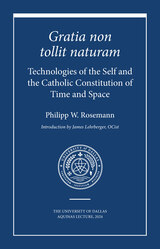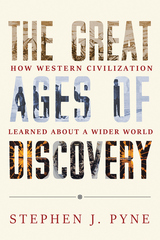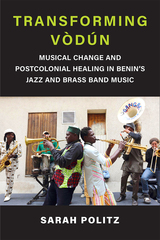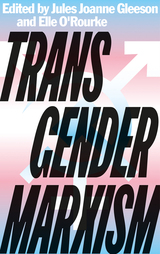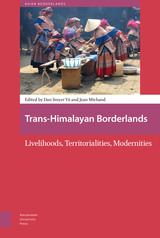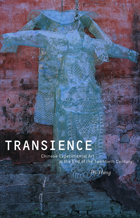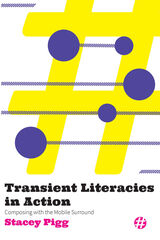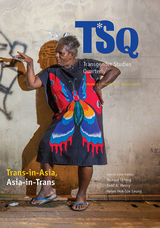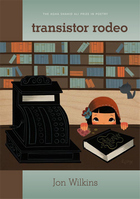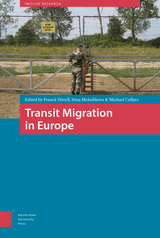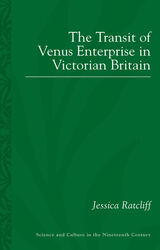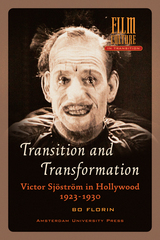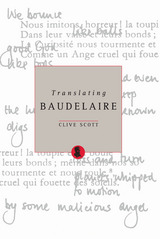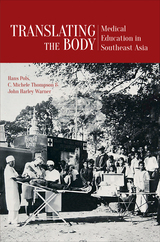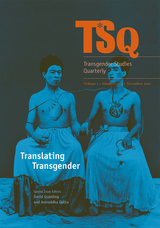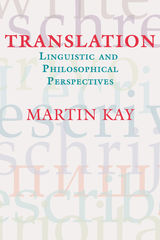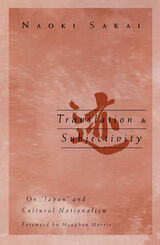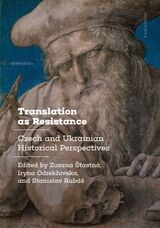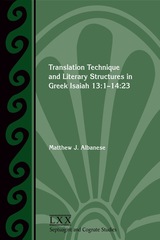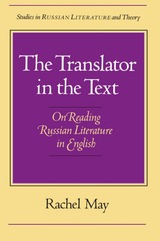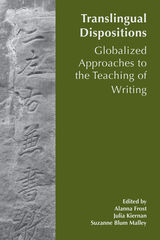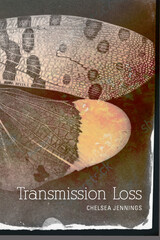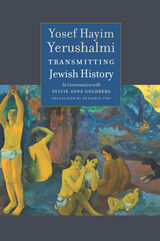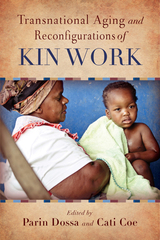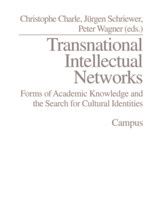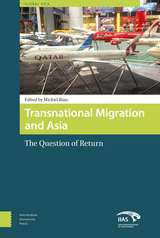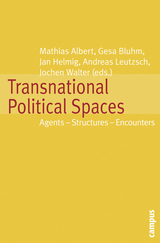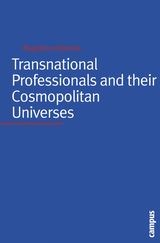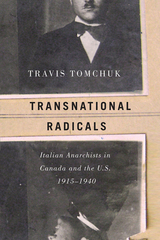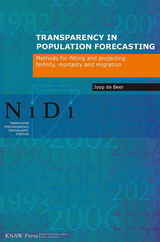Transforming Tradition: Folk Music Revivals Examined
Edited by Neil V. Rosenberg: Foreword by Alan Jabbour
University of Illinois Press, 1993 Transforming Tradition examines the phenomenon of the folk song revival, those vibrant meldings of popular and folk culture that captured public awareness in the 1950s and 1960s. We remember the folk revival as forums for performers like Joan Baez and the Kingston Trio, and as incubators for unlikely radio hits like "Tom Dooley" and "Blowin' in the Wind." But it also gave rise to a bustling and influential subculture of hootenanies, coffeehouses, and blues and bluegrass appreciation, sowing a legacy that remains a vital part of American culture. Many of the contributors to this collection performed during the revival era. Today, their expertise in folklore, ethnomusicology, and cultural history allow them to blend insider knowledge and trained analysis to offer unique perspectives.
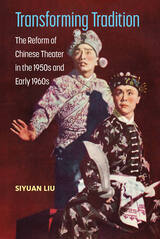 Transforming Tradition: The Reform of Chinese Theater in the 1950s and Early 1960s
Siyuan Liu
University of Michigan Press, 2021 Shortly after the establishment of the People’s Republic of China in 1949, the PRC launched a reform campaign that targeted traditional song and dance theater encompassing more than a hundred genres, collectively known as xiqu. Reformers censored or revised xiqu plays and techniques; reorganized star-based private troupes; reassigned the power to create plays from star actors to the newly created functions of playwright, director, and composer; and eliminated market-oriented functionaries such as agents. While the repertoire censorship ended in the 1980s, major reform elements have remained: many traditional scripts (or parts of them) are no longer in performance; actors whose physical memory of repertoire and acting techniques had been the center of play creation, have been superseded by directors, playwrights, and composers. The net result is significantly diminished repertoires and performance techniques, and the absence of star actors capable of creating their own performance styles through new signature plays that had traditionally been one of the hallmarks of a performance school. Transforming Tradition offers a systematic study of the effects of the comprehensive reform of traditional theater conducted in the 1950s and ’60s, and is based on a decade’s worth of exhaustive research of official archival documents, wide-ranging interviews, and contemporaneous publications, most of which have never previously been referenced in scholarly research.
 Transforming U.S. Intelligence
Jennifer E. Sims and Burton Gerber, Editors
Georgetown University Press, 2005 The intelligence failures exposed by the events of 9/11 and the missing weapons of mass destruction in Iraq have made one thing perfectly clear: change is needed in how the U.S. intelligence community operates. Transforming U.S. Intelligence argues that transforming intelligence requires as much a look to the future as to the past and a focus more on the art and practice of intelligence rather than on its bureaucratic arrangements. In fact, while the recent restructuring, including the creation of the Department of Homeland Security, may solve some problems, it has also created new ones. The authors of this volume agree that transforming policies and practices will be the most effective way to tackle future challenges facing the nation's security. This volume's contributors, who have served in intelligence agencies, the Departments of State or Defense, and the staffs of congressional oversight committees, bring their experience as insiders to bear in thoughtful and thought-provoking essays that address what such an overhaul of the system will require. In the first section, contributors discuss twenty-first-century security challenges and how the intelligence community can successfully defend U.S. national interests. The second section focuses on new technologies and modified policies that can increase the effectiveness of intelligence gathering and analysis. Finally, contributors consider management procedures that ensure the implementation of enhanced capabilities in practice. Transforming U.S. Intelligence supports the mandate of the new director of national intelligence by offering both careful analysis of existing strengths and weaknesses in U.S. intelligence and specific recommendations on how to fix its problems without harming its strengths. These recommendations, based on intimate knowledge of the way U.S. intelligence actually works, include suggestions for the creative mixing of technologies with new missions to bring about the transformation of U.S. intelligence without incurring unnecessary harm or expense. The goal is the creation of an intelligence community that can rapidly respond to developments in international politics, such as the emergence of nimble terrorist networks while reconciling national security requirements with the rights and liberties of American citizens.
Transforming Vòdún: Musical Change and Postcolonial Healing in Benin's Jazz and Brass Band Music
Sarah Politz
University of Michigan Press, 2023 Transforming Vòdún examines how musicians from the West African Republic of Benin transform Benin’s cultural traditions, especially the ancestral spiritual practice of vòdún and its musical repertoires, as part of the process of healing postcolonial trauma through music and ritual. Based on fieldwork in Benin, France, and New York City, Sarah Politz uses historical ethnography, music analysis, and participant observation to examine three case studies of brass band and jazz musicians from Benin. The multi-sited nature of this study highlights the importance of mobility, and diasporic connections in musicians’ professional lives, while grounding these connections in the particularities of the African continent, its histories, its people, and its present.
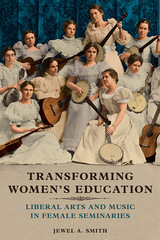 Transforming Women's Education: Liberal Arts and Music in Female Seminaries
Jewel A. Smith
University of Illinois Press, 2019 Female seminaries in nineteenth-century America offered middle-class women the rare privilege of training in music and the liberal arts. A music background in particular provided the foundation for a teaching career, one of the few paths open to women. Jewel A. Smith opens the doors of four female seminaries, revealing a milieu where rigorous training focused on music as an artistic pursuit rather than a social skill. Drawing on previously untapped archives, Smith charts women's musical experiences and training as well as the curricula and instruction available to them, the repertoire they mastered, and the philosophies undergirding their education. She also examines the complex tensions between the ideals of a young democracy and a deeply gendered system of education and professional advancement. An in-depth study of female seminaries as major institutions of learning, Transforming Women's Education illuminates how musical training added to women's lives and how their artistic acumen contributed to American society.
 Transforming Work: Early Modern Pastoral and Late Medieval Poetry
Katherine C. Little
University of Notre Dame Press, 2013 Pastoral poetry has long been considered a signature Renaissance mode: originating in late sixteenth-century England via a rediscovery of classical texts, it is concerned with self-fashioning and celebrating the court. But, as Katherine C. Little demonstrates in Transforming Work: Early Modern Pastoral and Medieval Poetry, the pastoral mode is in fact indebted to medieval representations of rural labor.
Little offers a new literary history for the pastoral, arguing that the authors of the first English pastorals used rural laborers familiar from medieval texts—plowmen and shepherds—to reflect on the social, economic, and religious disruptions of the sixteenth century. In medieval writing, these figures were particularly associated with the reform of the individual and the social world: their work also stood for the penance and good works required of Christians, the care of the flock required of priests, and the obligations of all people to work within their social class. By the sixteenth century, this reformism had taken on a dangerous set of associations—with radical Protestantism, peasants' revolts, and complaints about agrarian capitalism. Pastoral poetry rewrites and empties out this radical potential, making the countryside safe to write about again.
Moving from William Langland’s Piers Plowman and the medieval shepherd plays, through the Piers Plowman–tradition, to Edmund Spenser’s pastorals, Little’s reconstructed literary genealogy discovers the “other” past of pastoral in the medieval and Reformation traditions of “writing rural labor.”
"Transforming Work is an exciting, perceptive, and innovative monograph which shows how poetry from the fourteenth to the sixteenth centuries represented work and labour. In doing so the book poses a serious challenge to prevailing orthodoxies, establishing a courteous dialogue with literary texts and literary critics. Katherine Little shows herself throughout to be an adept and alert reader, committed to revealing what has remained hidden for far too long, our understanding of the relationship between the major literary works of Langland, Googe, Barclay, and Spenser, the literary traditions to which their work belonged, and the reality of work in medieval and early modern England." —Andrew Hadfield, University of Sussex
"This book comes after many other studies of the continuity of the classical pastoral tradition in England, and corrects a general tendency to neglect the medieval influences on the development of the tradition. I found the study as a whole immensely stimulating." —Derek Pearsall, University of York
"Katherine C. Little's elegant and fluidly written book offers a necessary corrective to a generic narrative that usually occludes the medieval period's contributions to pastoral. As such, her work is a welcome addition, since it both revises the Renaissance literary map and offers new contexts for reading familiar late medieval texts as part of this larger tradition." —Kellie Robertson, University of Maryland
 Transforming Young Adult Services
Anthony Bernier
American Library Association, 2019 Foreword by John M. Budd; with contributions from Denise E. Agosto, Jeanie Austin, Michael Cart, Mary K. Chelton, Karen Coats, Kate McDowell, Cherie Givens, Mary Ann Harlan, Kafi D. Kumasi, Wendy Schaetzel Lesko, Mike Males, Paulette Rothbauer, Lucia Cedeira Serantes How should LIS envision its young adult users? Now showcasing an even more rigorous debate about the theory and practice of YA librarianship than its first edition, this "provocative presentation of diverse viewpoints by leaders in the field" (Catholic Library World) has been updated and expanded to incorporate recent advances in critical youth studies. A comprehensive, evidence-based treatment that offers LIS instructors, students, and practitioners a valuable tool for aligning YA services to more fully reflect our diverse populations of young people, this collection delves deeply into such topics as - the historical roots for current theories and practice;
- how intellectual freedom, storytelling, library collections, and other service topics can connect with the library's notion and vision of young adults;
- diverse YA identities, including critical race theory;
- competing perspectives on young adults’ rights in libraries;
- envisaging YA librarianship from a teen-centered perspective;
- youth identities and the school library; and
- moving beyond coaching to copilot with young adults.
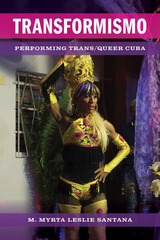 Transformismo: Performing Trans/Queer Cuba
M. Myrta Leslie Santana
University of Michigan Press, 2025 In Transformismo, M. Myrta Leslie Santana draws on years of embedded research within Cuban trans/queer communities to analyze how transformistas, or drag performers, understand their roles in the social transformation of the island. Once banned and censored in Cuba, drag performance is now a state-sponsored event. Transformismo suggests that these performances make critical interventions in Cuban trans/queer life and politics and in doing so, the volume offers critical insight into how Cuba’s postsocialist reform has exacerbated racial, sexual, and economic inequalities. Leslie Santana argues that mainstream trans/queer nightlife in Cuba is entangled with the island’s tourism economy and has shaped the aesthetics and social makeup of transformismo in coastal Havana, which largely caters to foreigners. Leslie Santana considers how Black lesbian and transgender transformistas are expanding understandings of sexual selfhood and politics on the island, particularly questioning the ways that Black women’s creativity is prominently featured in the aesthetics of tourism and trans/queer nightlife, while Black women themselves are denied social and material capital.
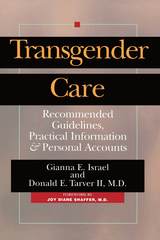 Transgender Care: Recom Guidelines, Practical Info
Gianna Israel
Temple University Press, 2001 By empowering clients to be well-informed medical consumers and by delivering care providers from the straitjacket of inadequate diagnostic standards and stereotypes, this book sets out to transform the nature of transgender care.
In an accessible style, the authors discuss the key mental health issues, with much attention to the vexed relationship between professionals and clients. They propose a new professional role; that of "Gender Specialist."
Chapters 3, 4, and 5 provide definitive information (in the context of consulting health professionals) on hormone administration, aesthetic surgery, and genital reassignment surgery. Chapter 6 takes up the little-examined issue of HIV and AIDS among transgender people. There is also a chapter devoted to issues of transgender people of color, as well as a chapter on transgender adolescents.
The book contains a wealth of practical information and accounts of people's experiences about coming out to one's employer or to one's friends or spouse. Several essays spell out the legal rights of transgender people with regard to insurance, work, marriage, and the use of rest rooms.
The second part of the book consists of thirteen essays on a range of controversial topics. They include three personal stories of transgender life, one essay on the new academic field of Transgender Studies, two essays on legal rights, three essays on medical issues, and two essays on the origins and possible resolution of the conflicts between therapist and client. The authors have also provided useful listings of organizations, centers, and Web sites.
The book has been reviewed by a national committee of professionals and consumers, some of whose members have contributed the essays in the second part of the book.
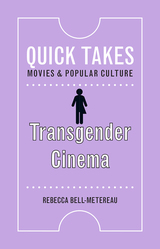 Transgender Cinema
Rebecca Bell-Metereau
Rutgers University Press, 2019 2019 Choice Outstanding Academic Title Transgender Cinema gives readers the big picture of how trans people have been depicted on screen. Beginning with a history of trans tropes in classic Hollywood cinema, from comic drag scenes in Chaplin’s The Masquerader to Garbo’s androgynous Queen Christina, and from psycho killer queers to The Rocky Horror Picture Show’s outrageous queen, it examines a plethora of trans portrayals that subsequently emerged from varied media outlets, including documentary films, television serials, and world cinema. Along the way, it analyzes milestones in trans representation, like The Crying Game, Boys Don’t Cry, Hedwig and the Angry Inch,and A Fantastic Woman. As it traces the evolution of trans people onscreen, Transgender Cinema also considers the ongoing controversies sparked by these movies and series both within LGBTQ communities and beyond. Ultimately it reveals how film and television have shaped not only how the general public sees trans people, but also how trans people see themselves. Selected Filmography: Adventures of Priscilla, Queen of the Desert, All about My Mother, Anak, Austin Unbound, Becoming Chaz, The Blossoming of Maximo Oliveros, Boy I Am, Boy Meets Girl, Boys Don’t Cry, The Brandon Teena Story, A Busy Day, Call Me Malcolm, Carlotta, Change over Time, The Crying Game, Dallas Buyers Club, The Danish Gir, The Devil Is a Woman, Drunktown’s Finest, Facing Mirrors, A Fantastic Woman, 52 Tuesdays, Flesh, Girl Inside, A Girl like Me: The Gwen Araujo Story, Hedwig and the Angry Inch, I Was a Male War Bride,Kate Bornstein Is a Queer and Pleasant Danger, Kumu Hina, La Cage aux Folles, Ma Vie en Rose (My Life in Pink) The Masquerader, Myra Breckinridge, Orlando, Paris Is Burning, Playing with Gender, Psycho, Queen Christina, The Rocky Horror Picture Show, The Saga of Anatahan, She’s a Boy I Knew, Silence of the Lambs, Some Like It Hot, Southern Comfort, Still Black: A Portrait of Black Transmen, Stonewall, The Tenant, Three Generations. Tomboy, Tootsie, Transamerica, Transparent, Trash, Whatever Suits You, A Woman.
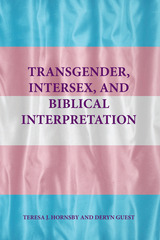 Transgender, Intersex, and Biblical Interpretation
Teresa Hornsby
SBL Press, 2016 A call for “trans literacy” within biblical scholarship
In this volume Hornsby and Guest introduce readers to terms for the various identities of trans people and how the Bible can be an affirmation of those deemed sexually other by communities. This book offers readings of well known (e.g., Gen 1; Revelation) and not so well known (2 Sam 6; Jer 38) narratives to illustrate that the Bible has been translated and interpreted with a bias that makes heterosexuality and a two sex, two gender system natural, and thus divinely ordained. The authors present examples that show gender was never a binary, and in the Bible gender and sex are always dynamic categories that do, and must, transition.
Features:
Definitions of key terms, including transsexual, transgender, cissexism, heterosexism, intersex, eunuch
Critique of how biblical texts are used in Christian positional statements on transsexuality
Statistics concerning rates of violence against trans persons
 The Transgender Issue, Volume 4
Susan Stryker
Duke University Press This special issue of GLQ: A Journal of Lesbian and Gay Studies presents essays that each adopt a methodologically distinctive analysis of a particular concern in transgender studies. Taken together, these pieces demonstrate the wide-ranging and sometimes antagonistic viewpoints of scholars and activists pursuing different political and intellectual goals. Essays include a documentation of how readers of mass-circulation print media became aware of new medical possibilities for the surgical and hormonal alteration of sex characteristics and began agitating for them; a challenge from feminist theorists to transgender movement activists to avoid repeating the mistakes of previous feminist, gay, and lesbian political mobilizations; a critique of the overreliance on discursive analysis in much current transgender scholarship; and paired essays exploring the so-called Butch/FTM Border Wars from either side of that divide. There are also pieces that focus on intersex activism, the bioethics of gender dysphoria management, and the mobilization of transgender advocacy organizations.
Considering perceptions of queer embodiment past and present, these essays explore the sweeping changes in professional and popular attitudes regarding the transgender community and the issues that affect it. The timeliness of this issue as well as the diversity of its viewpoints makes it a significant contribution to the growing body of transgender literature. Contributors. Cheryl Chase, Patricia Elliot, Judith Halberstam, C. Jacob Hale, Joanne Meyerowitz, James Lindeman Nelson, Katrina Roen, Henry Rubin, Susan Stryker
Transgender Marxism
Jules Joanne Gleeson
Pluto Press, 2021 The first collection of its kind, Transgender Marxism is a provocative and groundbreaking union of transgender studies and Marxist theory.
Exploring trans lives and movements, the authors delve into the experience of surviving as transgender under capitalism. They explore the pressures, oppression and state persecution faced by trans people living in capitalist societies, their tenuous positions in the workplace and the home, and give a powerful response to right-wing scaremongering against 'gender ideology'.
Reflecting on the relations between gender and labour, these essays reveal the structure of antagonisms faced by gender non-conforming people within society. Looking at the history of transgender movements, Marxist interventions into developmental theory, psychoanalysis and workplace ethnography, the authors conclude that for trans liberation, capitalism must be abolished.
Transgender Nation
Gordene Olga MacKenzie
University of Wisconsin Press, 1994 In the United States we are bombarded with gender propaganda that supports a repressive dual gender system pitting the genders against each other. Transgenderists as gender nonconformists challenge us to rethink traditional discourses on sex and gender. Transgender Nation investigates the male-to-woman transgenderist and transsexual from a sociocultural and sociopolitical perspective maintaining that it is not the individual transgenderist who is sick and in need of treatment but rather the culture that must be treated.
 Transgender Rights
Paisley Currah
University of Minnesota Press, 2006 "Transgender Rights packs a surprising amount of information into a small space. Offering spare, tightly executed essays, this slim volume nonetheless succeeds in creating a spectacular, well-researched compendium of the transgender movement." -Law Library Journal
Over the past three decades, the transgender movement has gained visibility and achieved significant victories. Discrimination has been prohibited in several states, dozens of municipalities, and more than two hundred private companies, while hate crime laws in eight states have been amended to include gender identity. Yet prejudice and violence against transgender people remain all too common.
With analysis from legal and policy experts, activists and advocates, Transgender Rights assesses the movement’s achievements, challenges, and opportunities for future action. Examining crucial topics like family law, employment policies, public health, economics, and grassroots organizing, this groundbreaking book is an indispensable resource in the fight for the freedom and equality of those who cross gender boundaries. Moving beyond media representations to grapple with the real lives and issues of transgender people, Transgender Rights will launch a new moment for human rights activism in America.
Contributors: Kylar W. Broadus, Judith Butler, Mauro Cabral, Dallas Denny, Taylor Flynn, Phyllis Randolph Frye, Julie A. Greenberg, Morgan Holmes, Bennett H. Klein, Jennifer L. Levi, Ruthann Robson, Nohemy Solórzano-Thompson, Dean Spade, Kendall Thomas, Paula Viturro, Willy Wilkinson.
Paisley Currah is associate professor of political science at Brooklyn College, executive director of the Center for Lesbian and Gay Studies at the CUNY Graduate Center, and a founding board member of the Transgender Law and Policy Institute.
Richard M. Juang cochairs the advisory board of the National Center for Transgender Equality (NCTE) in Washington, DC. He has taught at Oberlin College and Susquehanna University. He is the lead editor of NCTE's Responding to Hate Crimes: A Community Resource Manual and coeditor of Transgender Justice, which explores models of activism.
Shannon Price Minter is legal director of the National Center for Lesbian Rights and a founding board member of the Transgender Law and Policy Institute.
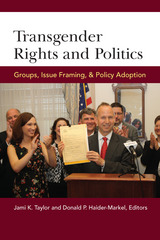 Transgender Rights and Politics: Groups, Issue Framing, and Policy Adoption
Jami K. Taylor and Donald P. Haider-Markel, Editors
University of Michigan Press, 2015 To date, media and scholarly attention to gay politics and policy has focused on the morality debates over sexual orientation and the legal aspects of rights for non-heterosexuals. However, transgender concerns as such have received little attention. With transgender activism becoming more visible, policymakers in the United States and around the world have begun to respond to demands for more equitable treatment. Jami K. Taylor and Donald P. Haider-Markel bring together new research employing the concepts and tools of political science to explore the politics of transgender rights. Volume contributors address the framing of transgender rights in the U.S. and in Latin America. They discuss transgender interest groups, the inclusion of transgender activists in advocacy coalitions, policy diffusion at the state and local levels, and, importantly, the implementation of transgender public policy. This volume sets the standard for empirical research on transgender politics and demonstrates that the study of this topic can contribute to the understanding of larger questions in the field of political science.
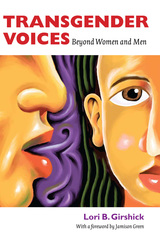 Transgender Voices: Beyond Women and Men
Lori B. Girshick
University Press of New England, 2009 In this extraordinary book, based on 150 in-depth interviews, Lori B. Girshick, a sociologist and social justice activist, brings together the voices of sex- and gender-diverse people who speak with absolute candor about their lives. Girshick presents transpeople speaking in their own voices about identity, coming out, passing, sexual orientation, relationship negotiations and the dynamics of attraction, homophobia (including internalized fears), and bullying. She exposes the guilt and the shame that “gender police” use in their attempts to exert control and points out the many ways transpeople are discriminated against in daily life, from filling out identification documents to gender-segregated bathrooms. By showing us a variety of descriptions of diverse real lives and providing a thorough exploration of the embodied experiences of gender variant people, Girshick demonstrates that there is nothing inherently binary about gender, and that the way each of us experiences our own gender is, in fact, normal and natural.
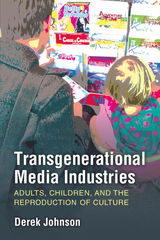 Transgenerational Media Industries: Adults, Children, and the Reproduction of Culture
Derek Johnson
University of Michigan Press, 2019 Within corporate media industries, adults produce children’s entertainment. Yet children, presumed to exist outside the professional adult world, make their own contributions to it—creating and posting unboxing videos, for example, that provide content for toy marketers. Many adults, meanwhile, avidly consume entertainment products nominally meant for children. Media industries reincorporate this market-disrupting participation into their strategies, even turning to adult consumers to pass fandom to the next generation.
Derek Johnson presents an innovative perspective that looks beyond the simple category of “kids’ media” to consider how entertainment industry strategies invite producers and consumers alike to cross boundaries between adulthood and childhood, professional and amateur, new media and old. Revealing the social norms, reproductive ideals, and labor hierarchies on which such transformations depend, he identifies the lines of authority and power around which legacy media institutions like television, comics, and toys imagine their futures in a digital age. Johnson proposes that it is not strategies of media production, but of media reproduction, that are most essential in this context. To understand these critical intersections, he investigates transgenerational industry practice in television co-viewing, recruitment of adult comic readers as youth outreach ambassadors, media professionals’ identification with childhood, the branded management of adult fans of LEGO, and the labor of child YouTube video creators. These dynamic relationships may appear to disrupt generational and industry boundaries alike. However, by considering who media industries empower when generating the future in these reproductive terms and who they leave out, Johnson ultimately demonstrates how their strategies reinforce existing power structures.
This book makes vital contributions to media studies in its fresh approach to the intersections of adulthood and childhood, its attention to the relationship between legacy and digital media industries, and its advancement of dialogue between media production and consumption researchers. It will interest scholars in media industry studies and across media studies more broadly, with particular appeal to those concerned about the current and future reach of media industries into our lives.
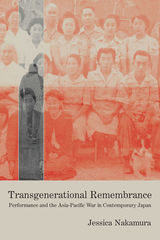 Transgenerational Remembrance: Performance and the Asia-Pacific War in Contemporary Japan
Jessica Nakamura
Northwestern University Press, 2020 In Transgenerational Remembrance, Jessica Nakamura investigates the role of artistic production in the commemoration and memorialization of the Asia-Pacific War (1931–1945) in Japan since 1989. During this time, survivors of Japanese aggression and imperialism, previously silent about their experiences, have sparked contentious public debates about the form and content of war memories.
The book opens with an analysis of the performance of space at Yasukuni Shinto Shrine, which continues to promote an anachronistic veneration of the war. After identifying the centrality of performance in long-standing dominant narratives, Transgenerational Remembrance offers close readings of artistic performances that tackle subject matter largely obscured before 1989: the kamikaze pilot, Japanese imperialism, comfort women, the Battle of Okinawa, and Japanese American internment. These case studies range from Hirata Oriza’s play series about Japanese colonial settlers in Korea and Shimada Yoshiko’s durational performance about comfort women to Kondo Aisuke’s videos and gallery installations about Japanese American internment.
Working from theoretical frameworks of haunting and ethics, Nakamura develops an analytical lens based on the Noh theater ghost. Noh emphasizes the agency of the ghost and the dialogue between the dead and the living. Integrating her Noh-inflected analysis into ethical and transnational feminist queries, Nakamura shows that performances move remembrance beyond current evidentiary and historiographical debates.
Transglobal Fashion Narratives: Clothing Communication, Style Statements and Brand Storytelling
Edited by Anne Peirson-Smith and Joeseph H. Hancock II
Intellect Books, 2018 Everywhere we look, people are using fashion to communicate self and society—who they are, and where they belong. Transglobal Fashion Narratives presents an international, interdisciplinary analysis of those narratives. Moving from sweatshop to runway, page to screen, camera to blog, and artist to audience, the book examines fashion as a mediated form of content in branding, as a literary and filmic device, and as a personal form of expression by industry professionals, journalists, and bloggers.
Trans-Global Punk Scenes: The Punk Reader Volume 2
Edited by Russ Bestley, Mike Dines, Alastair "Gords" Gordon, and Paula Guerra
Intellect Books, 2021 While the punk scenes and subcultures of the late 1970s and early 1980s are well known and well documented, the proliferation of punk after the year 2000 has been far less studied. Picking up where The Punk Reader left off, Trans-Global Punk Scenes examines the global influence of punk in the new millennium, with a focus on punk demographics, the evolution of subcultural punk styles, and the notion of punk identity across cultural and geographic boundaries.
International in scope and analytical in perspective, the chapters offer insight into the dissemination of punk scenes and their form, structure, and contemporary cultural significance in New Zealand, Indonesia, Singapore, Ireland, South Africa, Mexico, the UK, the US, Siberia, and the Philippines.
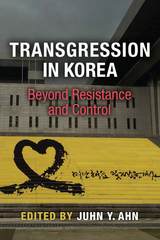 Transgression in Korea: Beyond Resistance and Control
Edited by Juhn Ahn
University of Michigan Press, 2018 Since the turn of the millennium South Korea has continued to grapple with transgressions that shook the nation to its core. Following the serial killings of Korea’s raincoat killer, the events that led to the dissolution of the United Progressive Party, the criminal negligence of the owner and also the crew members of the sunken Sewol Ferry, as well as the political scandals of 2016, there has been much public debate about morality, transparency, and the law in South Korea. Yet, despite its prevalence in public discourse, transgression in Korea has not received proper scholarly attention.
Transgression in Korea challenges the popular conceptions of transgression as resistance to authority, the collapse of morality, and an attempt at self- empowerment. Examples of transgression from premodern, modern, and contemporary Korea are examined side by side to underscore the possibility of reading transgression in more ways than one. These examples are taken from a devotional screen from medieval Korea, trickster tales from the late Chosŏn period, reports about flesheating humans, newspaper articles about same- sex relationships from colonial Korea, and films about extramarital affairs, wayward youths, and a vengeful vigilante. Bringing together specialists from various disciplines such as history, art history, anthropology, premodern
literature, religion, and fi lm studies, the context- sensitive readings of transgression provided in this book suggest that transgression and authority can be seen as forming something other than an antagonistic relationship.
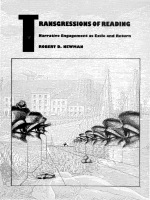 Transgressions of Reading: Narrative Engagement as Exile and Return
Robert D. Newman
Duke University Press, 1992 It is often claimed that we know ourselves and the world through narratives. In this book, Robert D. Newman portrays narrative engagement as a process grounded in psychoanalytic theory to explain how readers (or listeners or viewers) manage to engage with specific narratives and derive from them a personal experience.
Newman describes this psychodrama of narrative engagement as that of exile and return, an experience in which narrative becomes a type of homeland, beckoning and elusive, endlessly defining and disrupting the borders of a reader's identity. Within this paradigm, he considers a fascinating variety of narrative texts: from the Jim Jones episode in Guyana to Freud's repression of personal history in his story of Moses; from a surrealistic collage novel by Max Ernst to the horror films of Alfred Hitchcock; from the works of James Joyce, Ariel Dorfman, Milan Kundera, and D. M. Thomas to the tales of abjection in pornography.
Transgressions of Reading is itself an engaging work, as interesting for its provocative readings of particular works as for its theoretical insights. It will appeal to readers from all fields in which narrative plays a crucial role, in the study of film and art, modern and contemporary literature, popular culture, and feminist, psychoanalytic, and reader response theory.
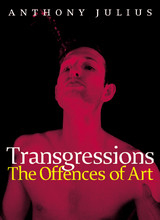 Transgressions: The Offences of Art
Anthony Julius
University of Chicago Press, 2002 Since the mid-nineteenth century, artists have compulsively rejected received ideas in order to test and subvert morality, law, society, and even art itself. But what happens when all boundaries have been crossed, all taboos broken, all limits violated?
Transgressions is the first book to address this controversial subject. Here Anthony Julius traces the history of subversion in art from the outraged response to Manet's Le Déjeuner sur l'Herbe to the scandal caused by the grant programs of the National Endowment for the Arts a century and a half later. Throughout the book, and supported by the work of such artists as Marcel Duchamp, the Chapman brothers, Andres Serrano, Damien Hirst, Gilbert & George, Paul McCarthy, Jeff Koons, Hans Haacke, and Anselm Kiefer, Julius shows how the modern period has been characterized by three kinds of transgressive art: an art that perverts established art rules; an art that defiles the beliefs and sentiments of its audience; and an art that challenges and disobeys the rules of the state.
The evidence assembled, Julius concludes his hard-hitting dissection of the landscapes of contemporary art by posing some important questions: what is art's future when its boundary-exceeding, taboo-breaking endeavors become the norm? And is anything of value lost when we submit to art's violation?
Transgressions is not a comfortable—still less a comforting—read, but it has a powerful urgency that makes it an essential document for anyone involved in our cultural life at the beginning of the twenty-first century.
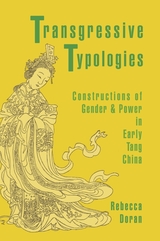 Transgressive Typologies: Constructions of Gender and Power in Early Tang China
Rebecca Doran
Harvard University Press, 2016 The exceptionally powerful Chinese women leaders of the late seventh and early eighth centuries—including Wu Zhao, the Taiping and Anle princesses, Empress Wei, and Shangguan Wan’er—though quite prominent in the Chinese cultural tradition, remain elusive and often misunderstood or essentialized throughout history. Transgressive Typologies utilizes a new, multidisciplinary approach to understand how these figures’ historical identities are constructed in the mainstream secular literary-historical tradition and to analyze the points of view that inform these constructions.
Using close readings and rereadings of primary texts written in medieval China through later imperial times, this study elucidates narrative typologies and motifs associated with these women to explore how their power is rhetorically framed, gendered, and ultimately deemed transgressive. Rebecca Doran offers a new understanding of major female figures of the Tang era within their literary-historical contexts, and delves into critical questions about the relationship between Chinese historiography, reception-history, and the process of image-making and cultural construction.
Trans-Himalayan Borderlands: Livelihoods, Territorialities, Modernities
Edited by Dan Smyer Yü and Jean Michaud
Amsterdam University Press, 2017 The societies in the Himalayan borderlands have undergone wide-ranging transformations, as the territorial reconfiguration of modern nation-states since the mid-twentieth century and the presently increasing trans-Himalayan movements of people, goods and capital, reshape the livelihoods of communities, pulling them into global trends of modernisation and regional discourses of national belonging.This book explores the changes to native senses of place, the conception of border - simultaneously as limitations and opportunities - and what the authors call "affective boundaries," "livelihood reconstruction," and "trans-Himalayan modernities." It addresses changing social, political, and environmental conditions that acknowledge growing external connectivity even as it emphasises the importance of place.
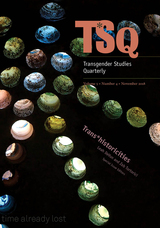 Trans*historicities
Leah DeVun and Zeb Tortorici, special issue editors
Duke University Press, 2018 This issue offers a theoretical and methodological imagining of what constitutes trans* before the advent of the terms that scholars generally look to for the formation of modern conceptions of gender, sex, and sexuality. What might we find if we look for trans* before trans*? While some historians have rejected the category of transgender to speak of experiences before the mid-twentieth century, others have laid claim to those living gender-non-conforming lives before our contemporary era. By using the concept of trans*historicity, this volume draws together trans* studies, historical inquiry, and queer temporality while also emphasizing the historical specificity and variability of gendered systems of embodiment in different time periods. Essay topics include a queer analysis of medieval European saints, discussions of a nineteenth-century Russian religious sect, an exploration of a third gender in early modern Japanese art, a reclamation of Ojibwe and Plains Cree Two-Spirit language, and biopolitical genealogies and filmic representations of transsexuality. The issue also features a roundtable discussion on trans*historicities and an interview with the creators of the 2015 film Deseos. Critiquing both progressive teleologies and the idea of sex or gender as a timeless tradition, this issue articulates our own desires for trans history, trans*historicities, and queerly temporal forms of historical narration.
Contributors. Kadji Amin, M. W. Bychowski, Fernanda Carvajal, Howard Chiang, Leah DeVun, Julian Gill-Peterson, Jack Halberstam, Asato Ikeda, Jacob Lau, Kathleen P. Long, Maya Mikdashi, Robert Mills, Carlos Motta, Marcia Ochoa, Kai Pyle, C. Riley Snorton, Zeb Tortorici, Jennifer Louise Wilson
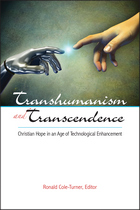 Transhumanism and Transcendence: Christian Hope in an Age of Technological Enhancement
Ronald Cole-Turner, Editor
Georgetown University Press, 2013 The timeless human desire to be more beautiful, intelligent, healthy, athletic, or young has given rise in our time to technologies of human enhancement. Athletes use drugs to increase their strength or stamina; cosmetic surgery is widely used to improve physical appearance; millions of men take drugs like Viagra to enhance sexual performance. And today researchers are exploring technologies such as cell regeneration and implantable devices that interact directly with the brain. Some condemn these developments as a new kind of cheating—not just in sports but in life itself—promising rewards without effort and depriving us most of all of what it means to be authentic human beings. “Transhumanists,” on the other hand, reject what they see as a rationalizing of human limits, as if being human means being content forever with underachieving bodies and brains. To be human, they insist, is to be restless with possibilities, always eager to transcend biological limits. As the debate grows in urgency, how should theology respond? Christian theologians recognize truth on both sides of the argument, pointing out how the yearnings of the transhumanists—if not their technological methods—find deep affinities in Christian belief. In this volume, Ronald Cole-Turner has joined seasoned scholars and younger, emerging voices together to bring fresh insight into the technologies that are already reshaping the future of Christian life and hope.
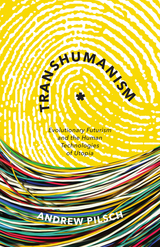 Transhumanism: Evolutionary Futurism and the Human Technologies of Utopia
Andrew Pilsch
University of Minnesota Press, 2017 Transhumanism posits that humanity is on the verge of rapid evolutionary change as a result of emerging technologies and increased global consciousness. However, this insight is dismissed as a naive and controversial reframing of posthumanist thought, having also been vilified as “the most dangerous idea in the world” by Francis Fukuyama. In this book, Andrew Pilsch counters these critiques, arguing instead that transhumanism’s utopian rhetoric actively imagines radical new futures for the species and its habitat. Pilsch situates contemporary transhumanism within the longer history of a rhetorical mode he calls “evolutionary futurism” that unifies diverse texts, philosophies, and theories of science and technology that anticipate a radical explosion in humanity’s cognitive, physical, and cultural potentialities. By conceptualizing transhumanism as a rhetoric, as opposed to an obscure group of fringe figures, he explores the intersection of three major paradigms shaping contemporary Western intellectual life: cybernetics, evolutionary biology, and spiritualism. In analyzing this collision, his work traces the belief in a digital, evolutionary, and collective future through a broad range of texts written by theologians and mystics, biologists and computer scientists, political philosophers and economic thinkers, conceptual artists and Golden Age science fiction writers. Unearthing the long history of evolutionary futurism, Pilsch concludes, allows us to more clearly see the novel contributions that transhumanism offers for escaping our current geopolitical bind by inspiring radical utopian thought.
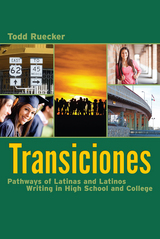 Transiciones: Pathways of Latinas and Latinos Writing in High School and College
Todd Ruecker
Utah State University Press, 2015 Transiciones is a thorough ethnography of seven Latino students in transition between high school and community college or university. Data gathered over two years of interviews with the students, their high school English teachers, and their writing teachers and administrators at postsecondary institutions reveal a rich picture of the conflicted experience of these students as they attempted to balance the demands of schooling with a variety of personal responsibilities.
Todd Ruecker explores the disconnect between students’ writing experiences in high school and higher education and examines the integral role that writing plays in college. Considering the almost universal requirement that students take a writing class in their critical first year of college, he contends that it is essential for composition researchers and teachers to gain a fuller understanding of the role they play in supporting and hindering Latina and Latino students’ transition to college.
Arguing for situating writing programs in larger discussions of high school/college alignment, student engagement, and retention, Transiciones raises the profile of what writing programs can do while calling composition teachers, administrators, and scholars to engage in more collaboration across the institution, across institutions, and across disciplines to make the transition from high school to college writing more successful for this important group of students.
Transience: Chinese Experimental Art at the End of the Twentieth Century
Wu Hung
University of Chicago Press, 2006 In a groundbreaking approach to avant-garde Chinese art, the 1999 exhibition "Transience: Chinese Experimental Art at the End of the Twentieth Century" established a historical framework for current artistic production in China. Organized by the David and Alfred Smart Museum of Art at the University of Chicago, the show and its catalog highlighted the diverse responses of twenty-two artists to Chinas recent history and current social transformation.
These detailed essays on the artists and their works are now available in a revised edition of the exhibition catalog. Written by Wu Hung, a leading authority and the curator of the exhibit, Transience explores contemporary Chinese art through the themes of demystification, ruins, and transience, and represents an original perspective in the continuing discussion on Chinese experimental art.
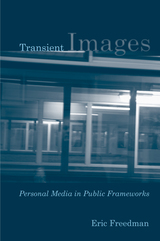 Transient Images: Personal Media in Public Frameworks
Authored by Eric Freedman
Temple University Press, 2010 In this probing study, Eric Freedman focuses on what images from photography, mobile communications, and the Internet reveal about looking. Exploring subjectivity by critically examining the look, he elaborates on the nature of the photographic frame and its relation to interpretive practices. Freedman scrutinizes what he calls "technobiography"—a life written through technology, and considers the movement of personal images into public spaces. He also considers authorship that situates the self as inherently engaged with and inscribed by information technology. All of the chapters in Transient Images explore Freedman's interest in examining how media technologies activate particular notions of self and community. He provides examples that address trauma—pictures of missing children on milk cartons and episodes of the reality series Intervention—as well as the strategies behind creating and distributing personal advertisements on the Internet. Transient Images draws out the tensions that exist in images circulating in the digital era.
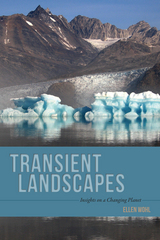 Transient Landscapes: Insights on a Changing Planet
Ellen E. Wohl
University Press of Colorado, 2015 Landscape—the unique combination of landforms, plants, animals, and weather that compose any natural place—is inherently transient. Each essay in Transient Landscapes introduces this idea of a constantly metamorphosing global landscape, revealing how to see the ubiquity of landscape transience, both that which results through Earth’s natural environmental and climatological processes and that which comes from human intervention.
The essays are grouped by type of environmental change: long-term, large-scale transformation driven by geologic forces such as tectonic uplift and volcanism; natural variability at shorter time scales, such as seasonal flooding; and modifications resulting from human activities, such as timber harvest, land drainage, and pollution. Each essay is set in a unique geographic location—including such diverse places as New Zealand, Northern California, Costa Rica, and the Scottish Highlands—and is largely drawn from Wohl’s personal experience researching in the field.
A combination of travel writing, nature writing, and science writing, Transient Landscapes is a beautiful and thoughtful journey through the natural world.
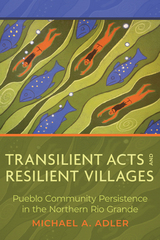 Transilient Acts and Resilient Villages: Pueblo Community Persistence in the Northern Rio Grande
Michael A. Adler
University of Arizona Press, 2026 A powerful rethinking of resilience through the lens of Pueblo history, this work reveals how Tiwa communities in the Northern Rio Grande used culturally intentional strategies to adapt, transform, and endure across a millennium of change. Anthropologist Michael A. Adler introduces the concept of transilience—culturally intentional acts that address existential threats and enable transformation—as a framework for interpreting the long-term persistence of Tiwa communities.
Focusing on the Tiwa-speaking communities of Taos, Picuris, and Pot Creek Pueblos, Adler shows how social and ritual organization, architectural change, and sacred geographies were mobilized in response to disruption. He challenges conventional resilience theory, which emphasizes systemic stability, instead centering Indigenous agency, mobility, and sacred practice as key to understanding cultural endurance.
Grounded in decades of collaborative research with Pueblo communities, Transilient Acts and Resilient Villages is a vital contribution to southwestern archaeology. It offers a compelling model for how archaeology can respectfully engage with descendant communities and provides essential insights for scholars, students, and community members seeking to understand the complexities of cultural persistence in the face of change.
Trans-in-Asia, Asia-in-Trans
Howard Chiang, Todd A. Henry, and Helen Hok-Sze Leung, special issue editors
Duke University Press Since the late twentieth century, scholars and activists have begun to take stock of the deep histories and politically engaged nature of trans* cultures across the diverse societies of “Asia.” Much of this groundbreaking work has cautioned against immediate assumptions about the universality of transgender experiences, while heeding the significant influence of colonial histories, cultural imperialism, Cold War dynamics, economic integration, and migration practices in shaping local categories of queerness, discourses of rights, as well as the political, social, and medical management of gender variance and non-normative sexualities. This growing body of work on Asia joins trans* scholarship and activism across the world that has similarly sought to de-universalize and de-colonize the category of “trans.”
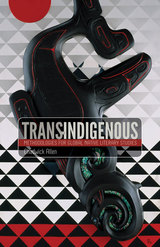 Trans-Indigenous: Methodologies for Global Native Literary Studies
Chadwick Allen
University of Minnesota Press, 2012 What might be gained from reading Native literatures from global rather than exclusively local perspectives of Indigenous struggle? In Trans-Indigenous, Chadwick Allen proposes methodologies for a global Native literary studies based on focused comparisons of diverse texts, contexts, and traditions in order to foreground the richness of Indigenous self-representation and the complexity of Indigenous agency. Through demonstrations of distinct forms of juxtaposition—across historical periods and geographical borders, across tribes and nations, across the Indigenous–settler binary, across genre and media—Allen reclaims aspects of the Indigenous archive from North America, Hawaii, Aotearoa New Zealand, and Australia that have been largely left out of the scholarly conversation. He engages systems of Indigenous aesthetics—such as the pictographic discourse of Plains Indian winter counts, the semiotics of Navajo weaving, and Maori carving traditions, as well as Indigenous technologies like large-scale North American earthworks and Polynesian ocean-voyaging waka—for the interpretation of contemporary Indigenous texts. The result is a provocative reorienting of the call for Native intellectual, artistic, and literary sovereignty that fully prioritizes the global Indigenous.
Transistor Rodeo
Jon Wilkins
University of Utah Press, 2010 The annual Agha Shahid Ali Prize in Poetry was inaugurated in 2003 to honor the late poet, a nationally recognized writer and former professor at the University of Utah, and is sponsored by the University of Utah Press and the University of Utah Department of English. Transistor Rodeo was selected as the 2009 prize-winning volume by judge Ander Monson, poet, essayist, author of The Available World and Vanishing Point, and editor of DIAGRAM.
 Transit Communities and Impact of Migration: Hungary, 2017-2020
Beatrix Futak-Campbell
Central European University Press The impact of the passage of war refugees on the lives and minds of local residents and officials is the subject of this study. Between 2017 and 2020, Beatrix Futak-Campbell conducted interviews with over fifty people who live and work near the Hungarian-Serbian border. This area was exposed to the unprecedented stream of refugees, most of them seeking safety from the Syrian civil war. The Hungarian government’s hostility to migrants has been widely criticized, and news coverage has tended to reiterate unhelpful characterisations of Hungarian citizens as being anti-migrant, anti-Muslim and racist. The situation is, however, more nuanced. There is a substantial difference between the border police, local communities, and organizations, on the one hand, and national politicians and the international media perception of the refugee ‘crisis’, on the other. Those living and working with migrants at the border were caught between the domestic political situation, the plight of the refugees and the international support the latter receive, and the exigencies of their own livelihoods. This book explores these communities and their own security concerns.
 Transit Lit: Fictions of Migration in Twenty-First-Century African Immigrant Literature
Cameron Leader-Picone
Northwestern University Press, 2026 Explores new forms of cosmopolitan identity constructed in contemporary diasporic fictions
The expanding number of migrants to the United States from continental Africa since the 1960s has led to a flourishing twenty-first-century literary corpus by immigrants and the children of immigrants. Transit Lit: Fictions of Migration in Twenty-First-Century African Immigrant Literature analyzes key works by African immigrant authors such as Chimamanda Ngozi Adichie, Teju Cole, and Yaa Gyasi to argue that such texts reveal the tensions between the authors’ own cosmopolitan ideals and a necessary critique of how such ideals become co-opted and commodified within contemporary geopolitics. Cameron Leader-Picone offers a new conceptual framework for reading contemporary diasporic texts that do not fit easily into national or continental traditions or previous literary models. Instead, he argues for the need to embrace the overlapping instabilities—of meaning, identity, and citizenship—that characterize twenty-first-century diasporic movement in an interconnected world. These texts, and the constructions of identity that they trace, map the terrain of contemporary migration.
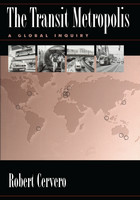 The Transit Metropolis: A Global Inquiry
Robert Cervero
Island Press, 1998 Around the world, mass transit is struggling to compete with the private automobile, and in many places, its market share is rapidly eroding. Yet a number of metropolitan areas have in recent decades managed to mount cost-effective and resource-conserving transit services that provide respectable alternatives to car travel. What sets these places apart?
In this book, noted transportation expert Robert Cervero provides an on-the-ground look at more than a dozen mass transit success stories, introducing the concept of the "transit metropolis"—a region where a workable fit exists between transit services and urban form. The author has spent more than three years studying cities around the world, and he makes a compelling case that metropolitan areas of any size and with any growth pattern—from highly compact to widely dispersed—can develop successful mass transit systems.
Following an introductory chapter that frames his argument and outlines the main issues, Cervero describes and examines five different types of transit metropolises, with twelve in-depth case studies of cities that represent each type. He considers the key lessons of the case studies and debunks widely held myths about transit and the city. In addition, he reviews the efforts underway in five North American cities to mount transit programs and discusses the factors working for and against their success. Cities profiled include Stockholm; Singapore; Tokyo; Ottawa; Zurich; Melbourne; Mexico City; Curitiba, Brazil; Portland, Oregon; and Vancouver, British Columbia.
The Transit Metropolis provides practical lessons on how North American cities can manage sprawl and haphazard highway development by creating successful mass transit systems. While many books discuss the need for a sustainable transportation system, few are able to present examples of successful systems and provide the methods and tools needed to create such a system. This book is a unique and invaluable resource for transportation planners and professionals, urban planners and designers, policymakers and students of planning and urban design.
Transit Migration in Europe
Edited by Franck Düvell, Irina Molodikova, and Michael Collyer
Amsterdam University Press, 2014 Transit migration, comprising mixed flows of refugees and labour, is widely considered a concern and even security threat. However, the concept is as vague and blurred as it is politicised. This volume offers evidence-based, comprehensive coverage of the entire belt of countries in the neighbourhood of the EU, ranging from Russia to Morocco. Transit migration is critically analyzed from the perspective of sending, transit and receiving countries, offering new insights into refugee and irregular migration flows, transnational migration networks and overlapping migration systems.
 The Transit of Empire: Indigenous Critiques of Colonialism
Jodi A. Byrd
University of Minnesota Press, 2011 In 1761 and again in 1768, European scientists raced around the world to observe the transit of Venus, a rare astronomical event in which the planet Venus passes in front of the sun. In The Transit of Empire, Jodi A. Byrd explores how indigeneity functions as transit, a trajectory of movement that serves as precedent within U.S. imperial history. Byrd argues that contemporary U.S. empire expands itself through a transferable “Indianness” that facilitates acquisitions of lands, territories, and resources. Examining an array of literary texts, historical moments, and pending legislations—from the Cherokee Nation of Oklahoma’s vote in 2007 to expel Cherokee Freedmen to the Native Hawaiian Government Reorganization bill—Byrd demonstrates that inclusion into the multicultural cosmopole does not end colonialism as it is purported to do. Rather, that inclusion is the very site of the colonization that feeds U.S. empire. Byrd contends that the colonization of American Indian and indigenous nations is the necessary ground from which to reimagine a future where the losses of indigenous peoples are not only visible and, in turn, grieveable, but where indigenous peoples have agency to transform life on their own lands and on their own terms.
The Transit of Venus Enterprise in Victorian Britain
Jessica Ratcliff
University of Pittsburgh Press, 2008 In the nineteenth century, the British Government spent money measuring the distance between the earth and the sun using observations of the transit of Venus. This book presents a narrative of the two Victorian transit programmes. It draws out their cultural significance and explores the nature of "big science" in late-Victorian Britain.
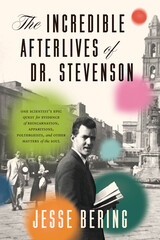 Transit: Serpent Mound Crossing Space, Time, Discourse
Chadwick Allen
University of Chicago Press How an ancient Indigenous earthwork traveled from Ohio to Washington state in the mid-1970s.
In Transit, Chadwick Allen chronicles the surprising history of how the ancient snake effigy known as Serpent Mound, located in what is now southern Ohio, traveled to Seattle, Washington in the 1970s, at the height of American Indian activism associated with the Red Power movement. Allen considers Indigenous earthworks built for thousands of years across the eastern half of the North American continent, questioning what it would mean if they were understood not as static entities fixed in space and time, but as animate forces with the ability to travel. Allen also looks at the origins of the “modern” effigy in the nineteenth century, when archaeologists reconstructed Serpent Mound’s deteriorating form to create a static icon suitable for touristic display within the confines of a settler state memorial.
Drawing from archival research, interviews, and site-specific encounters, Transit meditates on the significance of building an earthen effigy in the Pacific Northwest, as part of what became the Daybreak Star Indian Cultural Center, and on the complexity of the mound’s generative contexts. Allen’s research intersects the mid-twentieth century, when artist Robert Smithson created his iconic Spiral Jetty earth sculpture and when the Muscogee (Creek) Nation designed its innovative Mound Building. The story remains ongoing in the twenty-first century, as new mounds are rising in Oklahoma and artists, activists, and intellectuals are again asserting the power of Indigenous design.
 Transit States: Labour, Migration and Citizenship in the Gulf
Omar AlShehabi
Pluto Press, 2014 The states of the Gulf Cooperation Council (Saudi Arabia, Kuwait, Bahrain, United Arab Emirates, Oman and Qatar) form the largest destination for labour migration in the global South. In all of these states, however, the majority of the working population is composed of temporary, migrant workers with no citizenship rights.
The cheap and transitory labour power these workers provide has created the prodigious and extraordinary development boom across the region, and neighbouring countries are almost fully dependent on the labour markets of the Gulf to employ their working populations. For these reasons, the Gulf takes a central place in contemporary debates around migration and labour in the global economy.
This book attempts to bring together and explore these issues. The relationship between ‘citizen’ and ‘non-citizen’ holds immense significance for understanding the construction of class, gender, city and state in the Gulf, however too often these questions are occluded in too scholarly or overly-popular accounts of the region. Bringing together experts on the Gulf, Transit States confronts the precarious working conditions of migrants in a accessible, yet in-depth manner.
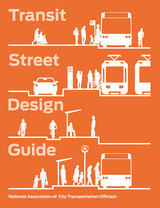 Transit Street Design Guide
National Association of City Transportation Officials
Island Press, 2016 Transit and cities grow together. As cities work to become more compact, sustainable, and healthy, their work is paying dividends: in 2014, Americans took 10.8 billion trips on public transit, the highest since the dawn of the highway era. But most of these trips are on streets that were designed to move private cars, with transit as an afterthought. The NACTO Transit Street Design Guide places transit where it belongs, at the heart of street design. The guide shows how streets of every size can be redesigned to create great transit streets, supporting great neighborhoods and downtowns.
The Transit Street Design Guide is a well-illustrated, detailed introduction to designing streets for high-quality transit, from local buses to BRT, from streetcars to light rail. Drawing on the expertise of a peer network and case studies from across North America, the guide provides a much-needed link between transit planning, transportation engineering, and street design. The Transit Street Design Guide presents a new set of core principles, street typologies, and design strategies that shift the paradigm for streets, from merely accommodating service to actively prioritizing great transit. The book expands on the transit information in the acclaimed Urban Street Design Guide, with sections on comprehensive transit street design, lane design and materials, stations and stops, intersection strategies, and city transit networks. It also details performance measures and outlines how to make the case for great transit street design in cities.
The guide is built on simple math: allocating scarce space to transit instead of private automobiles greatly expands the number of people a street can move. Street design and decisions made by cities, from how to time signals to where bus stops are placed, can dramatically change how transit works and how people use it.
The Transit Street Design Guide is a vital resource for every transportation planner, transit operations planner, and city traffic engineer working on making streets that move more people more efficiently and affordably.
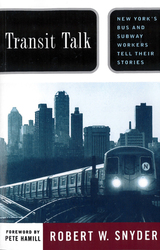 Transit Talk: New York's Bus and Subway Workers Tell Their Stories
Robert W. Snyder
Rutgers University Press, 1998 New York City may seem to be a place where everyone is a stranger, yet transit workers provide a human presence on a late-night bus or an empty subway platform. Few of us give any thought to these invisible workers-until something goes wrong. Transit Talk takes readers into the world of MTA New York City transit employees, as they describe their lives and work, from the most visible subway conductor to the seemingly invisible mechanic.
There are nearly 44,000 transit workers like those you will meet in Transit Talk , and every day they help five million of us travel to work, to school, to weddings, to funerals, to hospitals, to vacations. These workers labor daily on subway tracks inches from high-voltage powerlines, risking their lives for passengers they'U never know. The city can feel large and fragmented, but the transportation system and its workers create common threads in the lives of all New Yorkers, threads we take for granted.
Together, their stories create a human tableau of life and labor in the city within a city that is the MTA New York City Transit. Transit workers find satisfaction in fixing a damaged subway car, gain wisdom from mastering a dangerous workplace, nurse emotional wounds from tending to someone injured in an accident, battle frustration from difficulties with management, and express satisfaction when reflecting on a productive career. They tell of how years spent in the same shop create bonds between workers. They talk of the burden of laboring in a twenty-four-hour system with night shifts and weekend workdays that take them away from families. You'U hear painful tales of informing next-of-kin of a death on the tracks as well as joyous anecdotes of workers delivering a baby in a subway car.
Transition & Development in Algeria: Economic, Social and Cultural Challenges
Mohammed Saad
Intellect Books, 2013 This book deals with the economic and developmental challenges facing contemporary society. The social structures, the political institutions, the movements and ideologies, as well as cultural dilemmas, are considered in depth to give the fullest picture of the twenty-first century development.
The contributors represent a range of expertise in economics, business management, sociology, linguistics, political science and cultural studies. Their diverse backgrounds and perspectives permit this publication to explore new avenues of debate, which represent a significant contribution to the understanding of the present problems and solutions.
Transition and Transformation: Victor Sjöström in Hollywood 1923-1930
Bo Florin
Amsterdam University Press, 2013 In 1923, the film director Victor Seastrom (né Sjöström), then Sweden’s most renowned filmmaker, was recruited to Hollywood by Goldwyn Pictures, where he made eight silent pictures and one talkie in seven years, among them a 1926 version of The Scarlet Letter. What elements of Swedish cinema did he bring with him to the States, and how were these techniques transformed by Hollywood? This is the first book-length study dedicated to the films of Sjöström (1879–1960) and how he functioned in the studio system of 1920s Hollywood. Bo Florin explores the ways the director applied his austere and naturalistic film style in a radically different context and discusses how his films were received in Hollywood.
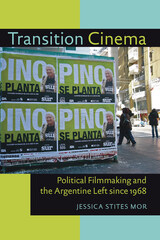 Transition Cinema: Political Filmmaking and the Argentine Left since 1968
Jessica Stites Mor
University of Pittsburgh Press, 2012
In May of 1976, documentary filmmaker and proclaimed socialist Raymundo Gleyzer mysteriously disappeared in Buenos Aires. Like many political activists, Gleyzer was the target of a brutalizing military junta that had recently assumed power. Amazingly, within a few decades, leftist filmmakers would be celebrated as intellectual vanguards in this same city.
In Transition Cinema, Jessica Stites Mor documents the critical role filmmakers, the film industry, and state regulators played in Argentina’s volatile transition to democracy. She shows how, during different regimes, the state moved to either inhibit or facilitate film production and its content, distribution, and exhibition. She also reveals the strategies the film industry employed to comply with, or circumvent these regulations.
Stites Mor divides the transition period into three distinct generations, each defined by a major political event and the reactions to these events in film. The first generation began with the failed civil uprising in Córdoba in 1969, and ended with the 1976 military takeover. During military rule, repressive censorship spurred underground exhibitions, and allied filmmakers with the Peronist left and radical activists. The second generation arose after the return of civilian rule in 1983. Buenos Aires became the center for state-level cultural programs that included filmmakers in debates over human rights and collective memory campaigns. In 1989, a third generation of filmmaking emerged, with new genres such as cine piquetero (picketer cinema) that portrayed a variety of social movements and brought them into the public eye. By the new millennium, Argentine filmmakers had gained the attention and financial support of international humanitarian and film industry organizations.
In this captivating study, Stites Mor examines how populist movements, political actors, filmmakers, government, and industry institutions all became deeply enmeshed in the project of Argentina’s transition cinema. She demonstrates how film emerged as the chronicler of political struggles in a dialogue with the past, present, and future, whose message transcended both cultural and national borders.
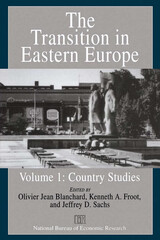 The Transition in Eastern Europe, Volume 1
Edited by Olivier Jean Blanchard, Kenneth A. Froot, and Jeffrey D. Sachs
University of Chicago Press, 1994 When communism fell in 1989, the question for most Eastern European countries was not whether to go to a market economy, but how to get there. Several years later, the difficult process of privatization and restructuring continues to concern the countries of the region. The Transition in Eastern Europe, Volumes 1 and 2 is an analysis of the experiences of various countries making the transition to market economies and examines the most important challenges still in store.
Volume 1, Country Studies, gives an in-depth, country-by-country analysis of various reform experiences, including historical backgrounds and discussions of policies and results to date. The countries analyzed are Poland, Czechoslovakia, Hungary, eastern Germany, Slovenia, and Russia. Written by leading economists, some of whom helped shape local and national reforms, this volume identifies common progress, common difficulties, and tentative solutions to the problems of economic transition.
Volume 2, Restructuring, focuses on specific issues of transition, including how to design labor market institutions, privatization, new fiscal structures, and bankruptcy laws; how to reorganize foreign trade; and how to promote foreign direct investment. The articles, written by experts in the field, will be of direct help to those involved in the transition process.
These volumes provide a standard reference on economic transition in the region for policymakers in Eastern Europe and in western countries, for international agencies concerned with the transition process, and for anyone interested in learning about the dramatic changes that have recently occurred in Eastern Europe.
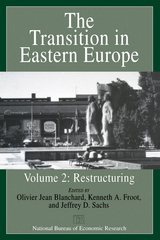 The Transition in Eastern Europe, Volume 2: Restructuring
Edited by Olivier Jean Blanchard, Kenneth A. Froot, and Jeffrey D. Sachs
University of Chicago Press, 1994 When communism fell in 1989, the question for most Eastern European countries was not whether to go to a market economy, but how to get there. Several years later, the difficult process of privatization and restructuring continues to concern the countries of the region. The Transition in Eastern Europe, Volumes 1 and 2 is an analysis of the experiences of various countries making the transition to market economies and examines the most important challenges still in store.
Volume 1, Country Studies, gives an in-depth, country-by-country analysis of various reform experiences, including historical backgrounds and discussions of policies and results to date. The countries analyzed are Poland, Czechoslovakia, Hungary, eastern Germany, Slovenia, and Russia. Written by leading economists, some of whom helped shape local and national reforms, this volume identifies common progress, common difficulties, and tentative solutions to the problems of economic transition.
Volume 2, Restructuring, focuses on specific issues of transition, including how to design labor market institutions, privatization, new fiscal structures, and bankruptcy laws; how to reorganize foreign trade; and how to promote foreign direct investment. The articles, written by experts in the field, will be of direct help to those involved in the transition process.
These volumes provide a standard reference on economic transition in the region for policymakers in Eastern Europe and in western countries, for international agencies concerned with the transition process, and for anyone interested in learning about the dramatic changes that have recently occurred in Eastern Europe.
 Transition in Post-Soviet Art: The Collective Actions Group Before and After 1989
Octavian Esanu
Central European University Press, 2013 The artistic tradition that emerged as a form of cultural resistance in the 1970s changed during the transition from socialism to capitalism. This volume presents the evolution of the Moscow-based conceptual artist group called Collective Actions, proposing it as a case-study for understanding the transformations that took place in Eastern European art after the fall of the Berlin Wall. Esanu introduces Moscow Conceptualism by performing a close examination of the Collective Actions group's ten-volume publication Journeys Outside the City and of the Dictionary of Moscow Conceptualism. He analyzes above all the evolution of Collective Actions through ten consecutive phases, discussing changes that occur in each new volume of the Journeys. Compares the part of the Journeys produced in the Soviet period with those volumes assembled after the dissolution of the USSR. The concept of "transition" and the activities of Soros Centers for Contemporary Art are also analyzed.
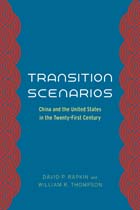 Transition Scenarios: China and the United States in the Twenty-First Century
David P. Rapkin and William R. Thompson
University of Chicago Press, 2013 China’s rising status in the global economy alongside recent economic stagnation in Europe and the United States has led to considerable speculation that we are in the early stages of a transition in power relations. Commentators have tended to treat this transitional period as a novelty, but history is in fact replete with such systemic transitions—sometimes with perilous results. Can we predict the future by using the past? And, if so, what might history teach us?
With Transition Scenarios, David P. Rapkin and William R. Thompson identify some predictors for power transitions and take readers through possible scenarios for future relations between China and the United States. Each scenario is embedded within a particular theoretical framework, inviting readers to consider the assumptions underlying it. Despite recent interest in the topic, the probability and timing of a power transition—and the processes that might bring it about—remain woefully unclear. Rapkin and Thompson’s use of the theoretical tools of international relations to crucial transitions in history helps clarify the current situation and also sheds light on possible future scenarios.
 Transitional Citizens: Voters and What Influences Them in the New Russia
Timothy J. Colton
Harvard University Press, 2000 Subjects obey. Citizens choose. Transitional Citizens looks at the newly empowered citizens of Russia's protodemocracy facing choices at the ballot box that just a few years ago, under dictatorial rule, they could not have dreamt of.
The stakes in post-Soviet elections are extraordinary. While in the West politicians argue over refinements to social systems in basically good working order, in the Russian Federation they address graver concerns--dysfunctional institutions, individual freedom, nationhood, property rights, provision of the basic necessities of life in an unparalleled economic downswing. The idiom of Russian campaigns is that of apocalypse and mutual demonization. This might give an impression of political chaos. However, as Timothy Colton finds, voting in transitional Russia is highly patterned. Despite their unfamiliarity with democracy, subjects-turned-citizens learn about their electoral options from peers and the mass media and make choices that manifest a purposiveness that will surprise many readers.
Colton reveals that post-Communist voting is not driven by a single explanatory factor such as ethnicity, charismatic leadership, or financial concerns, but rather by multiple causes interacting in complex ways. He gives us the most sophisticated and insightful account yet of the citizens of the new Russia.
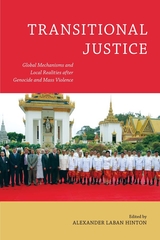 Transitional Justice: Global Mechanisms and Local Realities after Genocide and Mass Violence
Hinton, Alexander Laban
Rutgers University Press, 2011 How do societies come to terms with the aftermath of genocide and mass violence, and how might the international community contribute to this process? Recently, transitional justice mechanisms such as tribunals and truth commissions have emerged as a favored means of redress. Transitional Justice, the first edited collection in anthropology focused directly on this issue, argues that, however well-intentioned, transitional justice needs to more deeply grapple with the complexities of global and transnational involvements and the local on-the-ground realities with which they intersect.Contributors consider what justice means and how it is negotiated in different localities where transitional justice efforts are underway after genocide and mass atrocity. They address a variety of mechanisms, among them, a memorial site in Bali, truth commissions in Argentina and Chile, First Nations treaty negotiations in Canada, violent youth groups in northern Nigeria, the murder of young women in post-conflict Guatemala, and the gacaca courts in Rwanda.
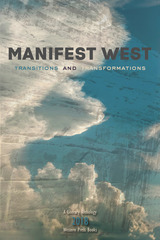 Transitions and Transformations
Elizabyth Hiscox
University Press of Colorado, 2018 Volume 7, Manifest West Series, Western Press Books What changes, alters, undergoes renewal or metamorphosis in the West? The space shared and sparred-over in urban Oregon versus remote Colorado casts doubt on the concept of a true continuity to the west. Where and when do those frontiers, borders, or alterations in course occur? Each watershed and microclimate is a slight shift from the next, each city center and community hall a locus of both change and tradition, and the emotional landscapes can be as dramatic or serene as those on the map. Language can do some of the work of capturing that flux: tracking transition and transformation to get at the heart of a life lived. The poems, short stories, and creative nonfiction essays collected here raise as many questions as they answer about that often fraught, always exciting liminal space between the proverbial here and there, the now and now again. Contributors:Eric Aldrich, Jeffrey Alfier, Betsy Bernfeld, Heidi E. Blankenship, Kierstin Bridger, Yuan Changming, David Lavar Coy, Tim Donovan, Andrea England, Matthew Gavin Frank, Rick Kempa, Mark Haunschild, Cynthia Hogue, Caitlin Horrocks, Charles Jensen, Lisa Levine, Stephen Lottridge, Jessica McDermott, Scot Siegel, Jared Smith, Victoria Waddle, Tim Weed, Susan Brown Weitzman, Lesley Wheeler Manifest West is Western Press Books’ literary anthology series. The press, affiliated with Western State Colorado University, produces one anthology annually and focuses on Western regional writing.
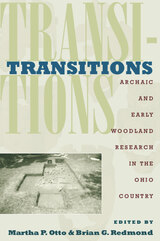 Transitions: Archaic and Early Woodland Research in the Ohio Country
Martha P. Otto
Ohio University Press, 2008 The late archaic and early woodland peoples lived in the Ohio region between 5,000 and 2,000 years ago. This was a time of transition, when hunters and gatherers began to grow native seed crops, establish more permanent settlements, and develop complex forms of ritual and ceremonialism, sometimes involving burial mound construction. The focused archaeological studies described in Transitions: Archaic and Early Woodland Research in the Ohio Country shed light on this important episode in human cultural development. The authors describe important archaeological sites such as the rich Late Archaic settlements of southwestern Ohio and the early Adena Dominion Land Company enclosure in Franklin County. They present detailed accounts of Native American behavior, such as the use of smoking pipes by Adena societies and a reconstruction of mound use and ritual. Transitions is the result of a comprehensive, long-term study focusing on particular areas of Ohio with the most up-to-date and detailed treatment of Ohio’s native cultures during this important time of change. This book will be of great value to students and other readers who wish to go beyond the general and often dated treatments of Ohio archaeology currently available.
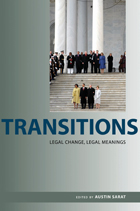 Transitions: Legal Change, Legal Meanings
Austin Sarat
University of Alabama Press, 2012 Transitions: Legal Change, Legal Meanings illustrates the various intersections, crises, and shifts that continually occur within the law, and how these moments of change interact with and comment on contemporary society. Together the essays in this volume investigate the transformation of US law during moments of political change and explore what we can learn about law by examining its role and its use in times of transition. Whether by an abrupt shift in regime or an orderly progression from one government to the next, political change often calls into question the stability and versatility of the law, making it appear temporarily absent or in suspension. What challenges to the law arise at these times? To what extent do transitional periods foster ingenuity and resourcefulness, and how might they precipitate crises in legal authority? What do moments of legal change mean for law itself and how legal institutions bring about and respond to times of transition in legal arrangements? Transitions begins the scholarly exploration of these questions that have largely been neglected. Contributors
Akhil Reed Amar / William L. Andreen /
Jack M. Beermann / Heather Elliott / Joshua
Alexander Geltzer / David Gray / Paul
Horwitz / Daniel H. Joyner / Nina
Mendelson / Meredith Render / Austin
Sarat / Ruti Teitel / Lindsey Ohlsson Worth
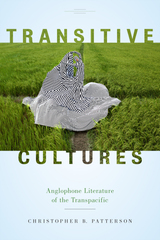 Transitive Cultures: Anglophone Literature of the Transpacific
Patterson, Christopher B
Rutgers University Press, 2018 Winner of the 2020 Shelley Fisher Fishkin Prize from the American Studies Association
Texts written by Southeast Asian migrants have often been read, taught, and studied under the label of multicultural literature. But what if the ideology of multiculturalism—with its emphasis on authenticity and identifiable cultural difference—is precisely what this literature resists?
Transitive Cultures offers a new perspective on transpacific Anglophone literature, revealing how these chameleonic writers enact a variety of hybrid, transnational identities and intimacies. Examining literature from Malaysia, Singapore, and the Philippines, as well as from Southeast Asian migrants in Canada, Hawaii, and the U.S. mainland, this book considers how these authors use English strategically, as a means for building interethnic alliances and critiquing ruling power structures in both Southeast Asia and North America. Uncovering a wealth of texts from queer migrants, those who resist ethnic stereotypes, and those who feel few ties to their ostensible homelands, Transitive Cultures challenges conventional expectations regarding diaspora and minority writers.
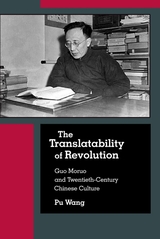 The Translatability of Revolution: Guo Moruo and Twentieth-Century Chinese Culture
Pu Wang
Harvard University Press, 2018 The first comprehensive study of the lifework of Guo Moruo (1892–1978) in English, this book explores the dynamics of translation, revolution, and historical imagination in twentieth-century Chinese culture. Guo was a romantic writer who eventually became Mao Zedong’s last poetic interlocutor; a Marxist historian who evolved into the inaugural president of China’s Academy of Sciences; and a leftist politician who devoted almost three decades to translating Goethe’s Faust. His career, embedded in China’s revolutionary century, has generated more controversy than admiration. Recent scholarship has scarcely treated his oeuvre as a whole, much less touched upon his role as a translator.
Leaping between different genres of Guo’s works, and engaging many other writers’ texts, The Translatability of Revolution confronts two issues of revolutionary cultural politics: translation and historical interpretation. Part 1 focuses on the translingual making of China’s revolutionary culture, especially Guo’s translation of Faust as a “development of Zeitgeist.” Part 2 deals with Guo’s rewritings of antiquity in lyrical, dramatic, and historiographical-paleographical forms, including his vernacular translation of classical Chinese poetry. Interrogating the relationship between translation and historical imagination—within revolutionary cultural practice—this book finds a transcoding of different historical conjunctures into “now-time,” saturated with possibilities and tensions.
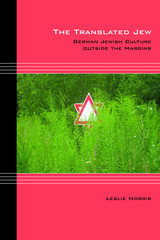 The Translated Jew: German Jewish Culture outside the Margins
Leslie Morris
Northwestern University Press, 2018 The Translated Jew brings together an eclectic set of literary and visual texts to reimagine the transnational potential for German Jewish culture in the twenty-first century. Departing from scholarship that has located the German Jewish text as an object that can be defined geographically and historically, Leslie Morris challenges national literary historiography and redraws the maps by which transnational Jewish culture and identity must be read. Morris explores the myriad acts of translation, actual and metaphorical, through which Jewishness leaves its traces, taking as a given the always provisional nature of Jewish text and Jewish language. Although the focus is on contemporary German Jewish literary cultures, The Translated Jew also turns its attention to a number of key visual and architectural projects by American, British, and French artists and writers, including W. G. Sebald, Anne Blonstein, Hélène Cixous, Ulrike Mohr, Daniel Blaufuks, Paul Celan, Raymond Federman, and Rose Ausländer. In thus realigning German Jewish culture with European and American Jewish culture and post-Holocaust aesthetics, this book explores the circulation of Jewishness between the United States and Europe. The insistence on the polylingualism of any single language and the multidirectionality of Jewishness are at the very center of The Translated Jew.
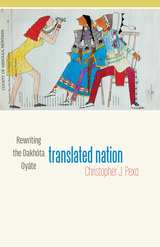 Translated Nation: Rewriting the Dakhóta Oyáte
Christopher J. Pexa
University of Minnesota Press, 2019 How authors rendered Dakhóta philosophy by literary means to encode ethical and political connectedness and sovereign life within a settler surveillance state Translated Nation examines literary works and oral histories by Dakhóta intellectuals from the aftermath of the 1862 U.S.–Dakota War to the present day, highlighting creative Dakhóta responses to violences of the settler colonial state. Christopher Pexa argues that the assimilation era of federal U.S. law and policy was far from an idle one for the Dakhóta people, but rather involved remaking the Oyáte (the Očéti Šakówiŋ Oyáte or People of the Seven Council Fires) through the encrypting of Dakhóta political and relational norms in plain view of settler audiences. From Nicholas Black Elk to Charles Alexander Eastman to Ella Cara Deloria, Pexa analyzes well-known writers from a tribally centered perspective that highlights their contributions to Dakhóta/Lakhóta philosophy and politics. He explores how these authors, as well as oral histories from the Spirit Lake Dakhóta Nation, invoke thióšpaye (extended family or kinship) ethics to critique U.S. legal translations of Dakhóta relations and politics into liberal molds of heteronormativity, individualism, property, and citizenship. He examines how Dakhóta intellectuals remained part of their social frameworks even while negotiating the possibilities and violence of settler colonial framings, ideologies, and social forms. Bringing together oral and written as well as past and present literatures, Translated Nation expands our sense of literary archives and political agency and demonstrates how Dakhóta peoplehood not only emerges over time but in everyday places, activities, and stories. It provides a distinctive view of the hidden vibrancy of a historical period that is often tied only to Indigenous survival.
Translating Baudelaire
Clive Scott
University of Exeter Press, 2000
This book is the record of an apprenticeship in translating Baudelaire, and in translating poetry more generally. Re-assessing the translator's task and art, Clive Scott explores various theoretical approaches as he goes in search of his own style of translation. In the course of the book, versions of seventeen of Baudelaire's poems are offered, with detailed evaluations of the poems and the translations.
Translating Baudelaire considers two neglected questions: What form should the criticism of translation take, if the critic is to do justice to the translator's 'project'? How can a translator persuade readers to respond to a translation as a text with its own creative dynamic and expressive ambitions?
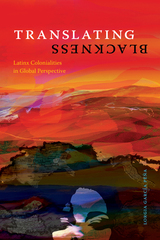 Translating Blackness: Latinx Colonialities in Global Perspective
Lorgia García Peña
Duke University Press, 2022 In Translating Blackness Lorgia García Peña considers Black Latinidad in a global perspective in order to chart colonialism as an ongoing sociopolitical force. Drawing from archives and cultural productions from the United States, the Caribbean, and Europe, García Peña argues that Black Latinidad is a social, cultural, and political formation—rather than solely a site of identity—through which we can understand both oppression and resistance. She takes up the intellectual and political genealogy of Black Latinidad in the works of Frederick Douglass, Gregorio Luperón, and Arthur Schomburg. She also considers the lives of Black Latina women living in the diaspora, such as Black Dominicana guerrillas who migrated throughout the diaspora after the 1965 civil war and Black immigrant and second-generation women like Mercedes Frías and Milagros Guzmán organizing in Italy with other oppressed communities. In demonstrating that analyses of Black Latinidad must include Latinx people and cultures throughout the diaspora, García Peña shows how the vaivén—or, coming and going—at the heart of migrant life reveals that the nation is not a sufficient rubric from which to understand human lived experiences.
 Translating Childhoods: Immigrant Youth, Language, and Culture
Orellana, Marjorie Faulstich
Rutgers University Press, 2009 Though the dynamics of immigrant family life has gained attention from scholars, little is known about the younger generation, often considered "invisible." Translating Childhoods, a unique contribution to the study of immigrant youth, brings children to the forefront by exploring the "work" they perform as language and culture brokers, and the impact of this largely unseen contribution. Skilled in two vernaculars, children shoulder basic and more complicated verbal exchanges for non-English speaking adults. Readers hear, through children's own words, what it means be "in the middle" or the "keys to communication" that adults otherwise would lack. Drawing from ethnographic data and research in three immigrant communities, Marjorie Faulstich Orellana's study expands the definition of child labor by assessing children's roles as translators as part of a cost equation in an era of global restructuring and considers how sociocultural learning and development is shaped as a result of children's contributions as translators.
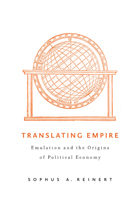 Translating Empire: Emulation and the Origins of Political Economy
Sophus A. Reinert
Harvard University Press, 2011 Historians have traditionally used the discourses of free trade and laissez faire to explain the development of political economy during the Enlightenment. But from Sophus Reinert’s perspective, eighteenth-century political economy can be understood only in the context of the often brutal imperial rivalries then unfolding in Europe and its former colonies and the positive consequences of active economic policy. The idea of economic emulation was the prism through which philosophers, ministers, reformers, and even merchants thought about economics, as well as industrial policy and reform, in the early modern period. With the rise of the British Empire, European powers and others sought to selectively emulate the British model.
In mapping the general history of economic translations between 1500 and 1849, and particularly tracing the successive translations of the Bristol merchant John Cary’s seminal 1695 Essay on the State of England, Reinert makes a compelling case for the way that England’s aggressively nationalist policies, especially extensive tariffs and other intrusive market interventions, were adopted in France, Italy, Germany, and Scandinavia before providing the blueprint for independence in the New World. Relatively forgotten today, Cary’s work served as the basis for an international move toward using political economy as the prime tool of policymaking and industrial expansion.
Reinert’s work challenges previous narratives about the origins of political economy and invites the current generation of economists to reexamine the foundations, and future, of their discipline.
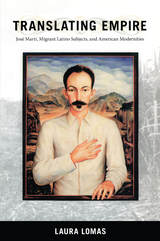 Translating Empire: Jose Marti, Migrant Latino Subjects, and American Modernities
Laura Lomas
Duke University Press, 2008 In Translating Empire, Laura Lomas uncovers how late nineteenth-century Latino migrant writers developed a prescient critique of U.S. imperialism, one that prefigures many of the concerns about empire, race, and postcolonial subjectivity animating American studies today. During the 1880s and early 1890s, the Cuban journalist, poet, and revolutionary José Martí and other Latino migrants living in New York City translated North American literary and cultural texts into Spanish. Lomas reads the canonical literature and popular culture of the United States in the Gilded Age through the eyes of Martí and his fellow editors, activists, orators, and poets. In doing so, she reveals how, in the process of translating Anglo-American culture into a Latino-American idiom, the Latino migrant writers invented a modernist aesthetics to criticize U.S. expansionism and expose Anglo stereotypes of Latin Americans. Lomas challenges longstanding conceptions about Martí through readings of neglected texts and reinterpretations of his major essays. Against the customary view that emphasizes his strong identification with Ralph Waldo Emerson and Walt Whitman, the author demonstrates that over several years, Martí actually distanced himself from Emerson’s ideas and conveyed alarm at Whitman’s expansionist politics. She questions the association of Martí with pan-Americanism, pointing out that in the 1880s, the Cuban journalist warned against foreign geopolitical influence imposed through ostensibly friendly meetings and the promotion of hemispheric peace and “free” trade. Lomas finds Martí undermining racialized and sexualized representations of America in his interpretations of Buffalo Bill and other rituals of westward expansion, in his self-published translation of Helen Hunt Jackson’s popular romance novel Ramona, and in his comments on writing that stereotyped Latino/a Americans as inherently unfit for self-government. With Translating Empire, Lomas recasts the contemporary practice of American studies in light of Martí’s late-nineteenth-century radical decolonizing project.
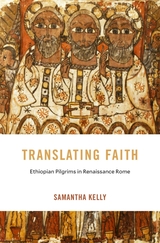 Translating Faith: Ethiopian Pilgrims in Renaissance Rome
Samantha Kelly
Harvard University Press, 2024 A revealing account of the lives and work of Ethiopian Orthodox pilgrims in sixteenth-century Rome, examining how this African diasporic community navigated the challenges of religious pluralism in the capital of Latin Christianity.
Tucked behind the apse of Saint Peter’s Basilica in Rome is the ancient church of Santo Stefano. During the sixteenth century, Santo Stefano hosted an unusual community: a group of Ethiopian Orthodox pilgrims whose faith and culture were both like and unlike those of Latin Europe. The pilgrims of Santo Stefano were the only African community in premodern Europe to leave extensive documents in their own language (Gǝʿǝz). They also frequently collaborated with Latin Christians to disseminate their expert knowledge of Ethiopia and Ethiopian Christianity, negotiating the era’s heated debates over the boundaries of religious belonging.
Translating Faith is the first book-length study of this community in nearly a century. Drawing on Gǝʿǝz and European-language sources, Samantha Kelly documents how pilgrims maintained Ethiopian Orthodox practices while adapting to a society increasingly committed to Catholic conformity. Focusing especially on the pilgrims’ scholarly collaborations, Kelly shows how they came to produce and share Ethiopian knowledge—as well as how Latin Christian assumptions and priorities transformed that knowledge in unexpected ways. The ambivalent legacies of these exchanges linger today in the European tradition of Ethiopian Studies, which Santo Stefano is credited with founding.
Kelly’s account of the Santo Stefano pilgrim community is a rich tale about the possibilities and pitfalls of ecumenical dialogue, as well as a timely history in our own age marked by intensive and often violent negotiations of religious and racial difference.
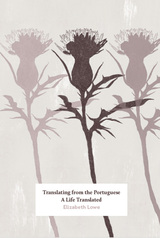 Translating from the Portuguese: A Life Translated
Elizabeth Lowe
Tagus Press, 2025 Elizabeth Lowe charts her journey to becoming a translator through a series of vignettes relating her life as a "third-culture kid" and living and working abroad in a kaleidoscope of cultures and languages. She lived in Germany as a young child immediately after the Second World War while her father worked in the Nuremburg trials and as a newly married military spouse during the Vietnam War; she lived in Haiti just prior to Papa Doc's consolidation of power, in Brazil when the military dictatorship seized the country in its two-decade vise, at the University of Coimbra, Portugal during Salazar, and Colombia at the height of the guerrilla conflicts, and in Miami during the heyday of the cartels. The book is a reflection on translation as an art, on five decades teaching languages, literatures, and translation, and on her close relationship with writers from the Lusophone world. It explores theoretical aspects of translation as well as practical challenges faced by translators, especially those working in Portuguese literature. Lowe offers intimate insights into the creative process of the writers she translates and her own philosophy of literary translation.
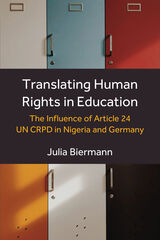 Translating Human Rights in Education: The Influence of Article 24 UN CRPD in Nigeria and Germany
Julia Biermann
University of Michigan Press, 2022 The 2006 United Nations Convention on the Rights of Persons with Disabilities (UN CRPD) is the first human rights treaty to explicitly acknowledge the right to education for persons with disabilities. In order to realize this right, the convention’s Article 24 mandates state parties to ensure inclusive education systems that overcome outright exclusion as well as segregation in special education settings. Despite this major global policy change to tackle the discriminations persons with disabilities face in education, this has yet to take effect in most school systems worldwide. Focusing on the factors undermining the realization of disability rights in education, Julia Biermann probes current meanings of inclusive education in two contrasting yet equally challenged state parties to the UN CRPD: Nigeria, whose school system overtly excludes disabled children, and Germany, where this group primarily learns in special schools. In both countries, policy actors aim to realize the right to inclusive education by segregating students with disabilities into special education settings. In Nigeria, this demand arises from the glaring lack of such a system. In Germany, conversely, from its extraordinary long-term institutionalization. This act of diverting from the principles embodied in Article 24 is based on the steadfast and shared belief that school systems, which place students into special education, have an innate advantage in realizing the right to education for persons with disabilities. Accordingly, inclusion emerges to be an evolutionary and linear process of educational expansion that depends on institutionalized special education, not a right of persons with disabilities to be realized in local schools on an equal basis with others. This book proposes a refined human rights model of disability in education that shifts the analytical focus toward the global politics of formal mass schooling as a space where discrimination is sustained.
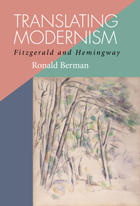 Translating Modernism: Fitzgerald and Hemingway
Ronald Berman
University of Alabama Press, 2009 In Translating Modernism Ronald Berman continues his career-long study of the ways that intellectual and philosophical ideas informed and transformed the work of America’s major modernist writers. Here Berman shows how Fitzgerald and Hemingway wrestled with very specific intellectual, artistic, and psychological influences, influences particular to each writer, particular to the time in which they wrote, and which left distinctive marks on their entire oeuvres. Specifically, Berman addresses the idea of "translating" or "translation"—for Fitzgerald the translation of ideas from Freud, Dewey, and James, among others; and for Hemingway the translation of visual modernism and composition, via Cézanne. Though each writer had distinct interests and different intellectual problems to wrestle with, as Berman demonstrates, both had to wrestle with transmuting some outside influence and making it their own.
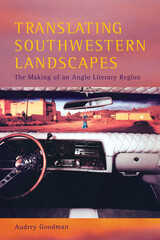 Translating Southwestern Landscapes: The Making of an Anglo Literary Region
Audrey Goodman
University of Arizona Press, 2002 Winner of the Western Literature Association’s Thomas J. Lyon Award
Whether as tourist's paradise, countercultural destination, or site of native resistance, the American Southwest has functioned as an Anglo cultural fantasy for more than a century. In Translating Southwestern Landscapes, Audrey Goodman excavates this fantasy to show how the Southwest emerged as a symbolic space from 1880 through the early decades of the twentieth century.
Drawing on sources as diverse as regional magazines and modernist novels, Pueblo portraits and New York exhibits, Goodman has crafted a wide-ranging history that explores the invention, translation, and representation of the Southwest. Its principal players include amateur ethnographer Charles Lummis, who conflated the critical work of cultural translation; pulp novelist Zane Grey, whose bestselling novels defined the social meanings of the modern West; fashionable translator Mary Austin, whose "re-expressions" of Indian song are contrasted with recent examples of ethnopoetics; and modernist author Willa Cather, who demonstrated an immaterial feeling for landscape from the Nebraska Plains to Acoma Pueblo.
Goodman shows how these writers—as well as photographers such as Paul Strand, Ansel Adams, and Alex Harris—exhibit different phases of the struggle between an Anglo calling to document Native and Hispanic difference and America's larger drive toward imperial mastery. In critiquing photographic representations of the Southwest, she argues that commercial interests and eastern prejudices boiled down the experimental images of the late nineteenth century to a few visual myths: the persistence of wilderness, the innocence of early portraiture, and the purity of empty space.
An ambitious synthesis of criticism and anthropology, art history and geopolitical theory, Translating Southwestern Landscapes names the defining contradictions of America's most recently invented cultural space. It shows us that the Southwest of these early visitors is the only Southwest most of us have ever known.
Translating the Body: Medical Education in Southeast Asia
Edited by Hans Pols, C. Michele Thompson, and John Harley Warner
National University of Singapore Press, 2017 Until recently, receiving a European or North American-style medical education in Southeast Asia was a profoundly transformative experience, as western conceptions of the body differed significantly from indigenous knowledge and explanations. Further, conceptions of the human body had to be translated into local languages and related to vernacular views of health, disease, and healing. Translating the Body is the first book to present the history of biomedical education across Southeast Asia. The contributors chart and analyze the organization of western medical education in Southeast Asia, public health education campaigns in the region, and the ways in which practitioners of what came to be conceived of as “traditional medicine” in many Southeast Asian countries organized themselves in response.
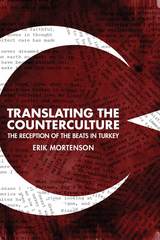 Translating the Counterculture: The Reception of the Beats in Turkey
Erik Mortenson
Southern Illinois University Press, 2018 In Turkey the Beat message of dissent is being given renewed life as publishers, editors, critics, readers, and others dissatisfied with the conservative social and political trends in the country have turned to the Beats and other countercultural forebears for alternatives. Through an examination of a broad range of literary translations, media portrayals, interviews, and other related materials, this book seeks to uncover how the Beats and their texts are being circulated, discussed, and used in Turkey to rethink the possibilities they might hold for social critique today.
Mortenson examines how in Turkey the Beats have been framed by the label “underground literature”; explores the ways they are repurposed in the counterculture-inspired journal Underground Poetix; looks at the reception of Jack Kerouac’s On the Road and how that reaction provides a better understanding of the construction of “American-ness”; delves into the recent obscenity trial of William S. Burroughs’s novel The Soft Machine and the attention the book’s supporters brought to government repression and Turkish homophobia; and analyzes the various translations of Allen Ginsberg’s Howl to demonstrate the relevance Ginsberg still holds for social rebellion today.
Translating the Counterculture takes a revolutionary look at how contemporary readers in other parts of the world respond to the Beats. Challenging and unsettling an American-centric understanding of the Beats, Mortenson pushes the discipline toward a fuller consideration of their cultural legacy in a globalized twenty-first century.
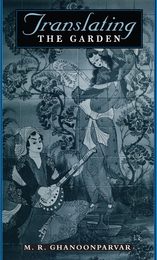 Translating the Garden
By M. R. Ghanoonparvar
University of Texas Press, 2002 Translating a work of literature from one language to another is an art form, in which the translated work becomes a "conduit" through which the reader of one language may pass into the cultural world of another. For the translator, the process of translation offers an intimate experience of the text that is perhaps unavailable even to the author. And yet, as M. R. Ghanoonparvar observes at the outset of this book, "every translation is inevitably a failure, with occasional moments of success." In Translating the Garden, Ghanoonparvar allows readers to watch him in the process of translating Shahrokh Meskub's Goftogu dar Bagh(Dialogue in the Garden) from Persian into English. This short philosophical work uses a conversation between a writer and a painter to explore Persian perceptions of art, literature, nature, identity, and spirituality. As he translates the text, Ghanoonparvar discusses the myriad decisions that a literary translator faces, from word choices to the problems of conveying cultural concepts and deciphering authorial intent. He also compares some of his translated passages with those of other translators to highlight the uniqueness of each act of translation. The complete English translation of Dialogue in the Garden rounds out the volume.
 Translating the Ketubah: The Jewish Marriage Contract in America and England
Benjamin Steiner
University of Alabama Press, 2025 A groundbreaking exploration of the Jewish marriage contract and its evolution in English translation Translating the Ketubah offers a fresh perspective on the ketubah, the Jewish marriage contract. Traditionally composed in Aramaic, ketubot have been examined in other books within the frameworks of Jewish law and Jewish art. Here, however, Benjamin Steiner shows how translations of the ketubah into English helped Jews adapt to changing social and economic circumstances across more than two centuries. Steiner uses ketubot to trace the intricate relationship between religious law and secular law, the changing status of women within and outside Judaism, and the complex desire of Jews to be both authentically Jewish and fully acculturated. Steiner further shows how ketubah translation aided Jews to achieve different cultural goals. It has been used to uphold rabbinic law in communities where religious affiliation was voluntary to ensure women's economic security. It has also facilitated socialization with non-Jews and addressed perceived crises within the Jewish family. Through a nuanced analysis of ketubah translations from England and various regions of the United States from the late eighteenth century to the present, Steiner offers a detailed look at how Jews have adapted ancient tradition to meet the challenges and opportunities of different historical contexts. His work sheds new light on the rich history of American and British Jewry.
 Translating the New Philosophy in the Dutch Early Enlightenment (1640-1720)
Lucas van der Deijl
Amsterdam University Press, 2025 A small group of freethinkers from the Dutch Republic played a key role in the major intellectual changes of the Early Enlightenment (1640–1720). In the wake of Cartesianism, their rationalist ideas transformed debates about science, theology, medicine, and political theory. This book studies the position of four translators in these debates on the ‘New Philosophy’: Jan Hendriksz Glazemaker, Pieter Balling, Abraham van Berkel, and Stephan Blankaart. It presents a comparative history of their Dutch translations of philosophical treatises by René Descartes, Thomas Hobbes, and Benedictus de Spinoza. A combined methodology of computational and qualitative analysis offers new insights into the form and function of translated philosophical texts within the intellectual debates about language, reason, and knowledge that were partly inspired by those texts. These insights change our understanding of the crucial function of translations, multilingualism, and linguistic purism in the Dutch Early Enlightenment.
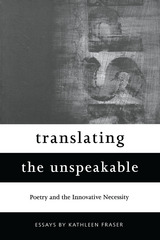 Translating the Unspeakable: Poetry and the Innovative Necessity
Kathleen Fraser
University of Alabama Press, 1999 A prominent avant-garde poet charts both her personal artistic development and the difficulties faced by women writers pursuing innovative paths.
An accomplished and influential poet, Kathleen Fraser has been instrumental in drawing attention to other women poets working
outside the mainstream. Translating the Unspeakable gathers eighteen of her essays written over nearly twenty years, combining autobiography and criticism to examine what it means for any artist to innovate instead of following an already traveled path.
In autobiographical passages Fraser tells how her generation was influenced by revolutions in art and philosophy during the early 1960s and how she spent years pursuing idiosyncratic means of rediscovering the poem's terms. By the 1970s her evolving poetics were challenged by questions of gender, until immersion in feminist/modernist scholarship led her to initiate greater dialogue among experimentalist poets.
Other essays examine modernist women writers, their contemporary successors, and the visual poetics they have practiced. By exploring the work of such poets as H. D., Mina Loy, Lorine Niedecker, and Barbara Guest, Fraser conveys their struggle to establish a presence within accepted poetic conventions and describes the role experimentation plays in helping women overcome self-imposed silence.
All of Fraser's writings explore how the search to find one's own way of speaking into a very private yet historic space—of translating the unspeakable—drives poetic experimentation for women and men alike. This provocative book provides a glimpse into the thought processes of
the poetic mind, enhancing our understanding of innovative writing.
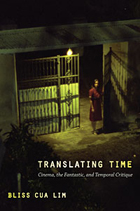 Translating Time: Cinema, the Fantastic, and Temporal Critique
Bliss Cua Lim
Duke University Press, 2009 Under modernity, time is regarded as linear and measurable by clocks and calendars. Despite the historicity of clock-time itself, the modern concept of time is considered universal and culturally neutral. What Walter Benjamin called “homogeneous, empty time” founds the modern notions of progress and a uniform global present in which the past and other forms of time consciousness are seen as superseded. In Translating Time, Bliss Cua Lim argues that fantastic cinema depicts the coexistence of other modes of being alongside and within the modern present, disclosing multiple “immiscible temporalities” that strain against the modern concept of homogeneous time. In this wide-ranging study—encompassing Asian American video (On Cannibalism), ghost films from the New Cinema movements of Hong Kong and the Philippines (Rouge, Itim, Haplos), Hollywood remakes of Asian horror films (Ju-on, The Grudge, A Tale of Two Sisters) and a Filipino horror film cycle on monstrous viscera suckers (Aswang)—Lim conceptualizes the fantastic as a form of temporal translation. The fantastic translates supernatural agency in secular terms while also exposing an untranslatable remainder, thereby undermining the fantasy of a singular national time and emphasizing shifting temporalities of transnational reception. Lim interweaves scholarship on visuality with postcolonial historiography. She draws on Henri Bergson’s understanding of cinema as both implicated in homogeneous time and central to its critique, as well as on postcolonial thought linking the ideology of progress to imperialist expansion. At stake in this project are more ethical forms of understanding time that refuse to domesticate difference as anachronism. While supernaturalism is often disparaged as a vestige of primitive or superstitious thought, Lim suggests an alternative interpretation of the fantastic as a mode of resistance to the ascendancy of homogeneous time and a starting-point for more ethical temporal imaginings.
Translating Transgender
David Gramling and Aniruddha Dutta, special issue editors
Duke University Press This issue of Transgender Studies Quarterly calls for multilingual and translational critique. Few primary and secondary texts about transgender lives and ideas have been translated from language to language in any formal way over the centuries. This is an important problem for transgender studies in the coming decades because an Anglophone disciplinary and discursive disposition will continue to lead policy makers, public intellectuals, and academics to fall back on ethnocentric and monolingual frameworks and resources.
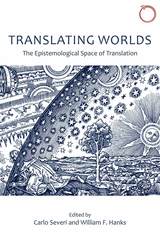 Translating Worlds: The Epistemological Space of Translation
Edited by Carlo Severi and William F. Hanks
HAU, 2015 Set against the backdrop of anthropology’s recent focus on various “turns” (whether ontological, ethical, or otherwise), this pathbreaking volume returns to the question of knowledge and the role of translation as a theoretical and ethnographic guide for twenty-first century anthropology, gathering together contributions from leading thinkers in the field.
Since Ferdinand de Saussure and Franz Boas, languages have been seen as systems whose differences make precise translation nearly impossible. And still others have viewed translation between languages as principally indeterminate. The contributors here argue that the challenge posed by the constant confrontation between incommensurable worlds and systems may be the most fertile ground for state-of-the-art ethnographic theory and practice. Ranging from tourism in New Guinea to shamanism in the Amazon to the globally ubiquitous restaurant menu, the contributors mix philosophy and ethnography to redefine translation not only as a key technique for understanding ethnography but as a larger principle in epistemology.
Translation
Martin Kay
CSLI, 2015 Martin Kay’s Translation is concerned with the fundamental underpinnings of the titular subject. Kay argues that the primary responsibility of the translator is to the referents of words themselves. He shows how a pair of sentences that might have widely different meanings in isolation could have similar meanings in some contexts. Exploring such key subjects as how to recognize when a pair of texts might be translations of each other, Kay attempts to answer the essential question: What is translation anyway?
Translation: An Elizabethan Art
F.O. Matthiessen
Harvard University Press By a close analysis of the work of four of the principal Elizabethan translators, Hoby, North, Florio, and Philemon Holland, Matthiessen indicates how the great foreign classics were brought home to the minds of sixteenth-century English men, what learning meant to them, and why they were so fired with enthusiasm to attain it. He also throws fresh light on the forces which actuated the development of the language in that period, its new possibilities of imagination and vigor, the qualities its writers sought to express, the difficulties they had to compass, and the ends they achieved. He furthermore makes clear the reasons why the Elizabethan translations have endured as a part of English literature as no other group of translations ever has.
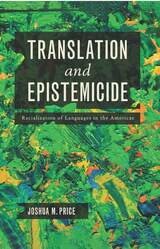 Translation and Epistemicide: Racialization of Languages in the Americas
Joshua M. Price
University of Arizona Press, 2023 Translation has facilitated colonialism from the fifteenth century to the present day. Epistemicide, which involves destroying, marginalizing, or banishing Indigenous, subaltern, and counter-hegemonic knowledges, is one result. In the Americas, it is a racializing process. But in the hands of subaltern translators and interpreters, translation has also been used as a decolonial method.
The book gives an account of translation-as-epistemicide in the Americas, drawing on a range of examples from the early colonial period to the War on Terror. The first chapters demonstrate four distinct operations of epistemicide: the commensuration of worlds, the epistemic marginalization of subaltern translators and the knowledge they produce, the criminalization of translators and interpreters, and translation as piracy or extractivism. The second part of the book outlines decolonial translation strategies, including an epistemic posture the author calls “bewilderment.”
Translation and Epistemicide tracks how through the centuries translation practices have enabled colonialism and resulted in epistemicide, or the destruction of Indigenous and subaltern knowledge.
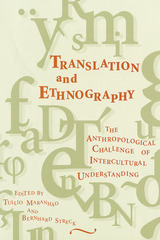 Translation and Ethnography: The Anthropological Challenge of Intercultural Understanding
Tullio Maranhão
University of Arizona Press, 2003 To most people, translation means making the words of one language understandable in another; but translation in a broader sense-seeing strangeness and incorporating it into one's understanding-is perhaps the earliest task of the human brain. This book illustrates the translation process in less-common contexts: cultural, religious, even the translation of pain. Its original contributions seek to trace human understanding of the self, of the other, and of the stranger by discovering how we bridge gaps within or between semiotic systems.
Translation and Ethnography focuses on issues that arise when we attempt to make significant thematic or symbolic elements of one culture meaningful in terms of another. Its chapters cover a wide range of topics, all stressing the interpretive practices that enable the approximation of meaning: the role of differential power, of language and so-called world view, and of translation itself as a metaphor of many contemporary cross-cultural processes.
The topics covered here represent a global sample of translation, ranging from Papua New Guinea to South America to Europe. Some of the issues addressed include postcolonial translation/transculturation from the perspective of colonized languages, as in the Mexican Zapatista movement; mis-translations of Amerindian conceptions and practices in the Amazon, illustrating the subversive potential of anthropology as a science of translation; Ethiopian oracles translating divine messages for the interpretation of believers; and dreams and clowns as translation media among the Gamk of Sudan.
Anthropologists have long been accustomed to handling translation chains; in this book they open their diaries and show the steps they take toward knowledge. Translation and Ethnography raises issues that will shake up the most obdurate, objectivist translators and stimulate scholars in sociolinguistics, communication, ethnography, and other fields who face the challenges of conveying meaning across human boundaries.
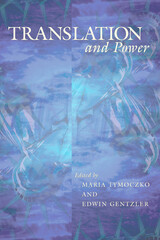 Translation and Power
Maria Tymoczko
University of Massachusetts Press, 2002 The contributors to this volume see translation as an activity that takes place not in an ideal neutral site but in real social and political situations, with parties who have vested interests in the production and reception of texts across linguistic and cultural boundaries. Translation is not simply a process of faithful reproduction but invariably involves deliberate acts of selection, construction, and omission. It is inextricably linked to issues of cultural dominance, assertion, and resistance—in short, to power.
Although governments, churches, publishing firms, and other powerful institutions may influence the translation process, many translators have found ways to resist that influence and have used translation to introduce new ideas and modes of expression. Exploring the nexus of translation and power, the essays in this volume offer a wide variety of examples, across multiple languages and societies. They range from case studies of historical episodes in which translation has played a role in the assertion of political and military power, such as an 1840 treaty between the British and Maori that continues to be a source of conflict in present-day New Zealand, to analyses of the work of specific translators, such as Germaine de Staël and Gayatri Spivak. Along with examining how translation contributes to ideological negotiations and cultural struggles, the essays reveal the dimensions of power inherent in the translation process itself—in the relationship of translator to author, source text, and translated text.
In addition to the editors, contributors include Rosemary Arrojo, Michael Cronin, Sabine Fenton, Camino Gutiérrez Lanza, Christopher Larkosh, Alexandra Lianeri, Lin Kenan, Carol Maier, Paul Moon, Adriana S. Pagano, and Sherry Simon.
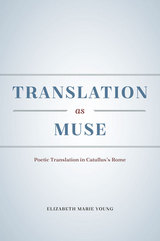 Translation as Muse: Poetic Translation in Catullus's Rome
Elizabeth Marie Young
University of Chicago Press, 2015 Poetry is often said to resist translation, its integration of form and meaning rendering even the best translations problematic. Elizabeth Marie Young disagrees, and with Translation as Muse, she uses the work of the celebrated Roman poet Catullus to mount a powerful argument that translation can be an engine of poetic invention.
Catullus has long been admired as a poet, but his efforts as a translator have been largely ignored. Young reveals how essential translation is to his work: many poems by Catullus that we tend to label as lyric originals were in fact shaped by Roman translation practices entirely different from our own. By rereading Catullus through the lens of translation, Young exposes new layers of ingenuity in Latin poetry even as she illuminates the idiosyncrasies of Roman translation practice, reconfigures our understanding of translation history, and questions basic assumptions about lyric poetry itself.
Translation as Resistance: Czech and Ukrainian Historical Perspectives
Edited by Zuzana Štastná, Iryna Odrekhivska, and Stanislav Rubáš
Karolinum Press, 2026 A groundbreaking scholarly account of translation as a form of resistance in Ukrainian and Czech history, from imperial oppression to Soviet censorship and beyond.
In cultures and communities under pressure, whether from a powerful neighbor or a hegemonic ideology, translation becomes a political act. Shaped by the constraints of the moment, both translations and their paratexts are subject to forces that compromise quality or restrict freedom of expression, even as translators seek to bring home the quality and expressive freedom of their originals. In Translation as Resistance, the role translation has played and continues to play in reframing language and power in Czech and Ukrainian cultures is presented and interrogated by Czech and Ukrainian translators.
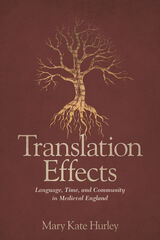 Translation Effects: Language, Time, and Community in Medieval England
Mary Kate Hurley
Ohio State University Press, 2021 In Translation Effects: Language, Time, and Community in Medieval England, Mary Kate Hurley reinterprets a well-recognized and central feature of medieval textual production: translation. Medieval texts often leave conspicuous evidence of the translation process. These translation effects are observable traces that show how medieval writers reimagined the nature of the political, cultural, and linguistic communities within which their texts were consumed. Examining translation effects closely, Hurley argues, provides a means of better understanding not only how medieval translations imagine community but also how they help create communities. Through fresh readings of texts such as the Old English Orosius, Ælfric’s Lives of the Saints, Ælfric’s Homilies, Chaucer, Trevet, Gower, and Beowulf, Translation Effects adds a new dimension to medieval literary history, connecting translation to community in a careful and rigorous way and tracing the lingering outcomes of translation effects through the whole of the medieval period.
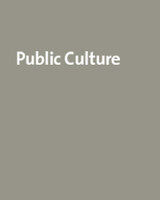 Translation in a Global Market, Volume 13
Emily Apter, ed.
Duke University Press What is the impact of globalization on texts and media? To what extent do artists and writers consciously or unconsciously build translatability into their work? Translation in a Global Market addresses these questions as well as the problems that may arise from a global market in cultural and aesthetic forms. For instance, what does a global market that increasingly rewards translation-friendly works that cross linguistic and cultural boundaries mean for publishing in non-Western languages? What are the politics of an emergent internationalized aesthetic that privileges metropolitan over vernacular genres? And why do specific cultural objects arrive and circulate in various public spheres? The essays in this volume critically investigate these questions without assuming that these objects were destined to arrive in those public spheres. Translation in a Global Market assembles contributors from several academic disciplines as well as visual artists for a closer look at the formation of an international canon and at the kinds of texts that gain international visibility. The essays urge a shift in emphasis from global literacy—which implies the use of a standard language and a preference for translatability in texts—to transnational literacy, which places minority and diaspora literatures in direct conversation with each other rather than with Paris, London, or New York. Contributors. Dina Al-Kassim, Emily Apter, Timothy Brennan, Elena Climent, Maryse Condé, Michael Eng, Renée Green, Rainer Ganahl, Sarah M. Hudgins, Michael North, Gayatri Chakravorty Spivak
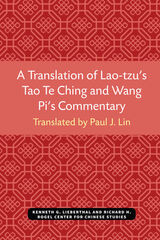 A Translation of Lao-tzu’s Tao Te Ching and Wang Pi’s Commentary
Translated by Paul J. Lin
University of Michigan Press, 1977 During the Spring-Autumn period (722–420 BCE) and the time of the Warring States (480–222 CE), China was in great turmoil. Intellectuals and social reformers sifted through their wisdom and knowledge of China’s experiences up to then, attempting to find a solution to their situation. The Tao Te Ching, one of the foremost products of the era, is a metaphysical book, a source of the highest political thought. Many readers have found in it representations of the highest ideals of human endeavors. Yet given its likely oral origin and the technological limitations of its early textual transmission, the Tao Te Ching raises numerous questions related to authorship, date of origin, internal organization, textual coherence, and editorial history. Of the scores of translations of the Tao Te Ching, the great majority are based on the edition prepared by the third-century scholar Wang Pi. Wang’s profound commentary is itself a deeply influential text in the development of Taoist thought. Paul Lin presents the commentary, otherwise unavailable in English, in the form of footnotes accompanying his meticulous rendition of the Taoist classic.
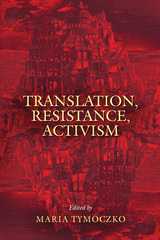 Translation, Resistance, Activism
Maria Tymoczko
University of Massachusetts Press, 2010 More than merely linguistic transposition, translation is a vector of power, resistance, rebellion, and even revolution. Exploring these facets of the ideology of translation, the contributors to this volume focus on the agency of translators and their activism. Spanning two centuries and reaching across the globe, the essays examine the varied activist strategies of key translators and translation movements.
From silence to radical manipulation of texts, translation strategies are instrumental in significant historical interventions and cultural change. Translation plays a pivotal role in ideological dialogue and struggle, including resistance to oppression and cultural straitjackets of all types, from sexual puritanism to military dictatorships. Situated in their own space, time, history, and political contexts, translators promote ideological agendas by creating new cultural narratives, pragmatically adjusting tactics so as to maximize the social and political impact.
The essays in this volume explore ways to read translations as records of cultural contestation and ideological struggle; as means of fighting censorship, physical coercion, cultural repression, and political dominance; and as texts that foster a wide variety of goals from cultural nationalism to armed confrontation. Translations are set in relief as central cultural documents rather than derivative, peripheral, or marginalized productions. They are seen as forms of ethical, political, and ideological activity rather than as mere communicative transactions or creative literary exercises.
The contributors demonstrate that engaged and activist translations are performative acts within broader political and ideological contexts. The essays detail the initiative, resourcefulness, and courage of individual translators, whose willingness to put themselves on the line for social change can sometimes move the world.
In addition to Maria Tymoczko, contributors include Pua'ala'okalani D. Aiu, Brian James Baer, Mona Baker, Paul F. Bandia, Georges L. Bastin, Nitsa Ben-Ari, Ãngela Campo, Antonia Carcelen-Estrada, Ãlvaro Echeverri, Denise Merkle, John Milton, and Else R.P. Vieira.
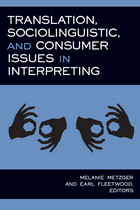 Translation, Sociolinguistic, and Consumer Issues in Interpreting
Melanie Metzger
Gallaudet University Press, 2007 The Third Volume in the Studies in Interpretation Series
This new volume focuses on scholarship over a refined spectrum of issues that confront interpreters internationally. Editors Melanie Metzger and Earl Fleetwood call upon researchers from the United States, Ireland, Australia, and the Philippines to share their findings in six chapters.
In the first chapter, Roberto R. Santiago and Lisa A. Frey Barrick reveal how interpreters deal with translating source language idioms into American Sign Language (ASL). In Chapter 2, Lorraine Neeson and Susan Foley-Cave review the particular demands for decision-making that face interpreters on several levels in a class on semantics and pragmatics. Liza B. Martinez explains in Chapter 3 the complicated, multilingual process of code switching by Filipino interpreters when voice-interpreting Filipino Sign Language.
Chapter 4 offers a deconstruction by Daniel Roush of the stereotype that Deaf ASL-users are direct or blunt, based on his analysis of two speech/social activities of requests and refusals. Jemina Napier investigates interpreting from the perspective of deaf consumers in Australia in Chapter 5 to explore their agenda for quality interpreting services. In the final chapter, Amy Frasu evaluates methods for incorporating visual aids into interpretations from spoken English to American Sign Language and the potential cognitive dissonance for deaf persons that could result.
Translation Technique and Literary Structures in Greek Isaiah 13:1–14:23
Matthew J. Albanese
SBL Press, 2025 Matthew J. Albanese explores the translation techniques behind the Greek version of Isaiah 13:1–14:23, offering fresh insights into how the translator rendered the Hebrew text. Through a detailed analysis of style, structure, and linguistic choices, this book reveals how the translator’s decisions were deeply rooted in the Hebrew text, shedding new light on the artistry of biblical interpretation and translation in ancient Judaism. The work also examines how certain divergences and shifts in Hebrew-to-Greek clause structure, semantics, and lexical misunderstanding influenced the formation of Greek Isaiah. The work advances Greek Isaiah research by highlighting the translator’s awareness and appropriation of features from larger thematic and structural portions of Hebrew Isaiah 13:1–14:23.
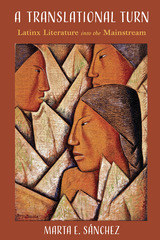 A Translational Turn: Latinx Literature into the Mainstream
Marta Sanchez
University of Pittsburgh Press, 2018 No contemporary development underscores the transnational linkage between the United States and Spanish-language América today more than the wave of in-migration from Spanish-language countries during the 1980s and 1990s. This development, among others, has made clear what has always been true, that the United States is part of Spanish-language América. Translation and oral communication from Spanish to English have been constant phenomena since before the annexation of the Mexican Southwest in 1848. The expanding number of counter-national translations from English to Spanish of Latinx fictional narratives by mainstream presses between the 1990s and 2010 is an indication of significant change in the relationship. A Translational Turn explores both the historical reality of Spanish to English translation and the “new” counter-national English to Spanish translation of Latinx narratives. More than theorizing about translation, this book underscores long-standing contact, such as code-mixing and bi-multilingualism, between the two languages in U.S. language and culture. Although some political groups in this country persist in seeing and representing this country as having a single national tongue and community, the linguistic ecology of both major cities and the suburban periphery, here and in the global world, is bilingualism and multilingualism.
 Translation’s Forgotten History: Russian Literature, Japanese Mediation, and the Formation of Modern Korean Literature
Heekyoung Cho
Harvard University Press, 2016 Translation’s Forgotten History investigates the meanings and functions that translation generated for modern national literatures during their formative period and reconsiders literature as part of a dynamic translational process of negotiating foreign values. By examining the triadic literary and cultural relations among Russia, Japan, and colonial Korea and revealing a shared sensibility and literary experience in East Asia (which referred to Russia as a significant other in the formation of its own modern literatures), this book highlights translation as a radical and ineradicable part—not merely a catalyst or complement—of the formation of modern national literature. Translation’s Forgotten History thus rethinks the way modern literature developed in Korea and East Asia. While national canons are founded on amnesia regarding their process of formation, framing literature from the beginning as a process rather than an entity allows a more complex and accurate understanding of national literature formation in East Asia and may also provide a model for world literature today.
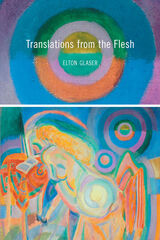 Translations from the Flesh
Elton Glaser
University of Pittsburgh Press, 2013 Translations from the Flesh, Elton Glaser's seventh full-length collection of poetry, is driven by the powerful engines of love and desire. In poems long and brief, playful and intense, Glaser evokes what it feels like "to fall into / Love and its infinite mistakes." In a style that might be described as "flamboyant stoicism" (a phrase from Simon Callow,) he explores our human urgencies and weaknesses, following wherever our appetites lead us, whether hormonal or spiritual, cravings that we struggle to understand. The voice that says "Apprentice me to mysteries of the flesh" speaks for everyone intent on making sense of the body's restless yearning for fulfillment. These poems, with their witty brio and passionate precision of language, agree with Gerald Stern that "the brain / is the best organ for love." At the same time, they are not afraid to get down in the dirt, among the more primitive pleasures. Whatever their bent, from moony aspirations to "rare positions only the wicked know," the poems express Glaser's mission to give voice to those deep pressures that move us, body and soul: "I put my native tongue / To work, open to / The dark instincts of ecstasy."
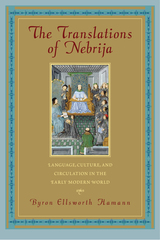 The Translations of Nebrija: Language, Culture, and Circulation in the Early Modern World
Byron Ellsworth Hamann
University of Massachusetts Press, 2015 In 1495, the Spanish humanist Antonio de Nebrija published a Spanish-to-Latin dictionary that became a best seller. Over the next century it was revised dozens of times, in nine European cities. As these dictionaries made their way around the globe in this age of encounters, their lists of Spanish words became frameworks for dictionaries of non-Latin languages. What began as Spanish to Latin became Spanish to Arabic, French, English, Tuscan, Nahuatl, Mayan, Quechua, Aymara, Tagalog, and more.
Tracing the global influence of Nebrija's dictionary, Byron Ellsworth Hamann, in this interdisciplinary, deeply researched book, connects pagan Rome, Muslim Spain, Aztec Tenochtitlan, Elizabethan England, the Spanish Philippines, and beyond, revealing new connections in world history. The Translations of Nebrija re-creates the travels of people, books, and ideas throughout the early modern world and reveals the adaptability of Nebrija's text, tracing the ways heirs and pirate printers altered the dictionary in the decades after its first publication. It reveals how entries in various editions were expanded to accommodate new concepts, such as for indigenous languages in the Americas—a process with profound implications for understanding pre-Hispanic art, architecture, and writing. It shows how words written in the margins of surviving dictionaries from the Americas shed light on the writing and researching of dictionaries across the early modern world.
Exploring words and the dictionaries that made sense of them, this book charts new global connections and challenges many assumptions about the early modern world.
The Translator in the Text: On Reading Russian Literature in English
Rachel May
Northwestern University Press, 1994 What does it mean to read one nation's literature in another language? The considerable popularity of Russian literature in the English-speaking world rests almost entirely upon translations. In The Translator and the Text, Rachel May analyzes Russian literature in English translation, seeing it less as a substitute for the original works than as a subset of English literature, with its own cultural, stylistic, and narrative traditions.
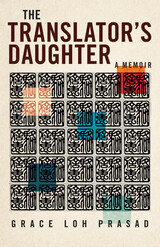 The Translator's Daughter: A Memoir
Grace Loh Prasad
Ohio State University Press, 2024 Born in Taiwan, Grace Loh Prasad was two years old when the threat of political persecution under Chiang Kai-shek's dictatorship drove her family to the United States, setting her up to become an accidental immigrant. The family did not know when they would be able to go home again; this exile lasted long enough for Prasad to forget her native Taiwanese language and grow up American. Having multilingual parents—including a father who worked as a translator—meant she never had to develop the fluency to navigate Taiwan on visits. But when her parents moved back to Taiwan permanently when she was in college and her mother was diagnosed with Alzheimer's, she recognized the urgency of forging a stronger connection with her birthplace before it was too late. As she recounts her journey to reclaim her heritage in The Translator's Daughter, Prasad unfurls themes of memory, dislocation, and loss in all their rich complexity. The result is a unique immigration story about the loneliness of living in a diaspora, the search for belonging, and the meaning of home.
A Translator’s Defense
Giannozzo Manetti
Harvard University Press, 2016 Giannozzo Manetti (1396–1459) was an Italian diplomat and a celebrated humanist orator and scholar of the early Renaissance. Son of a wealthy Florentine merchant, he turned away from a commercial career to take up scholarship under the guidance of the great civic humanist, Leonardo Bruni. Like Bruni he mastered both classical Latin and Greek, but, unusually, added to his linguistic armory a command of Biblical Hebrew as well. He used his knowledge of Hebrew to make a fresh translation of the Psalms into humanist Latin, a work that implicitly challenged the canonical Vulgate of St. Jerome. His Apologeticus (1455–59) in five books was a defense of the study of Hebrew and of the need for a new translation. As such, it constituted the most extensive treatise on the art of translation of the Renaissance. This ITRL edition contains the first complete translation of the work into English.
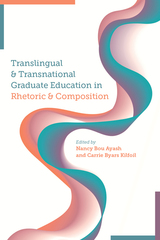 Translingual and Transnational Graduate Education in Rhetoric and Composition
Nancy Bou Ayash
Utah State University Press, 2023 Translingual and Transnational Graduate Education in Rhetoric and Composition investigates the implications of composition studies’ changing terminological and ideological landscape around language and nation for the professionalization of future university writing teacher-scholars. As the collection editors argue, incorporating translingual and transnational theories into graduate pedagogy and curricular structures is necessary if they are to shape professional practices in rhetoric and composition long term.
Contributors to the collection articulate the need for translingual and transnational sensibilities in rhetoric and composition graduate programs in light of the material conditions of graduate students’ lives and labor. They further present pathways for rethinking the design of graduate-level coursework, foreign language learning policies and labor, mentoring practices, writing teacher and writing center tutor training, and other professionalization initiatives. Offering a range of conceptually and empirically driven pieces, the collection brings together the voices and lived experiences of graduate students, faculty advisors, and administrators involved in the constant, necessary reworking of rhetoric and composition graduate education in a variety of institutional locales.
Translingual and Transnational Graduate Education in Rhetoric and Composition provides inspiration for graduate programs working to enact well-grounded curricular and pedagogical changes to counter the long-standing effects of the dominant racist and monolingualist ideologies in higher education generally, and rhetoric and composition studies specifically.
Contributors: Lucía Durá, Patricia Flores, Joe Franklin, Moisés Garcia-Renteria, Bruce Horner, Aimee Jones, Corina Lerma, Kate Mangelsdorf, Brice Nordquist, Madelyn Pawlowski, Christine Tardy, Amy Wan, Alex Way, Anselma Widha Prihandita, Joe Wilson, Xiaoye You, Emily Yuko Cousins, Michelle Zaleski
Translingual Dispositions: The Affordances of Globalized Approaches to the Teaching of Writing
Allana Frost
University Press of Colorado, 2020 Working within the framework of translanguaging, the contributors to this collection offer nuanced explorations of how translingual dispositions can be facilitated in English-medium postsecondary writing programs and classrooms. The authors and editors comprise a wide array of writing scholars from diverse teaching and learning contexts with a corresponding array of institutional, disciplinary, and pedagogical expectations and pressures. The work shared in this collection offers readers cases of translingual dispositions that consider the personal, pedagogical, and institutional challenges associated with the adoption of a translingual disposition and interrogate academic translingual practices in U.S. and international English-medium settings.
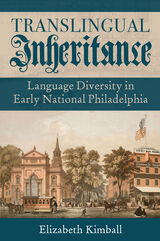 Translingual Inheritance: Language Diversity in Early National Philadelphia
Elizabeth Kimball
University of Pittsburgh Press, 2021 Honorable Mention, Rhetoric Society of America Book Award
Translingual Inheritance tells a new story of the early days of democracy in the United States, when English had not yet become the only dominant language. Drawing on translingual theory, which exposes how language use contrasts with the political constructions of named languages, Elizabeth Kimball argues that Philadelphians developed complex metalinguistic conceptions of what language is and how it mattered in their relations. In-depth chapters introduce the democratically active communities of Philadelphia between 1750 and 1830 and introduce the three most populous: Germans, Quakers (the Society of Friends), and African Americans. These communities had ways of knowing and using their own languages to create identities and serve the common good outside of English. They used these practices to articulate plans and pedagogies for schools, exercise their faith, and express the promise of the young democracy. Kimball draws on primary sources and archival texts that have been little seen or considered to show how citizens consciously took on the question of language and its place in building their young country and how such practice is at the root of what made democracy possible.
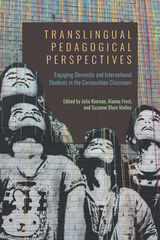 Translingual Pedagogical Perspectives: Engaging Domestic and International Students in the Composition Classroom
Julia Kiernan
Utah State University Press, 2021 Translingual Pedagogical Perspectives addresses the movement toward translingualism in the writing classroom and demonstrates the practical pedagogical strategies faculty can take to represent both domestic and international monolingual and multilingual students’ perspectives in writing programs. Contributors explore approaches used by diverse writing programs across the United States, insisting that traditional strategies used in teaching writing need to be reimagined if they are to engage the growing number of diverse learners who take composition classes.
The book showcases concrete and adaptable writing assignments from a variety of learning environments in postsecondary, English-medium writing classrooms, writing centers, and writing programs populated by monolingual and multilingual students. By providing descriptive and reflective examples of how understanding translanguaging can influence pedagogy, Translingual Pedagogical Perspectives fills the gap between theoretical inquiry surrounding translanguaging and existing translingual pedagogical models for writing classrooms and programs.
Additional appendixes provide a variety of readings, exercises, larger assignments, and other entry points, making Translingual Pedagogical Perspectives useful for instructors and graduate students interested in engaging translingual theories in their classrooms.
Contributors: Daniel V. Bommarito, Mark Brantner, Tania Cepero Lopez, Emily Cooney, Norah Fahim, Ming Fang, Gregg Fields, Mathew Gomes, Thomas Lavalle, Esther Milu, Brice Nordquist, Ghanashyam Sharma, Naomi Silver, Bonnie Vidrine-Isbell, Xiqiao Wang, Dan Zhu
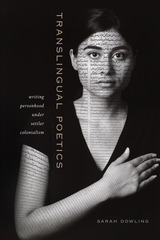 Translingual Poetics: Writing Personhood Under Settler Colonialism
Sarah Dowling
University of Iowa Press, 2018 Since the 1980s, poets in Canada and the U.S. have increasingly turned away from the use of English, bringing multiple languages into dialogue—and into conflict—in their work. This growing but under-studied body of writing differs from previous forms of multilingual poetry. While modernist poets offered multilingual displays of literary refinement, contemporary translingual poetries speak to and are informed by feminist, anti-racist, immigrant rights, and Indigenous sovereignty movements. Although some translingual poems have entered Chicanx, Latinx, Asian American, and Indigenous literary canons, translingual poetry has not yet been studied as a cohesive body of writing. The first book-length study on the subject, Translingual Poetics argues for an urgent rethinking of Canada and the U.S.’s multiculturalist myths. Dowling demonstrates that rising multilingualism in both countries is understood as new and as an effect of cultural shifts toward multiculturalism and globalization. This view conceals the continent’s original Indigenous multilingualism and the ongoing violence of its dismantling. It also naturalizes English as traditional, proper, and, ironically, native. Reading a range of poets whose work contests this “settler monolingualism”—Jordan Abel, Layli Long Soldier, Myung Mi Kim, Guillermo Gómez-Peña, M. NourbeSe Philip, Rachel Zolf, Cecilia Vicuña, and others—Dowling argues that translingual poetry documents the flexible forms of racialization innovated by North American settler colonialisms. Combining deft close readings of poetry with innovative analyses of media, film, and government documents, Dowling shows that translingual poetry’s avoidance of authentic, personal speech reveals the differential forms of personhood and non-personhood imposed upon the settler, the native, and the alien.
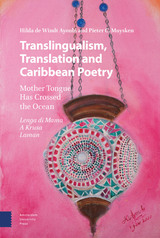 Translingualism, Translation and Caribbean Poetry: Mother Tongue Has Crossed the Ocean
Hilda de Windt Ayoubi
Amsterdam University Press, 2022 Linguists estimate that around 7,000 languages exist, but many are under threat. Translingualism, Translation and Caribbean Poetry is a multi-language collection comprising over fifty translations of the poem 'Lenga di mama' ('Mother Tongue') by Curaçao-born poet Hilda de Windt Ayoubi, published here alongside three additional poems each providing a different perspective on the mother tongue. De Windt Ayoubi's sharp, socially charged poetry has inspired translations from across the world. Collected here for the first time, they serve to protect the native languages and cultures – particularly the minority languages – of their translators, who range from expert linguists to speakers of underrepresented languages. In his accompanying essay, Pieter C. Muysken considers the role of translation in addressing the urgent cultural concern of language loss and revitalization where he discusses bilingual translations and mass translations. Complete with maps, language profiles, interviews with the translators, and the poet’s essay on Papiamento, this collection explores the emotional, cultural and intellectual importance of language conservation through poetry and translation.
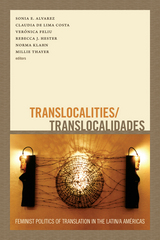 Translocalities/Translocalidades: Feminist Politics of Translation in the Latin/a Américas
Sonia E. Alvarez, Claudia de Lima Costa, Verónica Feliu, Rebecca J. Hester, Norma Klahn, and Millie Thayer, eds.
Duke University Press, 2014 Translocalities/Translocalidades is a path-breaking collection of essays on Latin American, Caribbean, and United States–based Latina feminisms and their multiple translations and cross-pollinations. The contributors come from countries throughout the Américas and are based in diverse disciplines, including media studies, literature, Chicana/o studies, and political science. Together, they advocate a hemispheric politics based on the knowledge that today, many sorts of Latin/o-americanidades—Afro, queer, indigenous, feminist, and so on—are constructed through processes of translocation. Latinidad in the South, North and Caribbean "middle" of the Américas, is constituted out of the intersections of the intensified cross-border, transcultural, and translocal flows that characterize contemporary transmigration throughout the hemisphere, from La Paz to Buenos Aires to Chicago and back again. Rather than immigrating and assimilating, many people in the Latin/a Américas increasingly move back and forth between localities, between historically situated and culturally specific, though increasingly porous, places, across multiple borders, and not just between nations. The contributors deem these multidirectional crossings and movements, and the positionalities engendered, translocalities/translocalidades.
Contributors. Sonia E. Alvarez, Kiran Asher, Victoria (Vicky) M. Bañales, Marisa Belausteguigoitia Rius, Maylei Blackwell, Cruz C. Bueno, Pascha Bueno-Hansen, Mirangela Buggs, Teresa Carrillo, Claudia de Lima Costa, Isabel Espinal, Verónica Feliu, Macarena Gómez-Barris, Rebecca J. Hester, Norma Klahn, Agustín Lao-Montes, Suzana Maia, Márgara Millán, Adriana Piscitelli, Ana Rebeca Prada, Ester R. Shapiro, Simone Pereira Schmidt, Millie Thayer
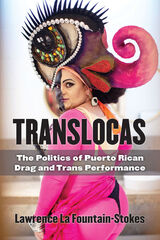 Translocas: The Politics of Puerto Rican Drag and Trans Performance
Lawrence La Fountain-Stokes
University of Michigan Press, 2021 Translocas focuses on drag and transgender performance and activism in Puerto Rico and its diaspora. Arguing for its political potential, Lawrence La Fountain-Stokes explores the social and cultural disruptions caused by Latin American and Latinx “locas” (effeminate men, drag queens, transgender performers, and unruly women) and the various forms of violence to which queer individuals in Puerto Rico and the U.S. are subjected. This interdisciplinary, auto-ethnographic, queer-of-color performance studies book explores the lives and work of contemporary performers and activists including Sylvia Rivera, Nina Flowers, Freddie Mercado, Javier Cardona, Jorge Merced, Erika Lopez, Holly Woodlawn, Monica Beverly Hillz, Lady Catiria, and Barbra Herr; television programs such as RuPaul’s Drag Race; films such as Paris Is Burning, The Salt Mines, and Mala Mala; and literary works by authors such as Mayra Santos-Febres and Manuel Ramos Otero. Lawrence La Fountain-Stokes, a drag performer himself, demonstrates how each destabilizes (and sometimes reifies) dominant notions of gender and sexuality through drag and their embodied transgender expression. These performances provide a means to explore and critique issues of race, class, poverty, national identity, and migratory displacement while they posit a relationship between audiences and performers that has a ritual-like, communal dimension. The book also analyzes the murders of Jorge Steven López Mercado and Kevin Fret in Puerto Rico, and invites readers to challenge, question, and expand their knowledge about queer life, drag, trans performance, and Puerto Rican identity in the Caribbean and the diaspora. The author also pays careful attention to transgender experience, highlighting how trans activists and performers mold their bodies, promote social change, and create community in a context that oscillates between glamour and abjection.
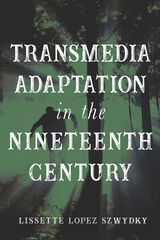 Transmedia Adaptation in the Nineteenth Century
Lissette Lopez Szwydky
Ohio State University Press, 2020 How did Mary Shelley’s Frankenstein give rise to the iconic green monster everyone knows today? In 1823, only five years after publication, Shelley herself saw the Creature come to life on stage, and this performance shaped the story’s future. Suddenly, thousands of people who had never read Shelley’s novel were participating in its cultural animation. Similarly, early adaptations magnified the reception and renown of all manner of nineteenth-century literary creations, from Byron and Keats to Dickens and Tennyson and beyond. Yet, until now, adaptation has been seen as a largely modern phenomenon.
In Transmedia Adaptation in the Nineteenth Century, Lissette Lopez Szwydky convincingly historicizes the practice of adaptation, drawing on multiple disciplines to illustrate narrative mobility across time, culture, and geography. Case studies from stage plays, literature, painting, illustration, chapbooks, and toy theaters position adaptation as a central force in literary history that ensures continued cultural relevance, accessibility, and survival. The history of these forms helps to inform and put into context our contemporary obsessions with popular media. Finally, in upending a traditional understanding of canon by arguing that adaptation creates canon and not the other way around, Szwydky provides crucial bridges between nineteenth-century literary scholarship, adaptation studies, and media studies, thus identifying new stakes for all.
 A Transmedia Archaeology of Film Promotion Online: Horror Ballyhoo and Fantastic Nostalgia
Kim Walden
Amsterdam University Press, 2025 At a time when more films are released annually than there are days in the year, films must compete for audience attention. As a result, promotional budgets have risen exponentially with online becoming the fastest growing sector. Film websites don’t just promote films, they chronicle backstories, map storyworlds, introduce characters and provide spaces for audiences to congregate. Yet as a hybrid of promotion, storytelling and community hub, these sites are ephemeral, and when the promotional work is done, they are often locked, taken down and disappear without trace. This book considers this emerging form: Where have film websites been collected and archived? What forms do these websites take? And how do audiences engage with film websites? Drawing on media archaeological methods as well as developing new strategies to investigate these intriguing media objects, this book suggests that film websites are worthy of consideration as cultural artefacts in their own right.
 A Transmedia Archaeology of Film Promotion Online: Horror Ballyhoo and Fantastic Nostalgia
Kim Walden
Amsterdam University Press, 2025 At a time when more films are released annually than there are days in the year, films must compete for audience attention. As a result, promotional budgets have risen exponentially with online becoming the fastest growing sector. Film websites don’t just promote films, they chronicle backstories, map storyworlds, introduce characters and provide spaces for audiences to congregate. Yet as a hybrid of promotion, storytelling and community hub, these sites are ephemeral, and when the promotional work is done, they are often locked, taken down and disappear without trace. This book considers this emerging form: Where have film websites been collected and archived? What forms do these websites take? And how do audiences engage with film websites? Drawing on media archaeological methods as well as developing new strategies to investigate these intriguing media objects, this book suggests that film websites are worthy of consideration as cultural artefacts in their own right.
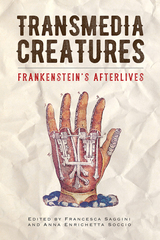 Transmedia Creatures: Frankenstein’s Afterlives
Saggini, Francesca
Bucknell University Press, 2018 On the 200th anniversary of the first edition of Mary Shelley’s Frankenstein, Transmedia Creatures presents studies of Frankenstein by international scholars from converging disciplines such as humanities, musicology, film studies, television studies, English and digital humanities. These innovative contributions investigate the afterlives of a novel taught in a disparate array of courses - Frankenstein disturbs and transcends boundaries, be they political, ethical, theological, aesthetic, and not least of media, ensuring its vibrant presence in contemporary popular culture. Transmedia Creatures highlights how cultural content is redistributed through multiple media, forms and modes of production (including user-generated ones from “below”) that often appear synchronously and dismantle and renew established readings of the text, while at the same time incorporating and revitalizing aspects that have always been central to it. The authors engage with concepts, value systems and aesthetic-moral categories—among them the family, horror, monstrosity, diversity, education, risk, technology, the body—from a variety of contemporary approaches and highly original perspectives, which yields new connections. Ultimately, Frankenstein, as evidenced by this collection, is paradoxically enriched by the heteroglossia of preconceptions, misreadings, and overreadings that attend it, and that reveal the complex interweaving of perceptions and responses it generates.
Published by Bucknell University Press. Distributed worldwide by Rutgers University Press.
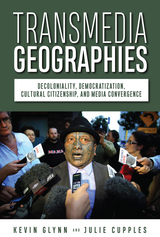 Transmedia Geographies: Decoloniality, Democratization, Cultural Citizenship, and Media Convergence
Kevin Glynn
Rutgers University Press, 2025 Looking at the US, New Zealand, and Central America, this book considers how cultural politics has been deeply reworked in our contemporary media environment. The authors analyze how rampant technological convergence has allowed stories to spill across media platforms as well as geographical borders and how those stories reemerge as transmediated events.
The authors explore the cultural politics that have developed within this new media environment by moving across the mediated landscapes of the first, third, and fourth (Indigenous people’s) worlds, which are deeply intertwined and interconnected under contemporary conditions of neoliberal globalization and emergent regimes of authoritarian postdemocracy. The book attends both to the platforms and digital networks of the new media environment and to the cultural forms and practices that have constituted television as the dominant medium of communication throughout the second half of the twentieth century. In the new media environment, transmediation works on behalf not only of those corporate megaconglomerates that have become all too familiar to media consumers around the world but also of many communities that have previously been excluded from access to the means of electronic textual production and circulation. For the latter, grassroots transmediation has become an important technique for the production of cultural citizenship.
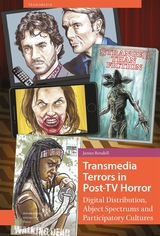 Transmedia Terrors in Post-TV Horror: Digital Distribution, Abject Spectrums and Participatory Culture
James Rendell
Amsterdam University Press, 2023 In the twenty-first century horror television has spread across the digital TV landscape, garnering mainstream appeal. Located within a transmedia matrix, Transmedia Terrors in Post-TV Horror triangulates this boom across screen content, industry practices, and online participatory cultures. Understanding the genre within a post-TV paradigm, the book readdresses what is horror television, analysing not only broadcast TV and streaming platforms but also portals such as YouTube, Twitch.TV, and apps. The book also investigates complex digital media ecologies, blurring distinctions between niche and general audience viewing practices, and fostering new circulation pathways for horror television from around the world. Undertaking netnography, the book further offers an innovative model – abject spectrums – to empirically explore myriad audience responses to TV horror, manifesting in various participatory practices including writing, imagery, and crafts. As such, the book greatly expands what is considered horror television, its formatting and circulation, and the transmedia materiality of audience engagement.
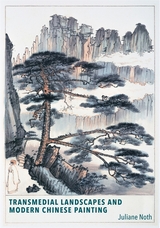 Transmedial Landscapes and Modern Chinese Painting
Juliane Noth
Harvard University Press, 2022 Chinese ink painters of the Republican period (1911–1949) creatively engaged with a range of art forms in addition to ink, such as oil painting, drawing, photography, and woodblock prints. They transformed their medium of choice in innovative ways, reinterpreting both its history and its theoretical foundations. Juliane Noth offers a new understanding of these compelling experiments in Chinese painting by studying them as transmedial practice, at once shaped by and integral to the modern global art world.
Transmedial Landscapes and Modern Chinese Painting shines a spotlight on the mid-1930s, a period of intense productivity in which Chinese artists created an enormous number of artworks and theoretical texts. The book focuses on the works of three seminal artists, Huang Binhong, He Tianjian, and Yu Jianhua, facilitating fresh insights into this formative stage of their careers and into their collaborations in artworks and publications. In a nuanced reading of paintings, photographs, and literary and theoretical texts, Noth shows how artworks and discussions about the future of ink painting were intimately linked to the reshaping of the country through infrastructure development and tourism, thus leading to the creation of a uniquely modern Chinese landscape imagery.
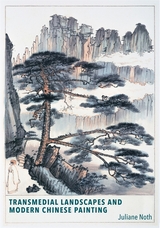 Transmedial Landscapes and Modern Chinese Painting
Juliane Noth
Harvard University Press, 2022 Chinese ink painters of the Republican period (1911–1949) creatively engaged with a range of art forms in addition to ink, such as oil painting, drawing, photography, and woodblock prints. They transformed their medium of choice in innovative ways, reinterpreting both its history and its theoretical foundations. Juliane Noth offers a new understanding of these compelling experiments in Chinese painting by studying them as transmedial practice, at once shaped by and integral to the modern global art world.
Transmedial Landscapes and Modern Chinese Painting shines a spotlight on the mid-1930s, a period of intense productivity in which Chinese artists created an enormous number of artworks and theoretical texts. The book focuses on the works of three seminal artists, Huang Binhong, He Tianjian, and Yu Jianhua, facilitating fresh insights into this formative stage of their careers and into their collaborations in artworks and publications. In a nuanced reading of paintings, photographs, and literary and theoretical texts, Noth shows how artworks and discussions about the future of ink painting were intimately linked to the reshaping of the country through infrastructure development and tourism, thus leading to the creation of a uniquely modern Chinese landscape imagery.
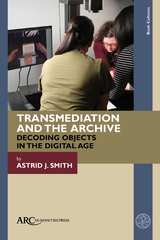 Transmediation and the Archive: Decoding Objects in the Digital Age
Astrid J. Smith
Arc Humanities Press, 2024 Building on the field of modern archival practice, Transmediation and the Archive explores the possibilities of archival objects. Investigating material as diverse as early modern printed books, death masks, a spirit photograph, and a manuscript choir book, this study interrogates not only what the objects are now, but also asks what they were before taking material form, and what they can become as their format is transferred to other media. Blending insights from museum, library, archives, and media studies with experiential research, Astrid J. Smith examines the activities that shape the making of heritage objects, and asks how an awareness of digitization practices can inform our knowledge of both their digital and physical form. She proposes a new methodological framework for evaluating the way materiality and media can affect our relationship with historical artefacts and book culture and demonstrates its fascinating application.
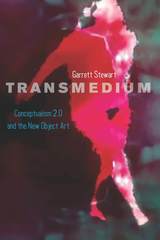 Transmedium: Conceptualism 2.0 and the New Object Art
Garrett Stewart
University of Chicago Press, 2018 If you attend a contemporary art exhibition today, you’re unlikely to see much traditional painting or sculpture. Indeed, artists today are preoccupied with what happens when you leave behind assumptions about particular media—such as painting, or woodcuts—and instead focus on collisions between them, and the new forms and ideas that those collisions generate.
Garrett Stewart in Transmedium dubs this new approach Conceptualism 2.0, an allusion in part to the computer images that are so often addressed by these works. A successor to 1960s Conceptualism, which posited that a material medium was unnecessary to the making of art, Conceptualism 2.0 features artworks that are transmedial, that place the aesthetic experience itself deliberately at the boundary between often incommensurable media. The result, Stewart shows, is art whose forced convergences break open new possibilities that are wholly surprising, intellectually enlightening, and often uncanny.
 Transmen and FTMs: Identities, Bodies, Genders, and Sexualities
Jason Cromwell
University of Illinois Press, 1999 Writing as an insider and an anthropologist, Jason Cromwell presents the first in-depth examination of what it means to be a female-bodied transperson. Through extensive participant observation and open-ended interviews, Transmen and FTMs allows female-to-male transsexuals to speak for themselves and reveal aspects of female gender diversity that do not fit into the ready-made categories of male and female.
In clarifying how transmen and FTMs define and validate their lives, as opposed to how society attempts to pigeonhole and belittle them, Cromwell shows how female-to-male transpeople have been made virtually invisible by male-dominated discourses. He considers cross-cultural data on female gender diversity, historical evidence of female-bodied people who have lived as men, and contemporary transmen and FTMs. He also addresses how FTMs and transmen are working to challenge the mental illness model of transness as well as other misconceptions.
Transmen and FTMs seeks to reframe the dialogue about gender identity and move away from regarding fixed gender categories as normative. By redefining gender diversity from a manifestation of pathology to a human condition Transmen and FTMs promotes a fuller understanding of these individuals as persons in their own right.
Transmission Loss
Chelsea Jennings
University of Massachusetts Press, 2018 In the study of sound waves and optics, the term transmission loss refers to how a signal grows weaker as it travels across distance and between objects. In this book, Chelsea Jennings reimagines the term in poems that register attenuated signals, mark presence and loss, and treat the body as an instrument sensitive to the weather of immediate experience. Threading together landscapes, abstract paintings, family heirlooms, maps, manuscripts, and photographs, these poems follow the seasons and traverse the spectrum of visible light. Vivid and precise, Transmission Loss brings us to the boundary between inside and outside, "As if what the hand knows / could be held in the hand."
The Transmission of the Text of Lucan in the Ninth Century
Harold C. Gotoff
Harvard University Press, 1971 Five complete manuscripts of Lucan, a Roman poet born in Spain in A.D. 39, exist from the ninth century. Because the manuscripts are, on the surface, closely related, a majority of them have been largely ignored. Harold Gotoff's monograph assesses the relationships apparent among these works, discussing the editorial history of Lucan and showing in great detail how the text of this important classical author was propagated during the Carolingian Renaissance. Medievalists will take particular interest in the pattern Gotoff finds in the practices and behavior of scribes and correctors in the Carolingian period.
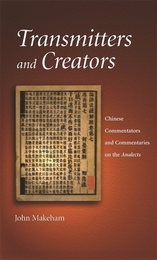 Transmitters and Creators: Chinese Commentators and Commentaries on the Analects
John Makeham
Harvard University Press, 2003 The Analects (Lunyu) is one of the most influential texts in human history. As a putative record of Confucius’s (551–479 B.C.E.) teachings and a foundational text in scriptural Confucianism, this classic was instrumental in shaping intellectual traditions in China and East Asia until the early twentieth century.
But no premodern reader read only the text of the Analects itself. Rather, the Analects was embedded in a web of interpretation that mediated its meaning. Modern interpreters of the Analects only rarely acknowledge this legacy of two thousand years of commentaries. How well do we understand prominent or key commentaries from this tradition? How often do we read such commentaries as we might read the text on which they comment? Many commentaries do more than simply comment on a text. Not only do they shape the reading of the text, but passages of text serve as pretexts for the commentator to develop and expound his own body of thought.
This book attempts to redress our neglect of commentaries by analyzing four key works dating from the late second century to the mid-nineteenth century (a period substantially contemporaneous with the rise and decline of scriptural Confucianism): the commentaries of He Yan (ca. 190–249); Huang Kan (488–545); Zhu Xi (1130–1200); and Liu Baonan (1791–1855) and Liu Gongmian (1821–1880).
Transmitting Jewish History: Yosef Hayim Yerushalmi in Conversation with Sylvie Anne Goldberg
Yosef Hayim Yerushalmi and Sylvie Anne Goldberg
Brandeis University Press, 2021 The deeply personal reflections of a giant of Jewish history.
Scholar Yosef Hayim Yerushalmi (1932–2009) possessed a stunning range of erudition in all eras of Jewish history, as well as in world history, classical literature, and European culture. What Yerushalmi also brought to his craft was a brilliant literary style, honed by his own voracious reading from early youth and his formative undergraduate studies. This series of interviews paints a revealing portrait of this giant of history, bringing together exceptional material on Yerushalmi’s personal and intellectual journeys that not only attests to the astonishing breakthrough of the issues of Jewish history into “general history,” but also offers profound insight into being Jewish in today's world.
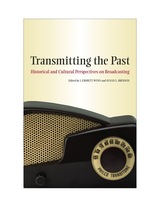 Transmitting the Past: Historical and Cultural Perspectives on Broadcasting
Edited by J. Emmett Winn and Susan L. Brinson
University of Alabama Press, 2005 Original essays exploring important developments in radio and television broadcasting
The essays included in this collection represent some of the best cultural and historical research on broadcasting in the U. S. today. Each one concentrates on a particular event in broadcast history—beginning with Marconi’s introduction of wireless technology in 1899. Michael Brown examines newspaper reporting in America of Marconi's belief in Martians, stories that effectively rendered Marconi inconsequential to the further development of radio. The widespread installation of radios in automobiles in the 1950s, Matthew Killmeier argues, paralleled the development of television and ubiquitous middle-class suburbia in America. Heather Hundley analyzes depictions of male and female promiscuity as presented in the sitcom Cheers at a time concurrent with media coverage of the AIDS crisis. Fritz Messere examines the Federal Radio Act of 1927 and the clash of competing ideas about what role radio should play in American life. Chad Dell recounts the high-brow programming strategy NBC adopted in 1945 to distinguish itself from other networks. And George Plasketes studies the critical reactions to Cop Rock, an ill-fated combination of police drama and musical, as an example of society's resistance to genre-mixing or departures from formulaic programming. The result is a collection that represents some of the most recent and innovative scholarship, cultural and historical, on the intersections of broadcasting and American cultural, political, and economic life.
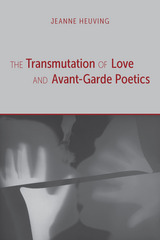 The Transmutation of Love and Avant-Garde Poetics
Jeanne Heuving
University of Alabama Press, 2016 The Transmutation of Love and Avant-Garde Poetics is a probing examination of how the writing of sexual love undergoes a radical revision by avant-garde poets in the twentieth and twenty-first centuries. Today, the exploration of love by poets—long a fixture of Western poetic tradition—is thought to be in decline, with love itself understood to be a mere ideological overlay for the more “real” entities of physical sex and desire.
In The Transmutation of Love and Avant-Garde Poetics, Jeanne Heuving claims that a key achievement of poetry by Ezra Pound, H.D., Robert Duncan, Kathleen Fraser, Nathaniel Mackey, and others lies significantly in their engagement with the synergistic relations between being in love and writing love. These poets, she argues, have traded the clichéd lover of yore for impersonal or posthuman poetic speakers that sustain the gloire and mystery of love poetry of prior centuries. As Robert Duncan writes, “There is a love in which we are outcast and vagabond from what we are that we call ‘falling in love.’”
Heuving claims that this writing of love is defining for avant-garde poetics, identifying how such important discoveries as Pound’s and H.D.’s Imagism, Pound’s Cantos, and Duncan’s “open field poetics” are derived through their changed writing of love. She draws attention to how the prevailing concept of language as material is inadequate to the ways these poets also engage language as a medium—as a conduit—enabling them to address love afresh in a time defined through preoccupations with sexuality. They engage love as immanent and change it through a writing that acts on itself.
The Transmutation of Love and Avant-Garde Poetics ascribes the waning of love poetry to its problematic form: a genre in which empowered poetic speakers constitute their speech through the objectification of comparatively disempowered subjects, or beloveds. Refusing this pervasive practice, the poets she highlights reject the delimiting, one-sided tradition of masculine lovers and passive feminine beloveds; instead, they create a more nuanced, dynamic poetics of ecstatic exploration, what Heuving calls “projective love” and “libidinized field poetics,” a formally innovative poetry, in which one perception leads directly to the next and all aspects of a poem are generative of meaning.
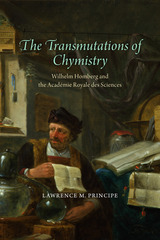 The Transmutations of Chymistry: Wilhelm Homberg and the Académie Royale des Sciences
Lawrence M. Principe
University of Chicago Press, 2020 This book reevaluates the changes to chymistry that took place from 1660 to 1730 through a close study of the chymist Wilhelm Homberg (1653–1715) and the changing fortunes of his discipline at the Académie Royale des Sciences, France’s official scientific body. By charting Homberg’s remarkable life from Java to France’s royal court, and his endeavor to create a comprehensive theory of chymistry (including alchemical transmutation), Lawrence M. Principe reveals the period’s significance and reassesses its place in the broader sweep of the history of science.
Principe, the leading authority on the subject, recounts how Homberg’s radical vision promoted chymistry as the most powerful and reliable means of understanding the natural world. Homberg’s work at the Académie and in collaboration with the future regent, Philippe II d’Orléans, as revealed by a wealth of newly uncovered documents, provides surprising new insights into the broader changes chymistry underwent during, and immediately after, Homberg. A human, disciplinary, and institutional biography, The Transmutations of Chymistry significantly revises what was previously known about the contours of chymistry and scientific institutions in the early eighteenth century.
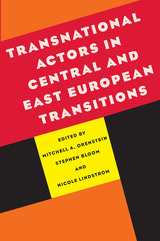 Transnational Actors in Central and East European Transitions
Mitchell Alexander Orenstein
University of Pittsburgh Press, 2008 When Vladimir Putin claimed “outside forces” were at work during the Ukrainian Orange Revolution of 2004, it was not just a case of paranoia. In this uprising against election fraud, protesters had been trained in political organization and nonviolent resistance by a Western-financed democracy building coalition. Putin's accusations were more than just a call to xenophobic impulses-they were a testament to the pervasive influence of transnational actors in the shaping of postcommunist countries.
Despite this, the role of transnational actors has been downplayed or dismissed by many theorists. Realists maintain that only powerful states assert major influence, while others argue that transnational actors affect only rhetoric, not policy outcomes. The editors of this volume contend that transnational actors have exerted a powerful influence in postcommunist transitions. They demonstrate that transitions to democracy, capitalism, and nation-statehood, which scholars thought were likely to undermine one another, were facilitated by the integration of Central and East European states into an international system of complex interdependence. Transnational actors turn out to be the “dark matter” that held the various aspects of the transition together.
Transnational actors include international governmental and nongovernmental organizations, corporations, banks, foundations, religious groups, and activist networks, among others. The European Union is the most visible transnational actor in the region, but there are many others, including the OSCE, NATO, Council of Europe, the Catholic Church, and the Soros Foundation.
Transnational Actors in Central and East European Transitions assembles leading scholars to debate the role and impact of transnational actors and presents a promising new research program for the study of this rapidly transforming region.
 Transnational Actors in War and Peace: Militants, Activists, and Corporations in World Politics
David Malet and Miriam J. Anderson, Editors
Georgetown University Press, 2017 Transnational Actors in War and Peace provides a comparative examination of a range of transnational actors who have been key to the conduct of war and peace promotion, and of how they interact with states and each other. It explores the identities, organization, strategies and influence of transnational actors involved in contentious politics, armed conflict, and peacemaking. While the study of transnational politics has been a rapidly growing field, to date, the disparate actors have not been analyzed alongside each other, making it difficult to develop a common theoretical framework or determine their influence on international security. This book brings together a diverse set of scholars focused on a range of transnational actors, such as: foreign fighters, terrorists, private military security companies, religious groups, diasporas, NGOs, and women’s peace groups. Malet and Anderson provide the standard for future study of transnational actors in this work intended for those interested in security studies, international relations, conflict resolution, and global governance.
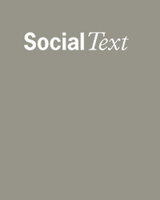 Transnational Adoption, Volume 21
Toby Alice Volkman and Cindi Katz, eds.
Duke University Press What are the implications of the massive movement of children from poor nations to the affluent West? How is adoption made possible by globalizing forces, facilitated by new media technologies such as the Internet, and inflected by the cultural politics of multiculturalism? In this special issue, scholars—several of whom are adoptive parents—from a variety of disciplines focus on the culture and politics of transnational adoption, exploring relationships between the sending and receiving nations. Until the mid-1970s, adoptive families were pressured to forget the child’s past and birth culture and to create “as if” biological families. Since then, the culture of adoption has moved dramatically toward openness, generating preoccupations with origins and loss, as well as new kinds of border-crossing movements such as orphanage visits, homeland journeys, and culture camps established by sending nations now eager to embrace the adoptees. This collection of essays examines the complex interplay of race, culture, identity, kinship, and belonging in this contemporary form of family building. Contributors. Lisa Cartwright, Claudia Fonseca, Cindi Katz, Eleana Kim, Toby Alice Volkman, Barbara Yngvesson
Transnational Aging and Reconfigurations of Kin Work
Dossa, Parin
Rutgers University Press, 2017 Transnational Aging and Reconfigurations of Kin Work documents the social and material contributions of older persons to their families in settings shaped by migration, their everyday lives in domestic and community spaces, and in the context of intergenerational relationships and diasporas. Much of this work is oriented toward supporting, connecting, and maintaining kin members and kin relationships—the work that enables a family to reproduce and regenerate itself across generations and across the globe.
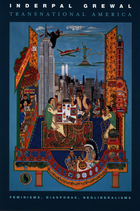 Transnational America: Feminisms, Diasporas, Neoliberalisms
Inderpal Grewal
Duke University Press, 2005 In Transnational America, Inderpal Grewal examines how the circulation of people, goods, social movements, and rights discourses during the 1990s created transnational subjects shaped by a global American culture. Rather than simply frame the United States as an imperialist nation-state that imposes unilateral political power in the world, Grewal analyzes how the concept of “America” functions as a nationalist discourse beyond the boundaries of the United States by disseminating an ideal of democratic citizenship through consumer practices. She develops her argument by focusing on South Asians in India and the United States. Grewal combines a postcolonial perspective with social and cultural theory to argue that contemporary notions of gender, race, class, and nationality are linked to earlier histories of colonization. Through an analysis of Mattel’s sales of Barbie dolls in India, she discusses the consumption of American products by middle-class Indian women newly empowered with financial means created by India’s market liberalization. Considering the fate of asylum-seekers, Grewal looks at how a global feminism in which female refugees are figured as human rights victims emerged from a distinctly Western perspective. She reveals in the work of three novelists who emigrated from India to the United States—Bharati Mukherjee, Chitra Banerjee Divakaruni, and Amitav Ghosh—a concept of Americanness linked to cosmopolitanism. In Transnational America Grewal makes a powerful, nuanced case that the United States must be understood—and studied—as a dynamic entity produced and transformed both within and far beyond its territorial boundaries.
 Transnational Asia Pacific: Gender, Culture, and the Public Sphere
Edited by Shirley Geok-lin Lim, Larry E. Smith, and Wimal Dissanayake
University of Illinois Press, 1999 From fiddle tunes to folk ballads, from banjos to blues, traditional music thrives in the remote mountains and hollers of West Virginia. For a quarter century, Goldenseal magazine has given its readers intimate access to the lives and music of folk artists from across this pivotal state. Now the best of Goldenseal is gathered for the first time in this richly illustrated volume. Some of the country's finest folklorists take us through the backwoods and into the homes of such artists as fiddlers Clark Kessinger and U.S. Senator Robert Byrd, recording stars Lynn Davis and Molly O'Day, dulcimer master Russell Fluharty, National Heritage Fellowship recipient Melvin Wine, bluesman Nat Reese, and banjoist Sylvia O'Brien.
The most complete survey to date of the vibrant strands of this music and its colorful practitioners, Mountains of Music delineates a unique culture where music and music making are part of an ancient and treasured heritage. The sly humor, strong faith, clear regional identity, and musical convictions of these performers draw the reader into families and communities bound by music from one generation to another. For devotees as well as newcomers to this infectiously joyous and heartfelt music, Mountains of Music captures the strength of tradition and the spontaneous power of living artistry.
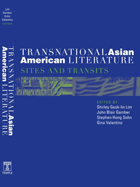 Transnational Asian American Literature: Sites and Transits
edited by Shirley Geok-lin Lim, John Blair Gamber, Stephen Hong Sohn and Gina Valentino
Temple University Press, 2005 Transnational Asian American Literature: Sites and Transits examines the diasporic and transnational aspects of Asian American literature and asserts the importance of a globalized imaginary in what has been considered an ethnic subgenre of American literature. The thirteen essays in this volume engage works of prose and poetry as aesthetic articulations of the fluid transnational identities formed by Asian American writers who move within and across national boundaries. With its emphasis on the transmigratory and flexible nature of Asian American literary production, the collection argues for an equally balanced mode of criticism that extends our readings of these works beyond the traditional limits of the American literary canon. Individual chapters feature such writers as Chang-rae Lee, Karen Tei Yamashita, Jhumpa Lahiri, Maxine Hong Kingston, and Ha Jin, with attention to such discourses as gender, space and mobility, transnationalism, identity, genre, and post-coloniality.
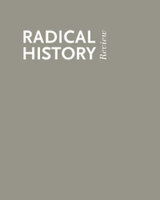 Transnational Black Studies, Volume 2003
Lisa Brock , Robin D. G. Kelley, and Karen Sotiropoulos, eds.
Duke University Press From its inception, black studies has been transnational. Pioneering intellectuals such as W. E. B. Du Bois, George Washington Williams, Anna Julia Cooper, Nicolas Guillen, C. L. R. James, Oliver Cox, and Zora Neale Hurston shared a transnational sensibility shaped by the antiracist and anti-imperialist politics of the nineteenth and twentieth centuries. In recent years, however, much scholarship regarding blackness has been presented under the rubric of pan-Africanism or the African diaspora, terms that imply an inquiry solely into what it means to be “of Africa.” Increasingly, in an era of globalization and postcolonialism, such terms have become insufficient for capturing what it means to be black in a global context. Transnational black studies—an interdisciplinary arena of knowledge rooted in political struggle—has reemerged to rectify this discursive insufficiency in contemporary scholarship. The essays, interviews, and reviews in this special issue of Radical History Review represent the best of the new of this very old tradition of transnational black studies. One contributor explores how “racial citizenship”—the idea of belonging and solidarity across the black world, developed as a result of knowledge formed out of transnational linkages—is employed by Cubans of color fighting against racial discrimination in public spaces in Havana. Another, by outlining a research agenda for the study of African slavery in the Middle East and South Asia, reminds us that the Africa diaspora is global. In a discussion of a paradigm shift from the national to the global, yet another author makes a singular contribution to this collection by locating new spaces for identity formation “in transit.” Contributors. Martha Biondi, Anthony Bogues, Ashley Dawson, James Early, Mary F. E. Ebeling, Kevin Gaines, Van Gosse, Frank A. Guridy, Joseph E. Harris, Douglas M. Haynes, Joseph Heathcott, Harvey Neptune, Michelle Stephens
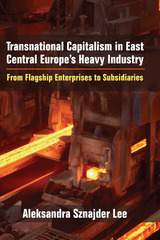 Transnational Capitalism in East Central Europe's Heavy Industry: From Flagship Enterprises to Subsidiaries
Aleksandra Sznajder Lee
University of Michigan Press, 2016 Focusing on the steel industry during the post-communist transition from 1989 through 2009, Aleksandra Sznajder Lee traces the transformation of flagship state enterprises in the Czech Republic, Poland, Romania, and Slovakia into the subsidiaries of large, international corporations. By analyzing this transformation at the three levels of enterprise, sector, and national-international nexus, she identifies the players—from international investors and European Union members to national labor unions and local industry managers—in the political economy of reform. Even in the midst of the transition to a capitalist, democratic system, Sznajder Lee finds, the state plays a key role in mediating between domestic vested interests and external pressures from international financial markets and institutions, on the one hand, and regional institutions on the other. Whereas state power may be employed to require domestic firms to operate as capitalists in the international market, it may also be used to shield enterprises from market pressures in order to promote the political and personal preferences of the elite.
This book has broad implications for the political economy of reform because it illuminates the political determinants of privatization and the resources used to resist it. In addition, Sznajder Lee sheds new light on why some countries are more likely than others to be subject to external constraints, such as IMF conditionality, and how some allegedly pro-market reformers manage to maintain public ownership over certain industry sectors.
Transnational Celebrity Activism in Global Politics: Changing the World?
Edited by Liza Tsaliki, Christos A. Frangonikolopoulos, and Asteris Huliaras
Intellect Books, 2011 In recent years, celebrities from George Clooney to Bono to Angelina Jolie have attempted to play an increasingly important role in global politics. Celebrity activism is an ever-growing, internationally visible phenomenon—yet the impact of these high-profile humanitarians on public awareness, government support, and mobilization of resources remains under-researched. Bringing together a diverse group of contributors from media studies and public diplomacy, Transnational Celebrity Activism in Global Politics aims to fill that void with a new interdisciplinary framework for the analysis of celebrity activism in international relations.
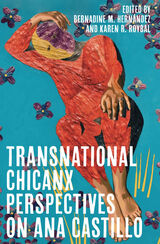 Transnational Chicanx Perspectives on Ana Castillo
Bernadine Hernández and Karen Roybal
University of Pittsburgh Press, 2021 For more than forty years, Chicana author Ana Castillo has produced novels, poems, and critical essays that forge connections between generations; challenge borders around race, gender, and sexuality; and critically engage transnational issues of space, identity, and belonging. Her contributions to Latinx cultural production and to Chicana feminist thought have transcended and contributed to feminist praxis, ethnic literature, and border studies throughout the Americas. Transnational Chicanx Perspectives on Ana Castillo is the first edited collection that focuses on Castillo’s oeuvre, which directly confronts what happens in response to cultural displacement, mixing, and border crossing. Divided into five sections, this collection thinks about Castillo’s poetics, language, and form, as well as thematic issues such as borders, immigration, gender, sexuality, and transnational feminism. From her first political poetry, Otro Canto, published in 1977, to her mainstream novels such as The Mixquiahuala Letters, So Far From God, and The Guardians, this collection aims to unravel how Castillo’s writing impacts people of color around the globe and works in solidarity with other third world feminisms.
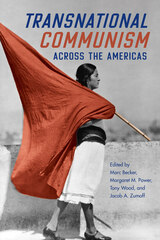 Transnational Communism across the Americas
Edited by Marc Becker, Margaret Power, Tony Wood, and Jacob A. Zumoff
University of Illinois Press, 2023 Transnational Communism across the Americas offers an innovative approach to the study of Latin American communism. It convincingly illustrates that communist parties were both deeply rooted in their own local realities and maintained significant relationships with other communists across the region and around the world. The essays in this collection use a transnational lens to examine the relationships of the region’s communist parties with each other, their international counterparts, and non-communist groups dedicated to anti-imperialism, women’s rights, and other causes. Topics include the shifting relationship between Mexican communists and the Comintern, Black migrant workers in the Caribbean, race relations in Cuba, Latin American communists in the USSR, Luís Carlos Prestes in Brazil, the U.S. and Puerto Rican communist and Nationalist parties, peace activist networks in Latin America, communist women in Guatemala, transnational student groups, and guerrillas in El Salvador. Contributors: Marc Becker, Jacob Blanc, Tanya Harmer, Patricia Harms, Lazar Jeifets, Victor Jeifets, Adriana Petra, Margaret M. Power, Frances Peace Sullivan, Tony Wood, Kevin A. Young, and Jacob Zumoff
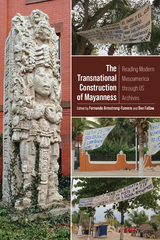 The Transnational Construction of Mayanness: Reading Modern Mesoamerica through US Archives
Fernando Armstrong-Fumero
University Press of Colorado, 2023 The Transnational Construction of Mayanness explores how US academics, travelers, officials, and capitalists contributed to the construction of the Maya as an area of academic knowledge and affected the lives of the Maya peoples who were the subject of generations of anthropological research from the mid-nineteenth century to the present. Expanding discussions of the neocolonial relationship between the US and its southern neighbors and emphasizing little-studied texts virtually inaccessible to those in Mexico and Central America, this is the first and only set of comparative studies to bring in US-based documentary collections as an enriching source of evidence.
Contributors tap documentary, ethnographic, and ethnoarchaeological sources from North America to expand established categories of fieldwork and archival research conducted within the national spaces of Mexico and Central America. A particularly rich and diverse set of case studies interrogate the historical processes that remove sources from their place of production in the “field” to the US, challenge the conventional wisdom regarding the geography of data sources that are available for research, and reveal a range of historical relationships that enabled US actors to shape the historical experience of Maya-speaking peoples.
The Transnational Construction of Mayanness offers rich insight into transnational relations and suggests new avenues of research that incorporate an expanded corpus of materials that embody the deep-seated relationship between Maya-speaking peoples and various gringo interlocutors. The work is an important bridge between Mayanist anthropology and historiography and broader literatures in American, Atlantic, and Indigenous studies.
Contributors: David Carey, M. Bianet Castellanos, Matilde Córdoba Azcárate, Lydia Crafts, John Gust, Julio Cesar Hoil Gutierréz, Jennifer Mathews, Matthew Watson
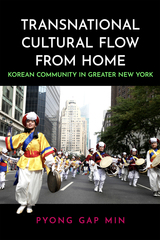 Transnational Cultural Flow from Home: Korean Community in Greater New York
Pyong Gap Min
Rutgers University Press, 2023 When the first wave of post-1965 Korean immigrants arrived in the New York-New Jersey area in the early 1970s, they were reliant on retail and service businesses in the minority neighborhoods where they were. This caused ongoing conflicts with customers in black neighborhoods of New York City, with white suppliers at Hunts Point Produce Market, and with city government agencies that regulated small business activities. In addition, because of the times, Korean immigrants had very little contact with their homeland. Korean immigrants in the area were highly segregated from both the mainstream New York society and South Korea. However, after the 1990 Immigration Act, Korean immigrants with professional and managerial backgrounds have found occupations in the mainstream economy. Korean community leaders also engaged in active political campaigns to get Korean candidates elected as city council members and higher levels of legislative positions in the area. The Korean community's integration into mainstream society also increasingly developed stronger transnational ties to their homeland and spurred the inclusion of "everyday Korean life" in the NY-NJ area.
Transnational Cultural Flow from Home examines New York Korean immigrants’ collective efforts to preserve their cultural traditions and cultural practices and their efforts to transmit and promote them to New Yorkers by focusing on the Korean cultural elements such as language, foods, cultural festivals, and traditional and contemporary performing arts.
This publication was supported by the 2022 Korean Studies Grant Program of the Academy of Korean Studies (AKS-2022-P-009).
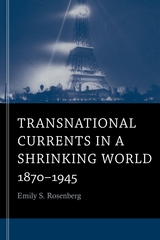 Transnational Currents in a Shrinking World: 1870–1945
Emily S. Rosenberg
Harvard University Press, 2014 Transnational Currents in a Shrinking World examines the wide variety of social and cultural networks that emerged from the global exchanges of the late-nineteenth and twentieth centuries. Emily Rosenberg shows how transnational connections were being formed many decades before “globalization” became a commonplace term in economic and political discourse.
Suggesting crisscrossing flows of power, “currents” provide an especially apt metaphor for transnational exchanges in the age of the telegraph and incandescent light bulb. Rosenberg traces the internationalizing currents that impelled a desire to create global rule-setting institutions, from the Universal Postal Union to the International Olympic Committee to the League of Nations. Other transnational currents coalesced around social networks of class, ethnic, gender, and religious affiliations; around exhibitions such as world fairs, museums, and botanical gardens; around networks of expertise in engineering, medicine, social science, and urban planning; and around mass media and cultures of consumption.
Rosenberg suggests that these currents brought a modernity that mixed faith in the rationality of science and technology with a fascination for emotional and spectacle-driven entertainments. In this age of nationalism and imperialism, they both assisted and disrupted ambitions for territorial expansion; they ushered in a new world in which fast-moving technologies of representation brought multiple and shifting codes of meaning. Often overlooked in histories centered on nation-states, transnational currents highlight the irregular patterns of global change and underscore the fluidity of spatial and personal identifications in the period from 1870 to the end of World War II.
 Transnational Desires: Brazilian Erotic Dancers in New York
Suzana Maia
Vanderbilt University Press, 2012 Migrant sex workers are commonly cast as victims, moved by desperation to flee poverty and hopelessness in their home country. The Brazilian erotic dancers Suzana Maia presents in Transnational Desires, however, are women from the Brazilian middle classsome of them welleducated professionalswho migrated to the United States not just to better themselves economically but also to realize their personal dreams. Their motivation to migrate and to work as erotic dancers can also be understood in the context of a representational system, inaugurated in colonial times, that emphasizes the exoticism of Brazilian womentheir bodies, their skin tone, their sexuality. These stereotypes are the props that Brazilian women use to construct their performances in Manhattan and Queens gentlemen's bars and the language through which they negotiate their relationships to society at large. Transnational Desires focuses on the lives of nine Brazilian dancers with whom the author, herself a middleclass Brazilian, developed close relationships over the years. Maia examines their social relations both in the bar scene and with family, friends, and lovers outside. She shows that for these women erotic dancing is part of a life trajectory that involves negotiating their social position and life prospects in a fundamentally transnational social universe.
Transnational Ecocinema: Film Culture in an Era of Ecological Transformation
Edited by Tommy Gustafsson and Pietari Kääpä
Intellect Books, 2013 Discussion of Hollywood film has dominated much of the contemporary dialogue on ecocriticism and the cinema—until now. With Transnational Ecocinemas, the editors open up the critical debate to look at a larger variety of films from many different countries and cultures. By foregrounding these films with their economic and political contexts, the contributors offer a more comprehensive and nuanced look at the role of place in ecocinema. The essays also interrogate proposed global solutions to environmental issues by presenting an ecocritical perspective on different film cultural considerations from around the globe.
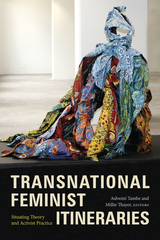 Transnational Feminist Itineraries: Situating Theory and Activist Practice
Ashwini Tambe and Millie Thayer, editors
Duke University Press, 2021 Transnational Feminist Itineraries brings together scholars and activists from multiple continents to demonstrate the ongoing importance of transnational feminist theory in challenging neoliberal globalization and the rise of authoritarian nationalisms around the world. The contributors illuminate transnational feminism's unique constellation of elements: its specific mode of thinking across scales, its historical understanding of identity categories, and its expansive imagining of solidarity based on difference rather than similarity. Contesting the idea that transnational feminism works in opposition to other approaches—especially intersectional and decolonial feminisms—this volume instead argues for their complementarity. Throughout, the contributors call for reaching across social, ideological, and geographical boundaries to better confront the growing reach of nationalism, authoritarianism, and religious and economic fundamentalism.
Contributors. Mary Bernstein, Isabel Maria Cortesão Casimiro, Rafael de la Dehesa, Carmen L. Diaz Alba, Inderpal Grewal, Cricket Keating, Amy Lind, Laura L. Lovett, Kathryn Moeller, Nancy A. Naples, Jennifer C. Nash, Amrita Pande, Srila Roy, Cara K. Snyder, Ashwini Tambe, Millie Thayer, Catarina Casimiro Trindade
 Transnational Film Culture in New Zealand
Simon Sigley
Intellect Books, 2013 In this innovative work of cultural history, Simon Sigley tells the story of film culture in New Zealand from the establishment of the Auckland Film Society in the 1920s to the present day. Rather than focusing on the work of individual filmmakers, Sigley approaches cinema as a form of social practice. He examines the reception of international film theories and discourses and shows how these ideas helped to shape distinct cultural practices, including new forms of reviewing; new methods of teaching; and new institutions such as film societies, art house cinemas, and film festivals. He goes on to trace the emergence in New Zealand of the full range of activities and institutions associated with a sophisticated film culture—including independent distribution and exhibition networks, film archives, university courses, a local feature film industry, and liberalized film censorship. In doing so, Sigley makes a significant contribution to our understanding of the myriad ways film can shape our thinking, our icons, our institutions, and our conversations. A fascinating case history of how a culture can develop, Transnational Film Culture in New Zealand will be a welcome addition to the bookshelves of anyone interested in film culture and cultural history.
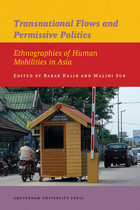 Transnational Flows and Permissive Polities: Ethnographies of Human Mobilities in Asia
Edited by Barak Kalir and Malini Sur
Amsterdam University Press, 2012 This book is a collection of ethnographies of transnational migration and border crossings in Asia. Interdisciplinary in scope, it addresses issues of mobility and Diaspora from various vantage points. Unique to this volume is an emphasis of studying globalisation from below, privileging the narratives and views of “people on the move” – or the transnational underclass – and their sense of belonging to places and communities. The collection is further distinguished by its focus on the sources of authority and the social configurations that are created in the intersections between legality and illegality across Asia. Though previous studies on transnational flows have deconstructed the notion of nation-states as having fixed political boundaries, and have engaged in spaces beyond the nation-states, seldom has an entire region, Asia, been privileged in one integrated volume. We emphasize hitherto marginalized debates that have significant policy relevance. Other than a serious academic interest from lecturers and students, we are confident that book will be of significant interest for development practitioners and NGOs.
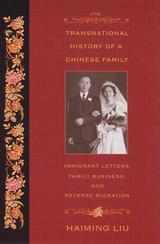 The Transnational History of a Chinese Family: Immigrant Letters, Family Business, and Reverse Migration
Liu, Haiming
Rutgers University Press, 2005 Family and home are one word—jia—in the Chinese language. Family can be separated and home may be relocated, but jia remains intact. It signifies a system of mutual obligation, lasting responsibility, and cultural values. This strong yet flexible sense of kinship has enabled many Chinese immigrant families to endure long physical separation and accommodate continuities and discontinuities in the process of social mobility. Based on an analysis of over three thousand family letters and other primary sources, including recently released immigration files from the National Archives and Records Administration, Haiming Liu presents a remarkable transnational history of a Chinese family from the late nineteenth century to the 1970s. For three generations, the family lived between the two worlds. While the immigrant generation worked hard in an herbalist business and asparagus farming, the younger generation crossed back and forth between China and America, pursuing proper education, good careers, and a meaningful life during a difficult period of time for Chinese Americans. When social instability in China and hostile racial environment in America prevented the family from being rooted in either side of the Pacific, transnational family life became a focal point of their social existence. This well-documented and illustrated family history makes it clear that, for many Chinese immigrant families, migration does not mean a break from the past but the beginning of a new life that incorporates and transcends dual national boundaries. It convincingly shows how transnationalism has become a way of life for Chinese American families.
Transnational Intellectual Networks: Forms of Academic Knowledge and the Search for Cultural Identities
Edited by Christophe Charle, Jürgen Schriewer, and Peter Wagner
Campus Verlag, 2004 The university system, both in America and abroad, has always claimed a universal significance for its research and educational models. At the same time, many universities, particularly in Europe, have also claimed another role—as custodians of national culture. Transnational Intellectual Networks explores this apparent contradiction and its resulting intellectual tensions with illuminating essays that span the nineteenth- and early-twentieth-century nationalization movements in Europe through the postwar era.
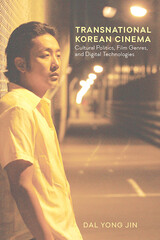 Transnational Korean Cinema: Cultural Politics, Film Genres, and Digital Technologies
Dal Yong Jin
Rutgers University Press, 2020 In Transnational Korean Cinema author Dal Yong Jin explores the interactions of local and global politics, economics, and culture to contextualize the development of Korean cinema and its current place in an era of neoliberal globalization and convergent digital technologies.
The book emphasizes the economic and industrial aspects of the story, looking at questions on the interaction of politics and economics, including censorship and public funding, and provides a better view of the big picture by laying bare the relationship between film industries, the global market, and government. Jin also sheds light on the operations and globalization strategies of Korean film industries alongside changing cultural policies in tandem with Hollywood’s continuing influences in order to comprehend the power relations within cultural politics, nationally and globally. This is the first book to offer a full overview of the nascent development of Korean cinema.
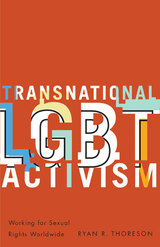 Transnational LGBT Activism: Working for Sexual Rights Worldwide
Ryan R. Thoreson
University of Minnesota Press, 2014 The International Gay and Lesbian Human Rights Commission (IGLHRC) was founded in 1990 as the first NGO devoted to advancing LGBT human rights worldwide. How, this book asks, is that mission translated into practice? What do transnational LGBT human rights advocates do on a day-to-day basis and for whom? Understanding LGBT human rights claims is impossible, Ryan R. Thoreson contends, without knowing the answers to these questions. In Transnational LGBT Activism, Thoreson argues that the idea of LGBT human rights is not predetermined but instead is defined by international activists who establish what and who qualifies for protection. He shows how IGLHRC formed and evolved, who is engaged in this work, how they conceptualize LGBT human rights, and how they have institutionalized their views at the United Nations and elsewhere. After a full year of in-depth research in New York City and Cape Town, South Africa, Thoreson is able to reconstruct IGLHRC’s early campaigns and highlight decisive shifts in the organization’s work from its founding to the present day. Using a number of high-profile campaigns for illustration, he offers insight into why activists have framed particular demands in specific ways and how intergovernmental advocacy shapes the claims that activists ultimately make. The result is a uniquely balanced, empirical response to previous impressionistic and reductive critiques of Western human rights activists—and a clarifying perspective on the nature and practice of global human rights advocacy.
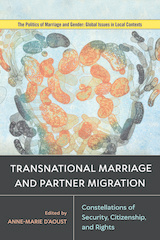 Transnational Marriage and Partner Migration: Constellations of Security, Citizenship, and Rights
Anne-Marie D'Aoust
Rutgers University Press, 2022 This multidisciplinary collection investigates the ways in which marriage and partner migration processes have become the object of state scrutiny, and the site of sustained political interventions in several states around the world. Covering cases as varied as the United States, Canada, Japan, Iran, France, Belgium or the Netherlands, among others, contributors reveal how marriage and partner migration have become battlegrounds for political participation, control, and exclusion. Which forms of attachments (towards the family, the nation, or specific individuals) have become framed as risks to be managed? How do such preoccupations translate into policies? With what consequences for those affected by them, in terms of rights and access to citizenship? The book answers these questions by analyzing the interplay between issues of security, citizenship and rights from the perspectives of migrants and policymakers, but also from actors who negotiate encounters with the state, such as lawyers, non-governmental organizations, and translators.
Transnational Migration and Asia: The Question of Return
Edited by Michiel Baas
Amsterdam University Press, 2015 As our increasingly globalized world alters the dynamics of migration, the ideas that migrants have about returning to their home countries have evolved as well. This diverse collection examines the changes and complexities of migration patterns in a range of Asian countries and cities, exploring how globalization and transnationalism shape and give meaning to the migrant experience. From Japanese-Brazilian transmigrants and Filipina students in Ireland to skilled migrants from India, the authors address migrants’ backgrounds, ambitions, and opportunities to offer intriguing insights and propose fascinating new questions about the lives of migrants in today’s world.
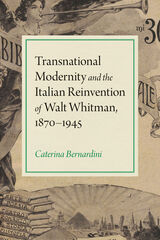 Transnational Modernity and the Italian Reinvention of Walt Whitman, 1870-1945
Caterina Bernardini
University of Iowa Press, 2021 Caterina Bernardini gauges the effects that Walt Whitman’s poetry had in Italy from 1870 to 1945: the reactions it provoked, the aesthetic and political agendas it came to sponsor, and the creative responses it facilitated. Particular attention is given to women writers and noncanonical writers often excluded from previous discussions in this area of study. Bernardini also investigates the contexts and causes of Whitman’s success abroad through the lives, backgrounds, beliefs, and imaginations of the people who encountered his work.
Studying Whitman’s reception from a transnational perspective shows how many countries were simultaneously carving out a new modernity in literature and culture. In this sense, Bernardini not only shows the interconnectedness of various international agents in understanding and contributing to the spread of Whitman’s work, but, more largely, illustrates a constellation of similar pre-modernist and modernist sensibilities. This stands in contrast to the notion of sudden innovation: modernity was not easy to achieve, and it did not imply a complete refusal of tradition. Instead, a continuous and fruitful negotiation between tradition and innovation, not a sudden break with the literary past, is at the very heart of the Italian and transnational reception of Whitman. The book is grounded in archival studies and the examination of primary documents of noteworthy discovery.
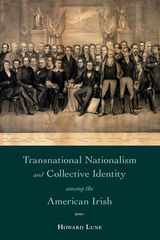 Transnational Nationalism and Collective Identity among the American Irish
Howard Lune
Temple University Press, 2020 In Transnational Nationalism and Collective Identity among the American Irish, Howard Lune considers the development and mobilization of different nationalisms over 125 years of Irish diasporic history (1791–1920) and how these campaigns defined the Irish nation and Irish citizenship. Lune takes a collective approach to exploring identity, concentrating on social identities in which organizations are the primary creative agent to understand who we are and how we come to define ourselves. As exiled Irishmen moved to the United States, they sought to create a new Irish republic following the American model. Lune traces the construction of Irish American identity through the establishment and development of Irish nationalist organizations in the United States. He looks at how networks—such as societies, clubs, and private organizations—can influence and foster diaspora, nationalism, and nationalist movements. By separating nationalism from the physical nation, Transnational Nationalism and Collective Identity among the American Irish uniquely captures the processes and mechanisms by which collective identities are constructed, negotiated, and disseminated. Inevitably, this work tackles the question of what it means to be Irish—to have a nationality, a community, or a shared history.
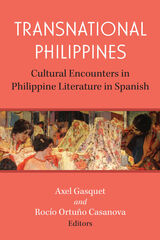 Transnational Philippines: Cultural Encounters in Philippine Literature in Spanish
Axel Gasquet and Rocío Ortuño Casanova, Editors
University of Michigan Press, 2024 Transnational Philippines: Cultural Encounters in Philippine Literature in Spanish approaches literature that has been forgotten or neglected in studies on other literatures in Spanish due, in part, to the fact that today Spanish is no longer spoken in the Philippines or in Asia. However, isolation has not always been the case, and by omitting Philippine literature in Spanish from the picture of world literatures and Spanish-language literatures, the landscape of these disciplines is incomplete. Transnational Philippines studies how this literary production stemmed from its relationship with other cultures, literature, and arts. It attempts to break this literature’s isolation and show how it is part of the broad literary system of literature written in Spanish.
Yet Transnational Philippines also questions the constraints of traditional literary genres in order to make room for Philippine texts and other colonial and postcolonial texts, so that those texts can be taken into consideration in literary studies. Its chapters elaborate on the problems surrounding the cultural and identity relations of the Philippines with other regions and the literary nature of Philippine texts. By addressing the need for a postnational approach to Spanish-language Philippine literature, the book challenges the Spain/Latin America dichotomy existing in Spanish language literary studies and leans toward a global conception of the Hispanophone.
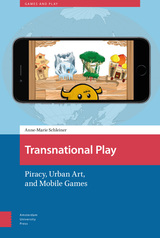 Transnational Play: Piracy, Urban Art, and Mobile Games
Anne-Marie Schleiner
Amsterdam University Press, 2020 Transnational Play approaches gameplay as a set of practices and a global industry that includes diverse participation from players and developers located within the global South, in nations outside of the First World. Players experience play in game cafes, through casual games for regional and global causes like environmentalism, through piracy and cheats, via cultural localization, on their mobile phones, and through urban playful art in Latin America. This book offers a reorientation of perspective on the global developers who make games, as well as the players who consume games, while still acknowledging geographically distributed socioeconomic, racial, gender, and other inequities. Over the course of the inquiry, which includes a chapter dedicated to the cartography of the mobile augmented reality game Pokémon Go, the author develops a theoretical line of argument critically informed by gender studies and intersectionality, postcolonialism, geopolitics, and game studies, problematizing play as a diverse and contested transnational domain.
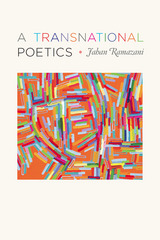 A Transnational Poetics
Jahan Ramazani
University of Chicago Press, 2009 Poetry is often viewed as culturally homogeneous—“stubbornly national,” in T. S. Eliot’s phrase, or “the most provincial of the arts,” according to W. H. Auden. But in A Transnational Poetics, Jahan Ramazani uncovers the ocean-straddling energies of the poetic imagination—in modernism and the Harlem Renaissance; in post–World War II North America and the North Atlantic; and in ethnic American, postcolonial, and black British writing. Cross-cultural exchange and influence are, he argues, among the chief engines of poetic development in the twentieth and twenty-first centuries.
Reexamining the work of a wide array of poets, from Eliot, Yeats, and Langston Hughes to Elizabeth Bishop, Lorna Goodison, and Agha Shahid Ali, Ramazani reveals the many ways in which modern and contemporary poetry in English overflows national borders and exceeds the scope of national literary paradigms. Through a variety of transnational templates—globalization, migration, travel, genre, influence, modernity, decolonization, and diaspora—he discovers poetic connection and dialogue across nations and even hemispheres.
 Transnational Political Islam: Religion, Ideology and Power
Edited by Azza Karam
Pluto Press, 2003 Political Islam, to be distinguished from Islam as a culture or a religion, and from Islamic Fundamentalism, is an increasingly important feature of the western political scene. The ideologies of Political Islam reflect the fact that some of their adherents live and work within a Western socio-political context.
Although Political Islam has been widely written about in Muslim countries, very little has been published the West, and this book attempts to redress that imbalance.
With a range of outstanding contributors that includes academics and human rights advocates this book tackles the diversity of Islamist thinking and practice in various Western countries and explores their transnational connections in both East and West.
The book analyses developments in Islamist thinking and activities, and their connections to the latest global political and economic trends, and discusses future evolutions of the ideology and its manifestations.
Transnational Political Spaces: Agents - Structures - Encounters
Edited by Mathias Albert, Gesa Bluhm, Jan Helmig, Andreas Leutzsch, and Jochen W
Campus Verlag, 2009 From a decidedly multidisciplinary perspective, the articles in Transnational Political Spaces address the notion that political space is no longer fully congruent with national borders. Instead there are areas called transnational political spaces—caused by factors such as migration and social transformation—where policy occurs oblivious to national pressure. Organized into three sections—transnational actors, transnational spaces, and critical encounters—this volume explains how these spaces are formed and defined and how they can be traced and conceptualized.
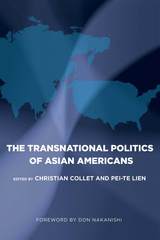 The Transnational Politics of Asian Americans
edited by Christian Collet and Pei-te Lien, foreword by Don Nakanishi
Temple University Press, 2009 As America’s most ethnically diverse foreign-born population, Asian Americans can puzzle political observers. This volume’s multidisciplinary team of contributors employ a variety of methodologies— including quantitative, ethnographic, and historical—to illustrate how transnational ties between the U.S. and Asia have shaped, and are increasingly defining, Asian American politics in our multicultural society. Original essays by U.S.- and Asian-based scholars discuss Cambodian, Chinese, Filipino, Indian, Japanese, Korean, and Vietnamese communities from Boston to Honolulu. The volume also shows how the grassroots activism of America's "newest minority" both reflects and is instrumental in broader processes of political change throughout the Pacific. Addressing the call for more global approaches to racial and ethnic politics, contributors describe how Asian immigrants strategically navigate the hurdles to domestic incorporation and equality by turning their political sights and energies toward Asia. These essays convincingly demonstrate that Asian American political participation in the U.S. does not consist simply of domestic actions with domestic ends. Contributors include: Eiichiro Azuma, Augusto Espiritu, Hiroko Furuya, Peter Kiang, Ikumi Koakutsu, Michel Laguerre, Sangay Mishra, Hiromi Monobe, Shirley Tang, Tritia Toyota, Janelle Wong, and the editors.
Transnational Professionals and their Cosmopolitan Universes
Magdalena Nowicka
Campus Verlag, 2006 This book focuses on the relationship between physical space and social mobility, focusing on the new phenomenon of the “international professional” who makes the world his home. Mobile people, Magdalena Nowicka reveals, create their own spatial and cultural universes through daily routines and practices. Even the choice of a specific residence, Nowicka shows, has definite local and global consequences. Grounded in the influential theories of Ulrich Beck as well as the latest research in the sociology of space, Transnational Professionals and their Cosmopolitan Universes is an important contribution to continuing debates on globalization and sociology.
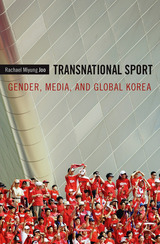 Transnational Sport: Gender, Media, and Global Korea
Rachael Miyung Joo
Duke University Press, 2012 Based on ethnographic research in Seoul and Los Angeles, Transnational Sport tells how sports shape experiences of global Koreanness, and how those experiences are affected by national cultures. Rachael Miyung Joo focuses on superstar Korean athletes and sporting events produced for transnational media consumption. She explains how Korean athletes who achieve success on the world stage represent a powerful, globalized Korea for Koreans within the country and those in the diaspora. Celebrity Korean women athletes are highly visible in the Ladies Professional Golf Association. In the media, these young golfers are represented as daughters to be protected within the patriarchal Korean family and as hypersexualized Asian women with commercial appeal. Meanwhile, the hard-muscled bodies of male athletes, such as Korean baseball and soccer players, symbolize Korean masculine dominance in the global capitalist arena. Turning from particular athletes to a mega-event, Joo discusses the 2002 FIFA World Cup Korea/Japan, a watershed moment in recent Korean history. New ideas of global Koreanness coalesced around this momentous event. Women and youth assumed newly prominent roles in Korean culture, and, Joo suggests, new models of public culture emerged as thousands of individuals were joined by a shared purpose.
Transnational Trajectories and Diaspora Policies: The Case of Czechia in Comparison to Poland, Hungary and Slovakia
Edited by Eva Janská
Karolinum Press, 2025 A fascinating examination of Central European diasporic policy bolstered by individual case studies of the new Czech diaspora.
The book examines diaspora policy in Central European countries in the context of changes following their accession to the EU, utilizing the Czech Republic, Slovakia, Poland, and Hungary as case studies. With a focus on the previously underexplored new Czech diaspora (i.e., the emigration of Czechs/Czechoslovaks after 1990), individual case studies provide a comprehensive description of the contemporary Czech diaspora while also elucidating key inquiries directed towards its current character and specific needs.
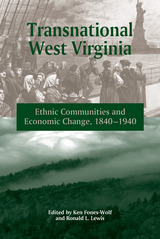 TRANSNATIONAL WEST VIRGINIA: "ETHNIC COMMUNITIES AND ECONOMIC CHANGE, 1840-1940"
KEN FONES-WOLF
West Virginia University Press, 2004 West Virginia is one of the most homogeneous states in the nation, with among the lowest ratios of foreign-born and minority populations among the states. But as this collection of historical studies demonstrates, this state was built by successive waves of immigrant labors, from the antebellum railroad builders to the twentieth-century coal miners. Transnational West Virginia offers a new understanding of how laborers and their communities shape a region's history. Transnational West Virginia includes essays and studies on immigrant networks, such as Irish workers along the B&O Railroad, Wheeling Germans in the Civil War era, Swiss immigration to West Virginia, and European Jews in Southern West Virginia. This work also covers Belgian glassworkers in West Virginia, black migration to Southern West Virginia, Italians in the Upper Kanawha Valley, Italian immigration to Marion County, Wheeling Iron and the Welsh, West Virginia and immigrant labor to 1920, Monongalia miners between the World Wars, and West Virginia rubber workers in Akron. Transnational West Virginia is the first volume in the West Virginia and Appalachia series, which is under the general editorship of West Virginia University Stuart and Joyce Robbins Chair of History Ronald L. Lewis. Kenneth Fones-Wolf, Associate Professor of History at WVU, also helped edit this collection of essays by ten distinguished scholars.
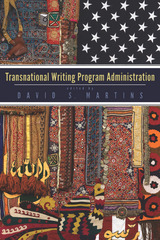 Transnational Writing Program Administration
David S. Martins
Utah State University Press, 2014 While local conditions remain at the forefront of writing program administration, transnational activities are slowly and thoroughly shifting the questions we ask about writing curricula, the space and place in which writing happens, and the cultural and linguistic issues at the heart of the relationships forged in literacy work. Transnational Writing Program Administration challenges taken-for-granted assumptions regarding program identity, curriculum and pedagogical effectiveness, logistics and quality assurance, faculty and student demographics, innovative partnerships and research, and the infrastructure needed to support writing instruction in higher education. Well-known scholars and new voices in the field extend the theoretical underpinnings of writing program administration to consider programs, activities, and institutions involving students and faculty from two or more countries working together and highlight the situated practices of such efforts. The collection brings translingual graduate students at the forefront of writing studies together with established administrators, teachers, and researchers and intends to enrich the efforts of WPAs by examining the practices and theories that impact our ability to conceive of writing program administration as transnational. This collection will enable writing program administrators to take the emerging locations of writing instruction seriously, to address the role of language difference in writing, and to engage critically with the key notions and approaches to writing program administration that reveal its transnationality.
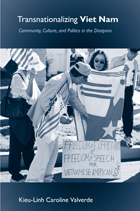 Transnationalizing Viet Nam: Community, Culture, and Politics in the Diaspora
Kieu-Linh Caroline Valverde
Temple University Press, 2013 Vietnamese diasporic relations affect—and are directly affected by—events in Viet Nam. In Transnationalizing Viet Nam, Kieu-Linh Caroline Valverde explores these connections, providing a nuanced understanding of this globalized community. Valverde draws on 250 interviews and almost two decades of research to show the complex relationship between Vietnamese in the diaspora and those back at the homeland. Arguing that Vietnamese immigrant lives are inherently transnational, she shows how their acts form virtual communities via the Internet, organize social movements, exchange music and create art, find political representation, and even dissent. Valverde also exposes how generational, gender, class, and political tensions threaten to divide the ethnic community.
Transnationalizing Viet Nam paints a vivid picture of the complex political and personal allegiances that exist within Vietnamese America and shape the relations between this heterogeneous community and its country of origin.
In the series Asian American History and Culture, edited by Sucheng Chan, David Palumbo-Liu, Michael Omi, K. Scott Wong, and Linda Trinh Võ
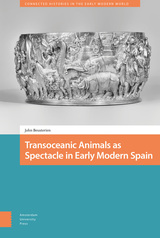 Transoceanic Animals as Spectacle in Early Modern Spain
John Beusterien
Amsterdam University Press, 2020 Animal spectacles are vital to a holistic appreciation of Spanish culture. In Transoceanic Animals as Spectacle in Early Modern Spain, Beusterien christens five previously unnamed animals, each of which was a protagonist in a spectacle: Abada, the rhinoceros; Hawa’i, the elephant; Fuleco, the armadillo; Jarama, the bull; and Maghreb, the lion. In presenting and analyzing their stories, Beusterien enriches our understanding of the role of animals in the development of commercial theater in Spain and in the modern bullfight. He also contributes to growing scholarly conversations on the importance of Spain in the history of science by examining how animal spectacles had profound repercussions on the emergence of the modern zoo and natural history museum. Combining scholarly content analysis and pedagogical sagacity, the book has a broad appeal for scholars of the early modern Spanish Empire, animal studies scholars, and secondary and postsecondary instructors looking for engaging exercises and information for their Spanish language, culture, and history students.
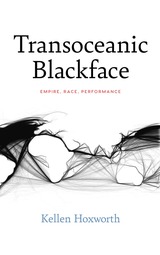 Transoceanic Blackface: Empire, Race, Performance
Kellen Hoxworth
Northwestern University Press, 2024 A sweeping history of racialized performance across the Anglophone imperial world from the eighteenth to the early twentieth century
A material history of racialized performance throughout the Anglophone imperial world, Transoceanic Blackface: Empire, Race, Performance revises prevailing understandings of blackface and minstrelsy as distinctively US American cultural practices. Tracing intertwined histories of racialized performance from the mid-eighteenth through the early twentieth century across the United States and the British Empire, this study maps the circulations of blackface repertoires in theatrical spectacles, popular songs, visual materials, comic operas, closet dramas, dance forms, and Shakespearean burlesques.
Kellen Hoxworth focuses on overlooked performance histories, such as the early blackface minstrelsy of T. D. Rice’s “Jump Jim Crow” and the widely staged blackface burlesque versions of Othello, as traces of the racial and sexual anxieties of empire. From the nascent theatrical cultures of Australia, Britain, Canada, India, Jamaica, South Africa, and the United States, Transoceanic Blackface offers critical insight into the ways racialized performance animated the imperial “common sense” of white supremacy on a global scale.
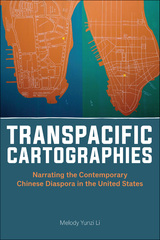 Transpacific Cartographies: Narrating the Contemporary Chinese Diaspora in the United States
Melody Yunzi Li
Rutgers University Press, 2024 Transpacific Cartographies examines how contemporary Chinese diasporic narratives address the existential loss of home for immigrant communities at a time of global precarity and amid rising Sino-US tensions. Focusing on cultural productions of the Chinese diaspora from the 1990s to the present -- including novels by the Sinophone writers Yan Geling (The Criminal Lu Yanshi), Shi Yu (New York Lover), Chen Qian (Listen to the Caged Bird Sing), and Rong Rong (Notes of a Couple), as well as by the Anglophone writer Ha Jin (A Free Life; A Map of Betrayal), selected TV shows (Beijinger in New York; The Way We Were), and online literature -- Melody Yunzi Li argues that the characters in these stories create multilayered maps that transcend the territorial boundaries that make finding a home in a foreign land a seemingly impossible task. In doing so, these “maps” outline a transpacific landscape that reflects the psycho-geography of homemaking for diasporic communities. Intersecting with and bridging Sinophone studies, Chinese American studies, and diaspora studies and drawing on theories of literary cartography, Transpacific Cartographies demonstrates how these “maps” offer their readers different paths for finding a sense of home no matter where they are.
 Transpacific Experiments: Intermedia Art and Music in 1960s Japan
Miki Kaneda
University of Michigan Press, 2026 Intermedia art—an avant-garde multimedia practice that combines sound and moving images–took root in Japan alongside other places in the 1960s. In Transpacific Experiments, Miki Kaneda analyzes intermedia as a practice that gives form to errant possibilities, unfolding in spaces of the everyday, to offer nuanced insights into the global flow of ideas, influence, and discourses of appropriation. The stories of intermedia art throughout the study offer feminist and transnational perspectives on experimental music and art that disorient existing narratives about the experimental and political in unexpected ways.
Transpacific Experiments contends that social, cultural, and political arrangements local to Japan had a greater influence on the transnational experimental music scene than previously acknowledged. Her perspective extends, exceeds, and at times unsettles these frameworks about experimental practices, revealing the limitations of any single political or aesthetic lens.
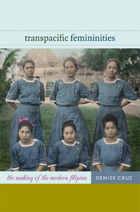 Transpacific Femininities: The Making of the Modern Filipina
Denise Cruz
Duke University Press, 2012 In this groundbreaking study, Denise Cruz investigates the importance of the figure she terms the "transpacific Filipina" to Philippine nationalism, women's suffrage, and constructions of modernity. Her analysis illuminates connections between the rise in the number of Philippine works produced in English and the emergence of new social classes of transpacific women during the early to mid-twentieth century.
Through a careful study of multiple texts produced by Filipina and Filipino writers in the Philippines and the United States—including novels and short stories, newspaper and magazine articles, conduct manuals, and editorial cartoons—Cruz provides a new archive and fresh perspectives for understanding Philippine literature and culture. She demonstrates that the modern Filipina did not emerge as a simple byproduct of American and Spanish colonial regimes, but rather was the result of political, economic, and cultural interactions among the Philippines, Spain, the United States, and Japan. Cruz shows how the complex interplay of feminism, nationalism, empire, and modernity helped to shape, and were shaped by, conceptions of the transpacific Filipina.
 Transpacific Imaginations: History, Literature, Counterpoetics
Yunte Huang
Harvard University Press, 2008 Transpacific Imaginations is a study of how American literature is enmeshed with the literatures of Asia. The book begins with Western encounters with the Pacific: Yunte Huang reads Moby Dick as a Pacific work, looks at Henry Adams’s not talking about his travels in Japan and the Pacific basin in his autobiography, and compares Mark Twain to Liang Qichao. Huang then turns to Asian American encounters with the Pacific, concentrating on the "Angel Island" poems and on works by Theresa Hak Kyung Cha, Lawson Fusao Inada, and Araki Yasusada.
Huang’s argument that the Pacific forms American literature more than is generally acknowledged is a major contribution to our understanding of literary history. The book is in dialogue with cross-cultural studies of the Pacific and with contemporary innovative poetics. Huang has found a vehicle to join Asians and Westerners at the deepest level, and that vehicle is poetry. Poets can best imagine an ethical ground upon which different people join hands. Huang asks us to contribute to this effort by understanding the poets and writers already in the process of linking diverse peoples.
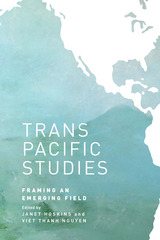 Transpacific Studies: Framing an Emerging Field
edited by Janet Hoskins and Viet Thanh Nguyen
University of Hawaii Press, 2014 The Pacific has long been a space of conquest, exploration, fantasy, and resistance. Pacific Islanders had established civilizations and cultures of travel well before European explorers arrived, initiating centuries of upheaval and transformation. The twentieth century, with its various wars fought in and over the Pacific, is only the most recent era to witness military strife and economic competition. While “Asia Pacific” and “Pacific Rim” were late twentieth-century terms that dealt with the importance of the Pacific to the economic, political, and cultural arrangements that span Asia and the Americas, a new term has arisen—the transpacific. In the twenty-first century, U.S. efforts to dominate the ocean are symbolized not only in the “Pacific pivot” of American policy but also the development of a Transpacific Partnership. This partnership brings together a dozen countries—not including China—in a trade pact whose aim is to cement U.S. influence. That pact signals how the transpacific, up to now an academic term, has reached mass consciousness.
Recognizing the increasing importance of the transpacific as a word and concept, this anthology proposes a framework for transpacific studies that examines the flows of culture, capital, ideas, and labor across the Pacific. These flows involve Asia, the Americas, and the Pacific Islands. The introduction to the anthology by its editors, Janet Hoskins and Viet Thanh Nguyen, consider the advantages and limitations of models found in Asian studies, American studies, and Asian American studies for dealing with these flows. The editors argue that transpacific studies can draw from all three in order to provide a critical model for considering the geopolitical struggle over the Pacific, with its attendant possibilities for inequality and exploitation. Transpacific studies also sheds light on the cultural and political movements, artistic works, and ideas that have arisen to contest state, corporate, and military ambitions. In sum, the transpacific as a concept illuminates how flows across the Pacific can be harnessed for purposes of both domination and resistance.
The anthology’s contributors include geographers (Brenda S. A. Yeoh, Weiqiang Lin), sociologists (Yen Le Espiritu, Hung Cam Thai), literary critics (John Carlos Rowe, J. Francisco Benitez, Yunte Huang, Viet Thanh Nguyen), and anthropologists (Xiang Biao, Heonik Kwon, Nancy Lutkehaus, Janet Hoskins), as well as a historian (Laurie J. Sears), and a film scholar (Akira Lippit). Together these contributors demonstrate how a transpacific model can be deployed across multiple disciplines and from varied locations, with scholars working from the United States, Singapore, Japan and England. Topics include the Cold War, the Chinese state, U.S. imperialism, diasporic and refugee cultures and economies, national cinemas, transpacific art, and the view of the transpacific from Asia. These varied topics are a result of the anthology’s purpose in bringing scholars into conversation and illuminating how location influences the perception of the transpacific. But regardless of the individual view, what the essays gathered here collectively demonstrate is the energy, excitement, and insight that can be generated from within a transpacific framework.
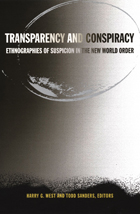 Transparency and Conspiracy: Ethnographies of Suspicion in the New World Order
Harry G. West and Todd Sanders, eds.
Duke University Press, 2003 Transparency has, in recent years, become a watchword for good governance. Policymakers and analysts alike evaluate political and economic institutions—courts, corporations, nation-states—according to the transparency of their operating procedures. With the dawn of the New World Order and the “mutual veil dropping” of the post–Cold War era, many have asserted that power in our contemporary world is more transparent than ever. Yet from the perspective of the relatively less privileged, the operation of power often appears opaque and unpredictable. Through vivid ethnographic analyses, Transparency and Conspiracy examines a vast range of expressions of the popular suspicion of power—including forms of shamanism, sorcery, conspiracy theory, and urban legends—illuminating them as ways of making sense of the world in the midst of tumultuous and uneven processes of modernization. In this collection leading anthropologists reveal the variations and commonalities in conspiratorial thinking or occult cosmologies around the globe—in Korea, Tanzania, Mozambique, New York City, Indonesia, Mongolia, Nigeria, and Orange County, California. The contributors chronicle how people express profound suspicions of the United Nations, the state, political parties, police, courts, international financial institutions, banks, traders and shopkeepers, media, churches, intellectuals, and the wealthy. Rather than focusing on the veracity of these convictions, Transparency and Conspiracy investigates who believes what and why. It makes a compelling argument against the dismissal of conspiracy theories and occult cosmologies as antimodern, irrational oversimplifications, showing how these beliefs render the world more complex by calling attention to its contradictions and proposing alternative ways of understanding it.
Contributors. Misty Bastian, Karen McCarthy Brown, Jean Comaroff, John Comaroff, Susan Harding, Daniel Hellinger, Caroline Humphrey, Laurel Kendall, Todd Sanders, Albert Schrauwers, Kathleen Stewart, Harry G. West
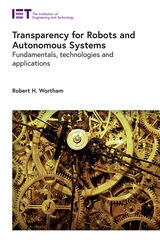 Transparency for Robots and Autonomous Systems: Fundamentals, technologies and applications
Robert H. Wortham
The Institution of Engineering and Technology, 2020 Based on scientific understanding and empirical evidence of how humans understand and interact with robotic and autonomous systems, the author reviews the concerns that have been raised around the deployment of AI and robots in human society, and the potential for disruption and harm. He explains why transparency ought to be a fundamental design consideration for Human Computer Interaction (HCI) and artificial intelligent systems. Starting with a survey of global research in the field and what transparency means in the wider context of trust, control and ethics, the author then introduces a transparent robot control architecture, and the impact of transparency using real-time displays. He presents a case study of a muttering robot, and covers current and upcoming standards for transparency, as well as future perspectives for the design, manufacture and operation of autonomous robotic systems.
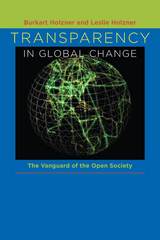 Transparency in Global Change: The Vanguard of the Open Society
Burkart Holzner
University of Pittsburgh Press, 2006 Transparency in Global Change examines the quest for information exchange in an increasingly international, open society. Recent transformations in governments and cultures have brought about a surge in the pursuit of knowledge in areas of law, trade, professions, investment, education, and medical practice—among others. Technological advancements in communications, led by the United States, and public access to information fuel the phenomenon of transparency. This rise in transparency parallels a diminution of secrecy—though, as Burkart and Leslie Holzner point out, secrecy continues to exist on many levels. Based on current events and historical references in literature and the social sciences, <I>Transparency in Global Change</I> focuses on the turning points of information cultures, such as scandals, that lead to pressure for transparency. Moreover, the Holzners illuminate byproducts of transparency—debate, insight, and impetus for change, as transparency exposes the moral corruptions of dictatorship, empire, and inequity.
Transparency in Population Forecasting: Methods for Fitting and Projecting Fertility, Mortality and Migration
Joop de Beer
Amsterdam University Press, 2011
To create an accurate population forecast, a forecaster can use a myriad of different methods to assemble his or her data. The transparency of the forecaster’s data and methods is essential, and the forecaster must be able to argue for and explain their assumptions. In this useful book, Joop de Beer specifically investigates how a population’s fertility, life expectancy, and migration patterns can be used to shape a population forecast. He also shows how comparative data, such as the difference between longevity in Europe and Japan, can be helpful when creating population projections.
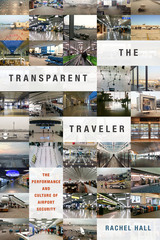 The Transparent Traveler: The Performance and Culture of Airport Security
Rachel Hall
Duke University Press, 2015 At the airport we line up, remove our shoes, empty our pockets, and hold still for three seconds in the body scanner. Deemed safe, we put ourselves back together and are free to buy the beverage we were prohibited from taking through security. In The Transparent Traveler Rachel Hall explains how the familiar routines of airport security choreograph passenger behavior to create submissive and docile travelers. The cultural performance of contemporary security practices mobilizes what Hall calls the "aesthetics of transparency." To appear transparent, a passenger must perform innocence and display a willingness to open their body to routine inspection and analysis. Those who cannot—whether because of race, immigration and citizenship status, disability, age, or religion—are deemed opaque, presumed to be a threat, and subject to search and detention. Analyzing everything from airport architecture, photography, and computer-generated imagery to full-body scanners and TSA behavior detection techniques, Hall theorizes the transparent traveler as the embodiment of a cultural ideal of submission to surveillance.
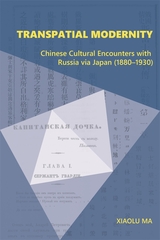 Transpatial Modernity: Chinese Cultural Encounters with Russia via Japan (1880–1930)
Xiaolu Ma
Harvard University Press, 2024 Transpatial Modernity offers the first in-depth account of the triangular relationship among Chinese, Japanese, and Russian literature and culture in the modern era. Drawing on primary sources in all three languages—among others—Xiaolu Ma reveals how Chinese writers translated and appropriated Russian cultural tropes through the intermediary of Japanese writing in the late nineteenth and early twentieth centuries. To trace the global journey of these literatures and ideas, Ma maps four case studies involving leading cultural figures including Leo Tolstoy, Futabatei Shimei, and Lu Xun. Together, they demonstrate the central role of relay transculturation—cultural exchange among at least three cultures, one of which serves primarily as an intermediary—as the key to understanding East Asian modernity. Not limited to a dyadic relationship between source and target culture, Transpatial Modernity explores the implications of cultural brokerage within complex transculturation process, thus establishing the value of a new transpatial framework for understanding literary and cultural exchange in local, regional, and global contexts.
TRANS(per)FORMING Nina Arsenault: An Unreasonable Body of Work
Edited by Judith Rudakoff
Intellect Books, 2012 Transgendered playwright, performer, columnist, and sex worker Nina Arsenault has undergone more than sixty plastic surgeries in pursuit of a feminine beauty ideal. In TRANS(per)FORMING Nina Arsenault, Judith Rudakoff brings together a diverse group of contributors, including artists, scholars, and Arsenault herself to offer an exploration of beauty, image, and the notion of queerness through the lens of Arsenault’s highly personal brand of performance art. Illustrated throughout with photographs of the artist’s transformation over the years and demonstrating her diversity of personae, this volume contributes to a deepening of our understanding of what it means to be a woman and what it means to be beautiful. Also included in this volume is the full script of Arsenault’s critically acclaimed stage play, The Silicone Diaries.
 Transplantation Ethics
Robert M. Veatch
Georgetown University Press, 2000 Three decades after the first heart transplant surgery stunned the world, organs including eyes, lungs, livers, kidneys, and hearts are transplanted every day. But despite its increasingly routine nature-or perhaps because of it-transplantation offers enormous ethical challenges. A medical ethicist who has been involved in the organ transplant debate for many years, Robert M. Veatch explores a variety of questions that continue to vex the transplantation community, offering his own solutions in many cases. Ranging from the most fundamental questions to recently emerging issues, Transplantation Ethics is the first complete and systematic account of the ethical and policy controversies surrounding organ transplants. Veatch structures his discussion around three major topics: the definition of death, the procurement of organs, and the allocation of organs. He lobbies for an allocation system-administered by nonphysicians-that considers both efficiency and equity, that takes into consideration the patient's age and previous transplant history, and that operates on a national rather than a regional level. Rich with case studies and written in an accessible style, this comprehensive reference is intended for a broad cross section of people interested in the ethics of transplantation from either the medical or public policy perspective: patients and their relatives, transplantation professionals, other health care professionals and administrators, social workers, members of organ procurement organizations, and government officials involved in the regulation of transplants.
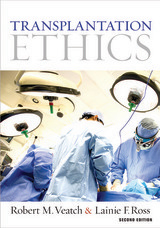 Transplantation Ethics: Second Edition
Robert M. Veatch and Lainie F. Ross
Georgetown University Press, 2015 Although the history of organ transplant has its roots in ancient Christian mythology, it is only in the past fifty years that body parts from a dead person have successfully been procured and transplanted into a living person. After fourteen years, the three main issues that Robert Veatch first outlined in his seminal study Transplantation Ethics still remain: deciding when human beings are dead; deciding when it is ethical to procure organs; and deciding how to allocate organs, once procured. However, much has changed. Enormous strides have been made in immunosuppression. Alternatives to the donation model are debated much more openly—living donors are used more widely and hand and face transplants have become more common, raising issues of personal identity. In this second edition of Transplantation Ethics, coauthored by Lainie F. Ross, transplant professionals and advocates will find a comprehensive update of this critical work on transplantation policies.
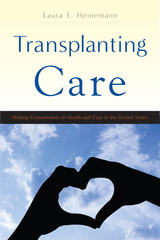 Transplanting Care: Shifting Commitments in Health and Care in the United States
Heinemann, Laura L.
Rutgers University Press, 2016 The sudden call, the race to the hospital, the high-stakes operation—the drama of transplant surgery is well known. But what happens before and after the surgery? In Transplanting Care, Laura L. Heinemann examines the daily lives of midwestern organ transplant patients and those who care for them, from pretransplant preparations through to the long posttransplant recovery. Heinemann points out that as efforts to control healthcare costs gain urgency—and as new surgical techniques, drug therapies, and home medical equipment advance—most of the transplant process now takes place at home, among kin. Indeed, the transplant system effectively depends on unpaid care labor, typically provided by spouses, parents, siblings, and others. Drawing on scores of interviews with patients, relatives, and healthcare professionals, Heinemann follows a variety of patients and loved ones as they undertake this uncertain and strenuous “transplant journey.” She also shows how these home-based caregiving efforts take place within the larger economic and political context of a paucity of resources for patients and caregivers, who ultimately must surmount numerous obstacles. The author concludes that the many snags encountered by transplant patients and loved ones make a clear case for more comprehensive health and social policy that treats care as a necessarily shared public responsibility. An illuminating look at the long transplant journey, Transplanting Care also offers broader insight into how we handle infirmity in America—and how we might do a better job of doing so.
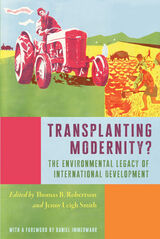 Transplanting Modernity?: New Histories of Poverty, Development, and Environment
Jenny Leigh Smith and Tom Robertson
University of Pittsburgh Press, 2020 Calls for an Honest Reckoning of the Successes, Failures, and Unanticipated Results of International Developments
In general, “development” denotes movement or growth toward something better in the future. International development—widespread in the decades following World War II—was an effort at purposeful change in landscapes around the world. Contributors to this volume argue that these projects constituted an effort to transplant modernity, such as knowledge or technology, from places seen as more developed to places perceived as un- or underdeveloped. During its heyday, international development included not just dams, roads, health programs, and agricultural projects but also animal husbandry schemes, urban development, and wildlife protection plans. Projects often succeeded or failed because of existing environmental conditions, and in turn, these programs remade—or tried to remake—the land, water, wildlife, and people around them. From American-directed failures in water engineering in Afghanistan to the impact of livestock epidemics on economic growth in East Africa, the chapters in Transplanting Modernity question how science, technology, and faith in Western notions of progress have influenced the pace, scope, and scale of development.
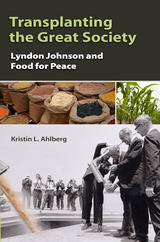 Transplanting the Great Society: Lyndon Johnson and Food for Peace
Kristin L. Ahlberg
University of Missouri Press, 2008
Enacted in 1954, the Food for Peace program allowed the United States to make agricultural surpluses available to needy nations but served varying political agendas. President Eisenhower saw it primarily as a temporary means for improving domestic agriculture prices, while his two Democratic successors turned it into the cornerstone of an expanded foreign assistance program.
Kristin Ahlberg traces the transformation of Public Law 480 from a means of liquidating domestic surplus into a vital component of U.S. foreign policy. She focuses on how Lyndon Johnson sought to re-create his Great Society reforms on a global scale by exporting programs designed to improve the lives of world citizens through combating food shortages—and how he also wielded Food for Peace as a diplomatic tool to gain support for U.S. policies and to reward or punish allies for their behavior.
LBJ sought to demonstrate America’s commitment to the less fortunate while providing a deterrent to those impoverished nations most vulnerable to communist influence, and the White House maintained control of the program’s objectives on a country-by-country basis while leaving its implementation to the bureaucracy. Ahlberg describes these foreign policy maneuvers as well as the domestic battles that found farm nationalists like Senator Allen Ellender opposing Johnson and Secretary of Agriculture Orville Freeman—and also found the Department of Agriculture, Department of State, and Agency for International Development vying for control of the program.
Ahlberg draws on recently declassified sources to show how the Johnson administration used Food for Peace to win diplomatic support for American policy in Vietnam, prevent nuclear proliferation on the Indian subcontinent, and uphold Israeli security. When India diverted resources from agriculture to arms, Washington suspended wheat shipments until New Delhi reordered its priorities. But in the case of Israel and South Vietnam, LBJ used food aid to help client governments build up their militaries—as well as to win the “hearts and minds” of the Vietnamese people.
Transplanting the Great Society is an insightful study that shows the successes and limitations of using food aid as a diplomatic tool during the middle period of the cold war. It paints a broader picture of Johnson’s foreign policies, opening a new window on both his administration and postwar diplomatic history.
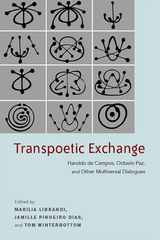 Transpoetic Exchange: Haroldo de Campos, Octavio Paz, and Other Multiversal Dialogues
Marília Librandi
Bucknell University Press, 2020 Transpoetic Exchange illuminates the poetic interactions between Octavio Paz (1914-1998) and Haroldo de Campos (1929-2003) from three perspectives--comparative, theoretical, and performative. The poem Blanco by Octavio Paz, written when he was ambassador to India in 1966, and Haroldo de Campos’ translation (or what he calls a “transcreation”) of that poem, published as Transblanco in 1986, as well as Campos’ Galáxias, written from 1963 to 1976, are the main axes around which the book is organized.
The volume is divided into three parts. “Essays” unites seven texts by renowned scholars who focus on the relationship between the two authors, their impact and influence, and their cultural resonance by exploring explore the historical background and the different stylistic and cultural influences on the authors, ranging from Latin America and Europe to India and the U.S. The second section, “Remembrances,” collects four experiences of interaction with Haroldo de Campos in the process of transcreating Paz’s poem and working on Transblanco and Galáxias. In the last section, “Poems,” five poets of international standing--Jerome Rothenberg, Antonio Cicero, Keijiro Suga, André Vallias, and Charles Bernstein.
Paz and Campos, one from Mexico and the other from Brazil, were central figures in the literary history of the second half of the 20th century, in Latin America and beyond. Both poets signal the direction of poetry as that of translation, understood as the embodiment of otherness and of a poetic tradition that every new poem brings back as a Babel re-enacted.
This volume is a print corollary to and expansion of an international colloquium and poetic performance held at Stanford University in January 2010 and it offers a discussion of the role of poetry and translation from a global perspective. The collection holds great value for those interested in all aspects of literary translation and it enriches the ongoing debates on language, modernity, translation and the nature of the poetic object.
Published by Bucknell University Press. Distributed worldwide by Rutgers University Press.
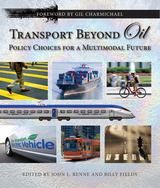 Transport Beyond Oil: Policy Choices for a Multimodal Future
Edited by John L. Renne and Billy Fields, Foreword by Gilbert E. Carmichael
Island Press, 2012 Seventy percent of the oil America uses each year goes to transportation. That means that the national oil addiction and all its consequences, from climate change to disastrous spills to dependence on foreign markets, can be greatly reduced by changing the way we move. In Transport Beyond Oil, leading experts in transportation, planning, development, and policy show how to achieve this fundamental shift.
The authors demonstrate that smarter development and land-use decisions, paired with better transportation systems, can slash energy consumption. John Renne calculates how oil can be saved through a future with more transit-oriented development. Petra Todorovitch examines the promise of high-speed rail. Peter Newman imagines a future without oil for car-dependent cities and regions. Additional topics include funding transit, freight transport, and nonmotorized transportation systems. Each chapter provides policy prescriptions and their measurable results.
Transport Beyond Oil delivers practical solutions, based on quantitative data. This fact-based approach offers a new vision of transportation that is both transformational and achievable.
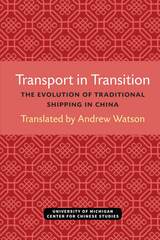 Transport in Transition: The Evolution of Traditional Shipping in China
Translated by Andrew Watson
University of Michigan Press, 1972 Water transport is a major feature of the traditional Chinese economy because of its magnitude and comparative efficiency. Yet this feature has all too often been ignored by scholars, with the notable exception of Japanese scholars. We cannot hope to gain any real conception of how the Chinese economy worked in the past, or works now, until we have a clearer picture of the circulation of men and commodities. In this circulation, water transport has been and is of crucial importance. Transport in Transition collects and translates notable Japanese articles to throw some light on the evolution of traditional junk shipping during a key transitional phase, 1900–1940, when it was absorbing the influences of various forms of modernization and on the eve of its major organizational transformation under the direction of the Communisty Party. The articles chosen concentrate on two main themes: the institutional organization of the shipping business, and the forms of ownership and operation. They will be of value to business historians and economic sociologists generally as well as to economic historians interested in transport. Several features of the Chinese economy are sharply illuminated. Most striking is the extent of regional variation. North and central Chinese shipping are shown to have differed both in their methods of operaiton and organization. Also noteworthy is the enduring strength of some traditional features of shipping operation and business practice. An unexpected feature of this endurance was the strength of traditional shipping in the face of steady competition from all forms of modern transport and from reputdely more efficient forms of business management.
|
|


